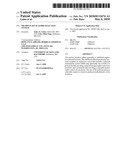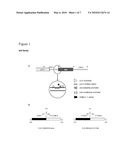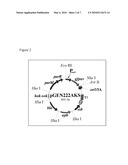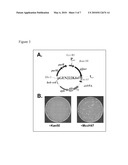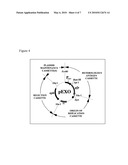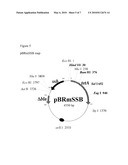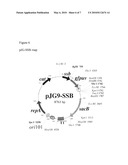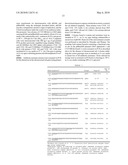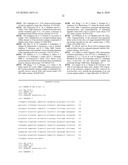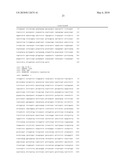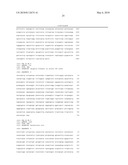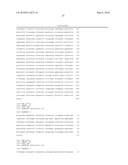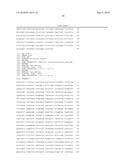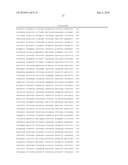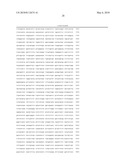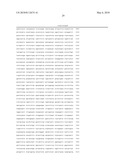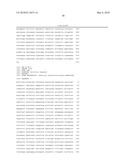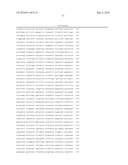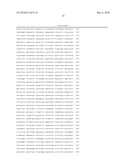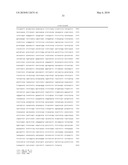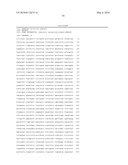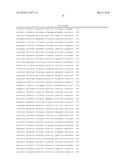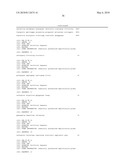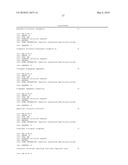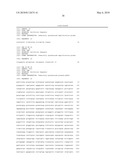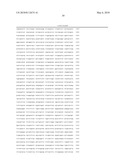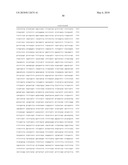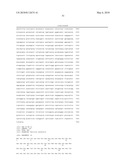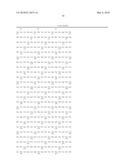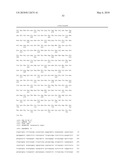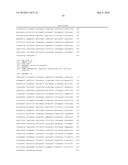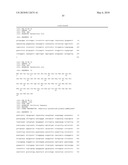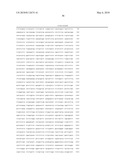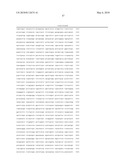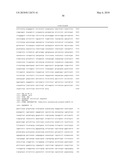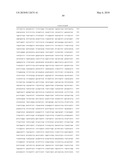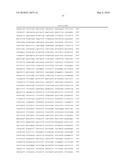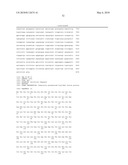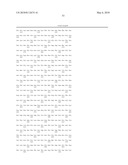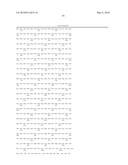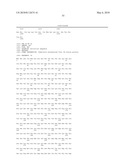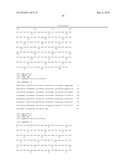Patent application title: MICROCIN H47 PLASMID SELECTION SYSTEM
Inventors:
James E. Galen (Sykesville, MD, US)
Chee-Mun Fang (Baltimore, MD, US)
Assignees:
UNIVERSITY OF MAYLAND, BALTIMORE
IPC8 Class: AC12N1563FI
USPC Class:
43525233
Class name: Bacteria or actinomycetales; media therefor transformants (e.g., recombinant dna or vector or foreign or exogenous gene containing, fused bacteria, etc.) escherichia (e.g., e. coli, etc.)
Publication date: 2010-05-06
Patent application number: 20100112674
Claims:
1. An expression vector comprising a nucleotide sequence encoding:(a) a
restricted-copy-number origin of replication cassette comprising(i) a
nucleotide sequence encoding an origin of replication that limits the
expression vector to an average plasmid copy number of about 2 to 75
copies per cell,(ii) a first unique restriction enzyme cleavage site
located 5' of the nucleotide sequence encoding the origin of replication,
and(iii) a second unique restriction enzyme cleavage site located 3' of
the nucleotide sequence encoding the origin of replication;(b) at least
one post-segregational killing cassette comprising(i) a nucleotide
sequence encoding at least one post-segregational killing locus,(ii) a
third unique restriction enzyme cleavage site located 5' of the
nucleotide sequence encoding the at least one post-segregational killing
locus, and(iii) a fourth unique restriction enzyme cleavage site located
3' of the nucleotide sequence encoding the at least one
post-segregational killing locus;(c) at least one partitioning cassette
comprising(i) a nucleotide sequence encoding at least one partitioning
function,(ii) a fifth unique restriction enzyme cleavage site 5' of the
nucleotide sequence encoding the at least one partitioning function,
and(iii) a sixth unique restriction enzyme cleavage site located 3' of
the nucleotide sequence encoding the at least one partitioning function;
and(d) at least one selectable marker cassette comprising(i) a nucleotide
sequence encoding at least one selectable marker, wherein said selectable
marker is the E. coli polypeptide mchI having the amino acid sequence set
forth in SEQ ID NO:30(ii) a seventh unique restriction enzyme cleavage
site located 5' of the nucleotide sequence encoding the at least one
selectable marker, and(iii) a eighth unique restriction enzyme cleavage
site located 3' of the nucleotide sequence encoding the at least one
selectable marker.
2. The expression vector of claim 1, wherein the nucleotide sequence encoding an origin of replication is a nucleotide sequence selected from the group consisting of the oriE1 sequence set forth in SEQ ID NO:1, the ori101 sequence set forth in SEQ ID NO:3, and the ori15A sequence set forth in SEQ ID NO:2.
3. The expression vector of claim 1, wherein the nucleotide sequence encoding at least one post-segregational killing locus is a nucleotide sequence selected from the group consisting of a nucleotide sequence encoding the ssb post-segregational killing locus, a nucleotide sequence encoding the asd balanced-lethal system, a nucleotide sequence encoding the phd-doc proteic system, and a nucleotide sequence encoding the hok-sok antisense system.
4. The expression vector of claim 1, wherein said nucleotide sequence encoding at least one post-segregational killing locus is a nucleotide sequence encoding the ssb post-segregational killing locus.
5. The expression vector of claim 4, wherein said ssb post-segregational killing locus comprises a ssb inducible promoter, a ssb constitutive promoter and a ssb coding region, and wherein said locus is the ssb post-segregational killing locus from a member selected from the group consisting of Shigella flexneri, Salmonella typhi and E. coli.
6. The expression vector of claim 4, wherein said ssb post-segregational killing locus comprises the ssb inducible promoter, the ssb constitutive promoter and the ssb coding region of Shigella flexneri 2a strain CVD 1208s as set forth in SEQ ID NO:4.
7. The expression vector of claim 1, wherein the nucleotide sequence encoding at least one post-segregational killing locus is a homolog of a ssb post-segregational killing locus, wherein said homolog has at least 90% identity over its entire length to the ssb post-segregational killing locus set forth in SEQ ID NO:4, wherein both the inducible and constitutive promoters of said homolog have promoter activity, and wherein the SSB polypeptide encoded by said homolog has DNA binding and DNA replication activity.
8. The expression vector of claim 1, wherein the partitioning function is an active partitioning function.
9. The expression vector of claim 1, wherein the nucleotide sequence encoding at least one partitioning function comprises Escherichia coli parA set forth in SEQ ID NO:5.
10. The expression vector of claim 1, wherein the nucleotide sequence encoding at least one partitioning function is the par locus of Escherichia coli pSC101 set forth in SEQ ID NO:6.
11. The expression vector of claim 1, wherein the average plasmid copy-number is about 5 to about 60 copies per cell.
12. The expression vector of claim 1, further comprising(e) an expression cassette comprising(i) a nucleotide sequence encoding a promoter,(ii) a ninth unique restriction enzyme cleavage site located 5' of the nucleotide sequence encoding the promoter, and(iii) a tenth unique restriction enzyme cleavage site located 3' of the nucleotide sequence encoding the promoter.
13. The expression vector of claim 12, wherein the promoter (e)(i) is an inducible promoter.
14. The expression vector of claim 13, wherein the promoter (e)(i) is an ompC promoter.
15. The expression vector of claim 13, wherein the promoter (e)(i) is the ompC promoter set forth in SEQ ID NO:7.
16. The expression vector of claim 12, wherein said expression cassette (e) further comprises a nucleotide sequence encoding an antigen positioned at the 3' end of the nucleotide sequence encoding promoter (e)(i), wherein expression of said antigen is under control of said promoter (e)(i).
17. The expression vector of claim 16, wherein the antigen is selected from the group consisting of a viral antigen, a bacterial antigen, a cancer antigen, and an auto-immune antigen.
18. The expression vector of claim 16, wherein the antigen is selected from the group consisting of a domain of the anthrax toxin Protective Antigen PA83 moiety, full-length PA83 or the 63 kDa biologically active form of PA83.
19. The expression vector of claim 17, wherein the antigen is domain 4 of the anthrax toxin Protective Antigen PA83 set forth in SEQ ID NO:36.
20. The expression vector of claim 16, wherein the antigen is one or more fragments of a Clostridium botulinum neurotoxin eukaryotic cell-binding heavy chain, wherein said heavy chain is a heavy chain of a Clostridium botulinum serotype selected from the group consisting of Clostridium botulinum serotypes A, B, C, D, E, F and G.
21. An isolated cell comprising the expression vector of claim 1.
22. The isolated cell of claim 21, wherein the isolated cell is a bacterial cell.
23. The isolated cell of claim 22, wherein the isolated cell is a Salmonella Typhi cell.
24. The isolated cell of claim 21, wherein the isolated cell is a cell of a bacterial strain selected from the group consisting of Shigella flexneri 2a strain CVD 1208s, Salmonella enterica serovar Typhi strain CVD 908-htrA, Salmonella enterica serovar Typhi strain CVD 909, and E. coli strain DH5 alpha.
25. The isolated cell of claim 22, wherein the endogenous ssb gene of said bacterial cell is inactivated or deleted.
26. The isolated cell of claim 23, wherein the endogenous ssb gene of said Salmonella Typhi cell is inactivated or deleted.
27. The isolated cell of claim 24, wherein the endogenous ssb gene of said cell of a bacterial strain is inactivated or deleted.
28. The isolated cell of claim 23, wherein said cell is Salmonella enterica serovar Typhi strain CVD 908-htrAssb.
Description:
BACKGROUND OF THE INVENTION
[0002]Bacterial live vector vaccines represent a vaccine development strategy that offers exceptional flexibility. With this approach, genes that encode protective antigens of unrelated bacterial, viral or parasitic pathogens are expressed in an attenuated bacterial vaccine strain that delivers these foreign antigens to the immune system, thereby eliciting a relevant immune response.
[0003]With the advent of powerful recombinant bioengineering techniques, it is now possible to genetically attenuate pathogenic bacteria to create safe and immunogenic live oral vaccines. Bacterial live vectors include attenuated enteric pathogens (e.g., Salmonella enterica, Shigella, Vibrio cholerae)2, 20, 21, 64, 84, 89, commensals (e.g., Lactobacillus, Streptococcus gordonii)62, 113 and licensed vaccine strains (e.g., BCG)29.
[0004]Such vaccines can be additionally engineered to express protective antigens from unrelated human pathogens, creating multivalent live vector vaccine strains. Typically, these foreign proteins are expressed within live vectors from multicopy expression plasmids that do not encode transfer functions and are not considered to be self-transmissible. Two fundamental lessons are becoming clear in live vector vaccinology: 1) multicopy expression plasmids can provide a gene dosage effect to enhance the level of expression of foreign antigens, and 2) in order to achieve enhanced immunogenicity from a gene dosage effect in live vectors, these multicopy plasmids must be genetically stabilized, particularly if expression of the foreign antigens metabolically stresses the live vector.
[0005]Antibiotic resistance markers are usually inserted into expression plasmids for selection purposes after introduction of plasmids into live vectors. Until recently, these resistance markers were considered to pose no risk for complicating or causing failure of clinical antimicrobial treatments for three important reasons: 1) the expression plasmids (and accompanying resistance markers) could not be efficiently mobilized from live vector donors to a recipient52, 2) the plasmid markers used encoded resistance to antibiotics not in widespread medical use, and 3) with no relevant antibiotic selective pressure, even rare plasmid transfers would not lead to de novo resistance becoming established within a new bacterial population52.
[0006]However, a growing body of evidence now clearly points to an inherent plasticity in the bacterial genome of intestinal microbes that allows rapid adaptation to environmental pressures using a striking variety of genetic mechanisms13, 43, 86. Indeed, intestinal bacteria have been proposed to act as a reservoir for mobile resistance cassettes and associated genes of metabolic importance, which cannot only be exchanged and maintained between resident flora of intestinal biofilms55, but might also be acquired or horizontally transferred to various genera of bacteria passing through the colon87. Examples of unexpected gene mobilization have recently been documented that challenge conventional thinking in bacterial genetics.
[0007]In elegant experiments designed to examine plasmid dynamics in biofilms, Maeda et al.58,59 demonstrated the rapid transfer of a common multicopy pUC-like plasmid from a laboratory Escherichia coli K-12 DH5α strain to a recipient E. coli strain in the absence of antibiotic selection or any known fertility factors, R-factors, or other recognized conjugation or transduction functions. It was hypothesized that in situ horizontal transfer of plasmids occurred as DNA was released from dead and lysing "donor" bacteria and transferred into recipient bacteria by an unknown mechanism. Another unexpected example of in situ horizontal transfer was described by Ferguson et al.31, where conjugative plasmids were observed to be mobilized intracellularly at high frequency between Salmonella enterica strains residing within epithelial cell membrane-bound vacuoles. The frequency of plasmid transfer by conjugation was shown to be dependent on the probability of coinfection of the same epithelial cell by both donor and recipient; intracellular recombinants appeared by three hours after donor invasion and accumulated steadily over time. The authors posed the intriguing possibility of horizontal gene transfer between unrelated species of intracellular bacteria residing in the same target cell. Such examples clearly reveal the unexpected mobility of plasmids within a bacterial community, even in the absence of recognized selective pressures.
[0008]Genes encoding resistance to kanamycin (and the closely related antibiotic neomycin) have become the markers of choice for selection of recombinant plasmid DNA intended for use in human vaccines. These antimicrobials are used only occasionally in treatments of the gastrointestinal tract prior to elective colon surgery to avoid post-operative infection54, 88. Therefore, lack of routine clinical use of these antibiotics argues against selection and propagation of recombinant plasmids amongst intestinal bacteria. However, such reasoning does not hold up when applied to other bacterial ecosystems where sustained drug selection of resistance markers is not expected, such as amongst soil-borne microorganisms. A surprising diversity of stable resistance genes has now been documented in soil-dwelling bacteria with no obvious environmental exposure to antimicrobials25. It has been suggested that plasmid maintenance functions accompanying resistance genes provide a mechanism for persistence of these and other unrelated genes in the absence of selection91. Indeed, such maintenance systems have been intentionally engineered into expression plasmids carried by live vectors to enhance plasmid stability in vivo in the absence of drug selection37. Given the inherent unpredictability of plasmid mobilization between enteric strains, and the possibility of stable propagation in the absence of selection, the prospect of unintended and unforeseen genetic events compromising critical antimicrobial therapies cannot be formally excluded. Such risk is therefore unacceptable if alternatives to antibiotic selection can be developed.
[0009]Thus, there exists a need for non-antibiotic selection systems for live vector expression plasmids.
SUMMARY OF THE INVENTION
[0010]The present invention relates generally to stabilized expression plasmid systems. The stabilized expression plasmid systems comprise an expression vector that includes a plasmid maintenance system (PMS) and, optionally, one or both of a polynucleotide encoding a selected antigen under control of a promoter, and a polynucleotide encoding a selectable marker under control of a promoter. The PMS includes (a) an origin of replication, (b) at least one post-segregational killing function, and (c) at least one partitioning function.
[0011]In one embodiment, the present invention includes an expression vector comprising a nucleotide sequence encoding:
[0012](a) a restricted-copy-number origin of replication cassette comprising a nucleotide sequence encoding an origin of replication,
[0013](b) at least one post-segregational killing cassette comprising a nucleotide sequence encoding at least one post-segregational killing locus,
[0014](c) at least one partitioning cassette comprising a nucleotide sequence encoding at least one partitioning function; and
[0015](d) at least one selectable marker cassette comprising a nucleotide sequence encoding at least one selectable marker.
[0016]In a preferred embodiment, the nucleotide sequence (a) encoding an origin of replication limits the expression vector to an average plasmid copy number of about 2 to 75 copies per cell. Further, a first unique restriction enzyme cleavage site is located 5' of the nucleotide sequence encoding the origin of replication, and a second unique restriction enzyme cleavage site is located 3' of the nucleotide sequence encoding the origin of replication.
[0017]Also in the preferred embodiment, the nucleotide sequence (b) encoding at least one post-segregational killing locus comprises a third unique restriction enzyme cleavage site located 5' of the nucleotide sequence encoding the at least one post-segregational killing locus, and a fourth unique restriction enzyme cleavage site located 3' of the nucleotide sequence encoding the at least one post-segregational killing locus.
[0018]Further in the preferred embodiment, the nucleotide sequence encoding at least one partitioning function comprises a fifth unique restriction enzyme cleavage site 5' of the nucleotide sequence encoding the at least one partitioning function, and a sixth unique restriction enzyme cleavage site located 3' of the nucleotide sequence encoding the at least one partitioning function.
[0019]Additionally in the preferred embodiment, the nucleotide sequence encoding at least one selectable marker is a nucleotide sequence encoding the E. coli polypeptide mchI having the amino acid sequence set forth in SEQ ID NO:30. Furthermore, a seventh unique restriction enzyme cleavage site is located 5' of the nucleotide sequence encoding the at least one selectable marker, and an eighth unique restriction enzyme cleavage site is located 3' of the nucleotide sequence encoding the at least one selectable marker, wherein the at least one selectable markers is a mchI protein
[0020]In a preferred embodiment, the present invention includes an expression vector comprising a nucleotide sequence encoding:
[0021](a) a restricted-copy-number origin of replication cassette comprising [0022](i) a nucleotide sequence encoding an origin of replication that limits the expression vector to an average plasmid copy number of about 2 to 75 copies per cell, [0023](ii) a first unique restriction enzyme cleavage site located 5' of the nucleotide sequence encoding the origin of replication, and [0024](iii) a second unique restriction enzyme cleavage site located 3' of the nucleotide sequence encoding the origin of replication;
[0025](b) at least one post-segregational killing cassette comprising [0026](i) a nucleotide sequence encoding at least one post-segregational killing locus, [0027](ii) a third unique restriction enzyme cleavage site located 5' of the nucleotide sequence encoding the at least one post-segregational killing locus, and [0028](iii) a fourth unique restriction enzyme cleavage site located 3' of the nucleotide sequence encoding the at least one post-segregational killing locus;
[0029](c) at least one partitioning cassette comprising [0030](i) a nucleotide sequence encoding at least one partitioning function, [0031](ii) a fifth unique restriction enzyme cleavage site 5' of the nucleotide sequence encoding the at least one partitioning function, and [0032](iii) a sixth unique restriction enzyme cleavage site located 3' of the nucleotide sequence encoding the at least one partitioning function; and
[0033](d) at least one selectable marker cassette comprising [0034](i) a nucleotide sequence encoding at least one selectable marker, wherein the selectable marker is the E. coli polypeptide mchI having the amino acid sequence set forth in SEQ ID NO:30 [0035](ii) a seventh unique restriction enzyme cleavage site located 5' of the nucleotide sequence encoding the at least one selectable marker, and [0036](iii) a eighth unique restriction enzyme cleavage site located 3' of the nucleotide sequence encoding the at least one selectable marker, wherein the at least one selectable markers is a mchI protein.
[0037]In preferred embodiments of the expression vectors of the present invention, the nucleotide sequence encoding an origin of replication is a nucleotide sequence selected from the group consisting of the oriE1 sequence set forth in SEQ ID NO:1, the ori101 sequence set forth in SEQ ID NO:3, and the ori15A sequence set forth in SEQ ID NO:2.
[0038]In preferred embodiments of the expression vectors of the present invention, the nucleotide sequence encoding at least one post-segregational killing locus is a nucleotide sequence selected from the group consisting of a nucleotide sequence encoding the ssb post-segregational killing locus, a nucleotide sequence encoding the asd balanced-lethal system, a nucleotide sequence encoding the phd-doc proteic system, and a nucleotide sequence encoding the hok-sok antisense system. More preferably, the nucleotide sequence encoding at least one post-segregational killing locus is a nucleotide sequence encoding the ssb post-segregational killing locus.
[0039]In preferred embodiments of the expression vectors of the present invention, the ssb post-segregational killing locus comprises a ssb inducible promoter, a ssb constitutive promoter and a ssb coding region, and the ssb post-segregational killing locus is the ssb post-segregational killing locus from Shigella flexneri, Salmonella typhi or E. coli.
[0040]In a preferred embodiment of the expression vectors of the present invention, the ssb post-segregational killing locus comprises the ssb inducible promoter, the ssb constitutive promoter and the ssb coding region of Shigella flexneri 2a strain CVD 1208s as set forth in SEQ ID NO:4.
[0041]In preferred embodiments of the expression vectors of the present invention, the nucleotide sequence encoding the at least one post-segregational killing locus is a homolog of a ssb post-segregational killing locus, wherein the homolog has at least 90% identity over its entire length to the ssb post-segregational killing locus set forth in SEQ ID NO:4, wherein both the inducible and constitutive promoters of the homolog have promoter activity, and wherein the SSB polypeptide encoded by the homolog has DNA binding and DNA replication activity.
[0042]In preferred embodiments of the expression vectors of the present invention, the partitioning function is an active partitioning function.
[0043]In preferred embodiments of the expression vectors of the present invention, the nucleotide sequence encoding at least one partitioning function comprises Escherichia coli parA set forth in SEQ ID NO:5.
[0044]In preferred embodiments of the expression vectors of the present invention, the nucleotide sequence encoding at least one partitioning function is the par locus of Escherichia coli pSC101 set forth in SEQ ID NO:6.
[0045]In preferred embodiments of the expression vectors of the present invention, the average plasmid copy-number is about 5 to about 60 copies per cell.
[0046]In preferred embodiments of the expression vectors of the present invention, the expression further comprises an expression cassette comprising a nucleotide sequence encoding a promoter. The expression cassette may have a ninth unique restriction enzyme cleavage site located 5' of the nucleotide sequence encoding the promoter, and a tenth unique restriction enzyme cleavage site located 3' of the nucleotide sequence encoding the promoter. Preferably the promoter is an inducible promoter, more preferably the promoter is an ompC promoter, even more preferably the promoter is the ompC promoter set forth in SEQ ID NO:7.
[0047]In preferred embodiments of the expression vectors of the present invention where the expression vector further comprises an expression cassette, the expression cassette further comprises a nucleotide sequence encoding an antigen positioned at the 3' end of the nucleotide sequence encoding the promoter of the expression cassette, wherein expression of the antigen is under control of the promoter of the expression cassette. Preferably the antigen is a viral antigen, a bacterial antigen, a cancer antigen, or an auto-immune antigen. More preferably, the antigen is a domain of the anthrax toxin Protective Antigen PA83 moiety, full-length PA83 or the 63 kDa biologically active form of PA83. Even more preferably, the antigen is domain 4 of the anthrax toxin Protective Antigen PA83 set forth in SEQ ID NO: 36.
[0048]In other preferred embodiments the antigen may be one or more fragments of a Clostridium botulinum neurotoxin eukaryotic cell-binding heavy chain, wherein the heavy chain is a heavy chain of a Clostridium botulinum serotype selected from the group consisting of Clostridium botulinum serotypes A, B, C, D, E, F and G.
[0049]The present invention further includes a cell comprising one or more of the expression vectors described herein. Preferably, the cell is an isolated cell, and is a bacterial cell. Preferably the bacterial cell is a Salmonella Typhi cell or a cell of a bacterial strain selected from the group consisting of Shigella flexneri 2a strain CVD 1208s, Salmonella enterica serovar Typhi strain CVD 908-htrA, Salmonella enterica serovar Typhi strain CVD 909, and E. coli strain DH5 alpha.
[0050]In preferred embodiments, the endogenous ssb gene of the cell comprising one or more of the expression vectors of the present invention is inactivated or deleted. Preferably, the cell is a bacterial cell where the endogenous ssb gene is inactivated or deleted. More preferably, the cell is a Salmonella Typhi cell where the endogenous ssb gene is inactivated or deleted. Even more preferably, the cell is Salmonella enterica serovar Typhi strain CVD 908-htrAssb.
BRIEF DESCRIPTION OF THE DRAWINGS
[0051]FIG. 1A: diagrammatic representation of the uvrA and ssb genes and control regions. FIG. 1B: ligated products from amplification of control and coding regions of ssb gene.
[0052]FIG. 2: genetic map of pGEN222AKS
[0053]FIG. 3A: genetic map of pGEN222 Kh47. FIG. 3B: results of DH5α(pGEN222 Kh47) transformants selected on LB plates containing either 50 μg/ml kanamycin (+Kan50) or microcin H47 (+MccH47).
[0054]FIG. 4: genetic map of pEXO
[0055]FIG. 5: genetic map of pBRmSSB. The sequence of pBRmSSB is set forth in SEQ ID NO:10.
[0056]FIG. 6: genetic map of pJG9-SSB, a temperature-sensitive replicon derived from pSC101 carrying ssb, gfpuv, the cat chloramphenicol resistance allele, and the counterselectable marker sacB. The sequence of pJG9-SSB is set forth in SEQ ID NO:8.
[0057]FIG. 7: growth inhibition of DH5α(pGEN222) and 908-htrA(pGEN222) in the presence of MccH47.
DETAILED DESCRIPTION OF THE INVENTION
[0058]The present invention relates generally to stabilized expression plasmid systems. The stabilized expression plasmid systems comprise an expression vector that includes a plasmid maintenance system (PMS) which serves to optimize the maintenance of the expression vector in bacteria at two independent levels by: (1) removing dependence on balanced lethal maintenance systems that utilize enzymes with catalytic activity; and (2) incorporating a plasmid partition system to prevent random segregation of expression vectors, thereby enhancing inheritance and stability of the plasmids.
[0059]Embodiments of the stabilized expression plasmid systems of the present invention include expression vectors comprising a polynucleotide encoding a selected antigen under control of a promoter, in addition to the PMS.
[0060]In another embodiment, the expression vector comprises a polynucleotide encoding a selectable marker, such as a temperature sensitive marker, a drug resistance marker or an antimicrobial peptide, in addition to the PMS. In an equally preferred embodiment, the expression vector comprises both (i) a polynucleotide encoding a selected antigen under control of a promoter and (ii) a polynucleotide encoding a selectable marker, in addition to the PMS.
[0061]The PMS includes (a) an origin of replication, (b) at least one post-segregational killing function, and (c) at least one partitioning function.
[0062]The present invention also generally relates to bacterial live vector vaccines, comprising bacteria transfected with a stabilized expression plasmid system of the present invention, and methods of making and using bacterial live vector vaccines. The bacterial live vector vaccines of the present invention can be used to induce an immune response to the bacteria itself, or to induce an immune response to the selected antigen expressed by the bacteria, or both.
A. STABILIZED EXPRESSION PLASMID SYSTEM
[0063]The stabilized expression plasmid systems of the present invention are based on expression vectors genetically engineered to comprise a PMS, and optionally a polynucleotide encoding a selected antigen under control of a promoter, or a polynucleotide encoding a selectable marker, or both.
[0064]The PMS includes (a) an origin of replication, (b) at least one post-segregational killing function, and (c) at least one partitioning function.
[0065]1. Origin of Replication
[0066]The PMS includes a restricted-copy-number origin of replication that limits the expression vector to a range of plasmid copies per cell. Due to varying degrees of toxicity associated with different selected antigens (e.g., higher toxicity for antigens derived from parasitic organisms such Plasmodium falciparum versus virtually no toxicity for the fragment C of tetanus toxin), the stabilized expression plasmid system of the present invention is based on either a low or medium copy number expression vector (plasmid). It will be appreciated by one skilled in the art that the selection of an origin of replication will depend on the degree of toxicity, i.e., the copy number should go down as toxicity to the bacterial strain goes up.
[0067]The origins of replication of the present invention includes both naturally-occurring origins of replication, as well as origins of replication encoded by nucleotide sequences which are substantially homologous to nucleotide sequences encoding naturally-occurring origins of replication, and which retain the function and activity exhibited by the naturally-occurring origins of replication.
[0068]It is preferable for the origin of replication to confer an average copy number which is between about 2 and about 75 copies per cell, between about 5 and about 60 copies per cell, between about 5 to about 30 copies per cell, or between about 5 to about 15 copies per cell. Preferred origins of replication include those of E. coli plasmid pAT153 (oriE1, ˜60 copies per chromosomal equivalent), the E. coli plasmid pACYC184 (ori15A, ˜15 copies per chromosomal equivalent), and the Salmonella typhimurium plasmid pSC101 (ori101, ˜5 copies per chromosomal equivalent). Substantial homologs of oriE1, ori15A and ori101 having the same function and activity as the unaltered origins of replication may also be used.
[0069]In preferred embodiments, the nucleotide sequence encoding the origin of replication is a nucleotide sequence selected from the group consisting of the oriE1 sequence of SEQ ID NO:1, the ori101 sequence of SEQ ID NO:3, and the ori15A sequence of SEQ ID NO:2. Substantial homologs of the origins of replication of SEQ ID NOs:1-3, having the same function and activity as the origins of replication of SEQ ID NOs:1-3, may also be used.
[0070]In a further preferred embodiment, the origin of replication is the oriE1 locus from pSC101, conferring a copy number of approximately 5 copies per genome equivalent, set forth in SEQ ID NO:1.
[0071]2. Partitioning Function
[0072]The PMS also includes a partitioning function, also known in the art and herein as a "segregating system" and a "partitioning system." The partitioning function is any plasmid stability-enhancing function that operates to increase the frequency of successful delivery of a plasmid to each newly divided bacterial cell, as compared to the frequency of delivery of a corresponding plasmid without such a function. Partitioning systems include, for example, equi-partitioning systems, pair-site partitioning systems, and the systems provided in Table 1 of Chapter 5, Partition Systems of Bacterial Plasmids. B. E. Funnell and R. A. Slavcev. In Plasmid Biology. 2004. B E Funnell and G J Phillips, eds. ASM Press, Washington, D.C.
[0073]The partitioning systems of the present invention includes both naturally-occurring partitioning systems, as well as partitioning systems encoded by nucleotide sequences which are substantially homologous to nucleotide sequences encoding naturally-occurring partitioning systems, and which retain the function and activity exhibited by the naturally-occurring partitioning systems.
[0074]Exemplary partitioning functions include, without limitation, those provided by systems of pSC101, the F factor, the P1 prophage, and IncFII drug resistance plasmids.
[0075]In particular, the par passive partitioning locus can be used. The function of the par locus appears to be related to increasing plasmid supercoiling at the origin of replication, which is also the binding site for DNA gyrase. An exemplary par sequence is that of E. coli, set forth in SEQ ID NO:6 (Miller et al., Nucleotide sequence of the partition locus of Escherichia coli plasmid pSC101, Gene 24:309-15 (1983); GenBank accession no. X01654, nucleotides 4524-4890)).
[0076]The active partitioning parA locus may also be used. An exemplary parA locus sequence is set forth in SEQ ID NO:5. Substantial homologs of the partitioning loci of SEQ ID NOs:5 and 6, having the same function and activity as the partitioning loci of SEQ ID NOs:5 and 6, may also be used.
[0077]3. Post-Segregational Killing Function
[0078]The PMS further includes at least one post-segregational killing (PSK) function. The PSK function is a function which results in the death of any newly divided bacterial cell which does not inherit the plasmid of interest, and specifically includes balanced-lethal systems such as asd or ssb, proteic systems such as phd-doc, antisense systems such as hok-sok, and polynucleotides encoding antimicrobial peptides such as colicins and microcins.
[0079]The PSK function of the present invention includes both naturally-occurring PSK functions, as well as PSK functions encoded by nucleotide sequences which are substantially homologous to nucleotide sequences encoding naturally-occurring PSK functions, and which retain the function and activity exhibited by the naturally-occurring PSK functions.
[0080]In preferred embodiments, the PSK function is the ssb balanced lethal system. The single-stranded binding protein (SSB) from S. Typhi is used to trans-complement an otherwise lethal mutation introduced into the chromosomal ssb gene. The biochemistry and metabolic roles of the E. coli SSB protein have been extensively reviewed in Lohman et al., Annual Reviews in Biochemistry 63:527, 1994 and Chase et al., Annual Reviews in Biochemistry 55:103, 1986 (the disclosures of which are incorporated herein by reference) and are briefly summarized here.
[0081]SSB is a non-catalytic 177 amino acid protein, with a relative molecular weight of 19 kDa, that binds with high affinity to single-stranded DNA (ssDNA), and plays an essential role as an accessory protein in DNA replication, recombination, and repair. The biologically relevant form of SSB involved in binding to ssDNA is a tetramer. Spontaneously occurring temperature-sensitive point mutations within ssb, affecting stable tetramer formation, have been characterized at the biochemical, physiological, and nucleotide level. One such mutant, ssb-1, contains the point mutation His 55 to Tyr, and is unable to assemble correctly into tetramers at non-permissive temperatures110. ssb-1 mutant strains exhibit temperature-sensitive lethal defects in DNA replication and recombination. Interestingly, over-expression of the SSB-1 mutant protein from the plasmid pACYC184 has been shown to remove the temperature-sensitive conditional lethality of chromosomal ssb-117, presumably through the formation of the required tetramers at higher protein concentrations110. In addition, it was reported by Carlini et al.14 that the temperature-sensitive phenotype of a tryptophan 54-to-serine substitution (i.e., adjacent to the His 55 mutation in ssb-1) was again suppressed when ssb.sup.W54S was present on high copy number pUC plasmids.
[0082]The stability of plasmids carrying ssb to complement chromosomal ssb mutations in E. coli bacteria was examined by Porter et al.79. They observed that in experiments involving bioreactors, the frequency of plasmid loss in strains grown in continuous culture under non-selective conditions for over 6 days was less than 1×10-7; this frequency was independent of copy number, as both lower copy number pACYC184 plasmids and very high copy number pUC19 plasmids were both maintained efficiently.
[0083]In the bacterial strains used as bacterial live vector vaccines of the present invention, comprising a stabilized expression plasmid system wherein the PSK function is the ssb balanced lethal system, the native ssb locus of the bacteria is inactivated. The native ssb locus may be inactivated by any means known in the art, such as a suicide vector comprising a temperature sensitive origin of replication or Lambda Red-mediated mutagenesis (Datsenko and Wanner, PNAS USA 97:6640-6645 (2000)). In a preferred aspect, Lambda Red-mediated mutagenesis is used to inactivate the ssb locus of the bacterial strain used as the bacterial live vector vaccine of the present invention.
[0084]In another aspect of the invention, the PSK function is the ssb locus where both the inducible and the constitutive ssb gene promoters are used as the promoters of the ssb PSK function. In a preferred embodiment, the PSK function comprises a ssb inducible promoter, a ssb constitutive promoter and a ssb coding region. Preferably, the ssb locus is the ssb locus of any one of Shigella flexneri, Salmonella Typhi and E. coli. In one embodiment the ssb locus is the ssb locus of S. flexneri 2a strain CVD 1208s set forth in SEQ ID NO:4. A substantial homolog of the ssb locus of SEQ ID NO:4, having the same function and activity as the ssb locus of SEQ ID NO:4, may also be used.
[0085]In a related aspect of the invention, mutated alleles such as ssb-1 (or any mutation functionally equivalent to this allele, such as W54S; Carlini et al. Mol. Microbiol. 10:1067-1075 (1993)) may be incorporated into the stabilized expression plasmid system to enhance higher copy number plasmids by over-expression of SSB1-like proteins to form the required biologically active tetramers of SSB.
[0086]In a further embodiment, the PMS comprises two PSK functions.
[0087]4. Selected Antigen
[0088]The stabilized expression plasmid system may also comprise a polynucleotide encoding selected antigen under control of a promoter.
[0089]a. Promoter
[0090]The promoter is preferably an environmentally regulatable promoter, controlled by a biologically relevant signal such as osmolarity. In a preferred embodiment, the promoter is the ompC promoter. The ompC gene encodes a porin protein which inserts as a trimer into the outer membrane of a bacterial cell. Expression and control of ompC has been reviewed in considerable detail in Pratt et al., Molecular Microbiology 20:911, 1996 and Egger et al., Genes to Cells 2:167, 1997. In a preferred embodiment the ompC promoter fragment from E. coli is used, set forth in SEQ ID NO:7. See U.S. Pat. No. 6,703,233, which is incorporated herein by reference in its entirety. Transcription of a selected antigen under control of a promoter may be terminated in the 3'-distal region by a trpA transcriptional terminator. A substantial homolog of the ompC promoter of SEQ ID NO:7, having the same function and activity as the ompC promoter of SEQ ID NO:7, may also be used.
[0091]In one aspect, the inducible promoter is the mutated P.sub.ompC1, or the P.sub.ompC3 promoter. The promoter may be used to exclusively control the transcription of the downstream selected antigen.
[0092]In another aspect, the ompC promoter may be the ompC promoter from pAT153 (˜60 copies per chromosomal equivalent), pACYC184 (˜15 copies), or pSC101 (˜5 copies).
[0093]b. Selected Antigen
[0094]The selected antigen may be any antigen which does not kill the bacterial live vector vaccine expressing it, and which elicits an immune response when the bacterial live vector vaccine expressing the antigen is administered to the subject. In certain embodiments, the selected antigen is permitted to harm or inhibit the bacterial host of the bacterial live vector vaccine. The selected antigen may be homologous (from bacteria used as the bacterial live vector vaccine) or heterologous.
[0095]Non-limiting examples of the selected antigen include: Shiga toxin 1 (Stx1) antigen, Shiga toxin 2 (Stx2) antigen, and proteins of hepatitis B, Haemophilus influenzae type b, hepatitis A, acellular pertussis (acP), varicella, rotavirus, Streptococcus pneumoniae (pneumococcal), and Neisseria meningitidis (meningococcal). See Ellis et al., Advances in Pharm., 39: 393-423, 1997 (incorporated herein by reference). Where the antigen is a Shiga toxin 2 antigen, the Shiga toxin 2 antigen can, for example, be either a B subunit pentamer or a genetically detoxified Stx 2. Further antigens of relevance to biodefense and included herewith for use as the selected antigen include: 1) one or more domains of the anthrax toxin (Bacillus anthracis) Protective Antigen PA83 moiety, including but not limited to domain 4 (the eukaryotic cell-binding domain; D4), the processed 63 kDa biologically active form of PA83, or full-length PA83; and 2) Clostridium botulinum antigens comprising the eukaryotic cell-binding heavy chain fragment of any neurotoxin serotype A, B, C, D, E, F, or G, in any combination. Other selected antigens include each of those disclosed in U.S. Pat. No. 6,190,669, incorporated herein by reference.
[0096]In a preferred embodiment, the selected antigen is domain 4 of the anthrax toxin Protective Antigen PA83 set forth in SEQ ID NO:36. Preferably, the polynucleotide sequence encoding domain 4 is set fort in SEQ ID NO:35.
[0097]Further in regard to anthrax toxin, it is noted that anthrax toxin is a primary virulence determinant responsible, in part, for the clinical effects of infection with Bacillus anthracis. Anthrax toxin is comprised of two catalytic protein domains, lethal factor (LF) and edema factor (EF), which competitively bind to three equivalent binding sites atop a heptameric ring of 63 kDa cell-binding protective antigen (PA63) monomers, the biologically processed and active form of the full-length precursor PA83 anthrax toxin subunit22. Aggregate in vitro results using tissue culture monolayers and purified toxin components suggest that upon intoxication of a target cell, PA63 undergoes an acid-induced conformational change which results in translocation of the LF catalytic domain into the cell cytoplasm, followed either by rapid cell death or cytokine release at sub-lethal levels of intoxication23. Crystallographic analysis of full-length PA83 has revealed a four domain structure in which the eukaryotic cell-binding domain resides within the carboxyl terminus of the protein (D4; residues 596-735)105 Genetic deletion of D4 from the chromosomal locus encoding PA83, within an otherwise fully virulent B. anthracis strain, resulted in a 4 log increase in the LD50 of the resulting strain. Since mice immunized with spores from this attenuated strain were only partially protected in a spore challenge with 40 LD50 of the fully virulent encapsulated parent, it was hypothesized that D4 contains immunodominant epitopes required to induce a strong protective humoral immune response against anthrax toxin12.
[0098]In one aspect, the selected antigen is an antigen that induces an immune response to cancer. In another aspect, the selected antigen is designed to provoke an immune response to autoantigens, B cell receptors and/or T cell receptors which are implicated in autoimmune or immunological diseases. For example, where inappropriate immune responses are raised against body tissues or environmental antigens, the immunizing compositions of the present invention may be used to induce an immune response to the autoantigens, B cell receptors and/or T cell receptors to modulate the responses and ameliorate the diseases. For example, such techniques can be efficacious in treating myasthenia gravis, lupus erythematosis, rheumatoid arthritis, multiple sclerosis, allergies and asthma.
[0099]c. Extracellular Antigen Export System
[0100]In addition to, or in place of, a polynucleotide encoding a selected antigen under control of a promoter, the expression vector of the stabilized expression plasmid system of the present invention may include a polynucleotide encoding a selected antigen in the context of an extracellular antigen export system.
[0101]The extracellular antigen export system is derived from a cryptic hemolysin encoded by clyA within the chromosome of S. Typhi CVD 908-htrA35. Cytolysin A (ClyA) from S. Typhi was first described by Wallace et al.107 who also reported the crystal structure for the homologous HlyE hemolysin from E. coli. HlyE is a kinked rod-shaped 35 kDa molecule with a hydrophobic 27-residue transmembrane region comprising one terminus of the folded molecule. HlyE is exported into the surrounding medium, and assembles into a 13-meric pore upon contact with target eukaryotic membranes, ultimately leading to cell lysis30. Wai et al.106 showed that ClyA is not secreted by any of the known secretion pathways, but is instead exported via outer membrane vesicles. Such a mechanism for vesicle formation raised the intriguing possibility of engineering ClyA to export heterologous domains from live vectors that are otherwise potentially toxic when expressed cytoplasmically; these vesicles may also carry immunomodulatory lipopolysaccharide (LPS) to improve the immunogenicity of a foreign antigen.
[0102]The promoter used in conjunction with a polynucleotide encoding a selected antigen in the context of an extracellular antigen export system may be any of the promoters described herein or other suitable promoters known in the art. Preferred promoters include a variant of the lac UV5 promoter from the plasmid pML33C, designated herein as P33C, as described by Kobayashi et al., Nucleic Acids Res. 18:7367-7372 (1990). A further preferred promoter is the ompC promoter fragment from E. coli set forth in SEQ ID NO:7.
[0103]A polynucleotide encoding a fusion protein comprising ClyA and a selected antigen, under control of a promoter, may be used The expression vector of the stabilized expression plasmid system of the present invention may thus include a polynucleotide encoding a fusion protein comprising full-length ClyA and a selected antigen, under control of a promoter, as an extracellular antigen export system. The polynucleotide sequence encoding clyA of CVD 908-htrA is set forth in SEQ ID NO:27.
[0104]In one embodiment, a ClyA-D4 protein fusion may be engineered wherein a synthetic gene (d4) encoding protective antigen domain 4 is genetically fused in-frame to the carboxyl terminus of clyA (clyA::d4)35, and used as an extracellular antigen export system to be included in the expression vector of the stabilized expression plasmid system of the present invention. The sequence of clyA::d4 is shown in SEQ ID NO:28. In a preferred embodiment, clyA::d4 is under control of ompC promoter.
[0105]5. Selectable Marker
[0106]In another aspect of the present invention, the stabilized expression plasmid system may also comprise a polynucleotide encoding a selectable marker, such as a temperature sensitive marker, drug resistance marker or an antimicrobial polypeptide.
[0107]While selectable markers can be used to help maintain stabilized expression plasmid systems in vitro in the bacterial live vector vaccines, selectable markers are primarily used for in vitro passage and maintenance of vectors in bacteria during construction of such vectors for use in stabilized expression plasmid systems. Drug resistance markers are well-known for such purposes. A non-limiting example of a drug resistance marker includes aph which is known in the art to confer resistance to aminoglycosides kanamycin and/or neomycin. Other resistance markers available for routine selection of plasmids include bla, tet and cam, encoding resistance to ampicillin/carbenicillin, tetracycline, and chloramphenicol, respectively.
[0108]Antimicrobial polypeptides are an alternative to the use of drug resistance markers, allowing conventional, drug-based antibiotic-free maintenance of vectors in bacteria during vector construction, and in animal hosts after administration of bacterial live vector vaccines. These polypeptides are synthesized by a wide variety of mammals, amphibians, insects, plants, and bacteria63, 68. Antimicrobial peptides synthesized by both Gram-positive and Gram-negative bacteria are called bacteriocins, which are further classified either as colicins (often larger than 20 kDa) or microcins (typically less than 10 kDa). While the antimicrobial activity of colicins is generally genus-specific for Escherichia, microcins have a broader spectrum of activity against Enterobacteriaceae including Escherichia, Salmonella, Shigella, Citrobacter, Klebsiella and Enterobacter68. The 10 known microcins (Mcc) can be further grouped into post-translationally modified peptides (including MccB17, C7, D93, and J25)28 and unmodified peptides (such as MccV, E492, MccH47, L, M, and 24)69, 78. Patzer et al.69 recently reported that MccH47 inhibited the growth of S. Typhimurium strain LT2. MccH47 has been confirmed to inhibit the growth of CVD 908-htrA and MccH47 has been demonstrated to function as a selectable marker.
[0109]Synthesis of MccH47 is encoded within a ˜10.5 kb mch47 operon (GenBank accession number AJ009631; Dec. 19, 2005 report)77 that was recovered from a human E. coli fecal strain. The operon also encodes an ATP-binding cassette (ABC) export system specific for MccH474. A catecholate siderophore production system is proposed to enhance MccH47 uptake by target bacteria3, 77, and an immunity protein is required for bacterial self-immunity33, 82. MccH47, encoded by mchB, is a bactericidal peptide synthesized as a 75 residue precursor that is processed during secretion to a 60 residue 4.9 kDa mature extracellular peptide81. The extracellular target of MccH47 is the proton channel of the F0F1 ATP synthase complex83, 102 necessary for generating the critical proton-motive force required for transport of nutrients across bacterial plasma membranes. Immunity to this peptide is conferred by a 69 amino acid highly hydrophobic protein encoded by mchI (SEQ ID NO:29). The mchI protein (SEQ ID NO:30) is anchored within the cytoplasmic membrane by two transmembrane regions82, and binds to MccH47 to prevent cell death.
[0110]The promoter used in conjunction with a polynucleotide encoding a selectable marker may be any of the promoters described herein or other suitable promoters known in the art. Preferred promoters include a variant of the lac UV5 promoter from the plasmid pML33C, as described by Kobayashi et al., Nucleic Acids Res. 18:7367-7372 (1990), designated here as P33C. A further preferred promoter is the ompC promoter fragment from E. coli set forth in SEQ ID NO:7.
[0111]In one embodiment of the present invention, the mchI protein is a selectable marker and stabilized expression plasmid systems containing mchI can be selected for on solid medium containing microcin H47 after introduction into bacteria, such as CVD 908-htrA. In a preferred embodiment, the mchI polynucleotide (SEQ ID NO:29) is used as the selectable marker, under control of the P33C promoter. Other examples of selection systems based on ribosomally synthesized antimicrobial peptides could, in theory, be based upon the use of any such peptides demonstrating antibacterial activity against Salmonella species, including but not limited to microcin 24 (Patzer et al. 2003. Microbiology. 149: 2557-2570), microcin J25 (Vincent et al. 2004. FEMS Micro. 236: 103-107.), microcin L (Pons et al. 2004. Antimicrob. Agents Chemother. 48: 505-513.), and colicin 24 (O'Brien and Mahanty. 1994. Plasmid. 31: 288-296).
[0112]The present invention also encompasses a PMS wherein mchI is used as the PSK function.
[0113]6. Cassettes
[0114]Each of the noted elements of the expression vectors of the stabilized expression plasmid systems of the present invention may be present in the expression vector as individual cassettes. Each of the cassettes may comprise unique restriction enzyme cleavage sites located at the 5' and 3' ends of the cassettes to facilitate construction of the expression vector.
[0115]Preferably, each of the origins of replication present within the expression vectors of the stabilized expression plasmid systems of the present invention are transcriptionally sequestered to block interference from transcription originating from any other cassette, and avoid fluctuations of intended copy number. One, some or all of the origins may be flanked at one end by the highly efficient T1 terminator from the E. coli rrnB ribosomal RNA operon; the distal terminus of the origin may be separated from encoded polypeptide by a trpA terminator.
[0116]7. Homologs
[0117]The term "substantially homologous" or "substantial homolog," in reference to a nucleotide sequence or amino acid sequence herein, indicates that the nucleic acid sequence or amino acid sequence has sufficient homology as compared to a reference sequence (e.g., a native or naturally-occurring sequence) to permit the sequence to perform the same basic function and have equivalent activity as the corresponding reference sequence. A substantially homologous sequence typically has at least about 70% sequence identity as compared to the reference sequence, typically at least about 85% sequence identity, preferably at least about 90 or 95% sequence identity, and most preferably about 96, 97, 98 or 99% sequence identity, as compared to the reference sequence. It will be appreciated that throughout the specification, where reference is made to specific nucleotide sequences and/or amino acid sequences, that such nucleotide sequences and/or amino acid sequences may be replaced by substantially homologous sequences.
[0118]8. Expression Vectors
[0119]While specific expression vectors for use in the stabilized expression plasmid systems of the present invention are described herein, any expression vector minimally comprised of (i) an origin of replication functional within S. Typhi and (ii) a selectable marker may be used as a template from which the expression vectors for use in the stabilized expression plasmid systems of the present invention are constructed. In a preferred embodiment, expression vectors described herein are engineered as a set of independently functioning cassettes assembled in such a way as to permit replacement of a given module as required for a given application. For example, implementation of the selection system based on use of microcin H47 would ultimately require replacement of current drug resistance marker such as aph with the mchI allele, without influencing proper expression or function of any other gene cassettes within the expression plasmid.
B. BACTERIA
[0120]As noted above, the present invention also generally relates to bacterial live vector vaccines, comprising bacteria transfected with a stabilized expression plasmid system of the present invention. Suitable bacteria are those into which the stabilized expression plasmid system may be introduced, that can propagate while maintaining the stabilized expression plasmid system in successive generations, and that express the selected antigen when such an antigen is included within the stabilized expression plasmid system.
[0121]Suitable bacteria for use as bacterial live vector vaccines include enteric pathogens (e.g., Salmonella enterica, Salmonella Typhi, Salmonella Paratyphi A, Salmonella Paratyphi B, Shigella sp., Vibrio cholerae), commensals (e.g., Lactobacillus sp., Streptococcus gordonii) and licensed vaccine strains (e.g., BCG). Specific examples of suitable bacteria include, but are not limited to, Salmonella typhi strains CVD908 and CVD 909, as well as the Shigella flexneri 2a strain CVD 1208s, and the E. coli strain DH5 alpha.
[0122]1. Attenuated Bacteria
[0123]In a preferred embodiment, the bacterial used in the production of the bacterial live vector vaccines are attenuated strains of bacteria. Such attenuated strains may be used to induce an immune response in a subject without causing disease in the subject.
[0124]As used herein, attenuated bacterial strains are those that have a reduced, decreased, or suppressed ability to cause disease in a subject, or those completely lacking in the ability to cause disease in a subject. Attenuated strains may exhibit reduced or no expression of one or more genes, may express one or more proteins with reduced or no activity, may exhibit a reduced ability to grow and divide, or a combination of two or more of these characteristics. The attenuated strains of the present invention may be living or dead.
[0125]Suitable attenuated bacterial strains include attenuated strains of enteric pathogens (e.g., Salmonella enterica, Salmonella Typhi, Salmonella Paratyphi A, Salmonella Paratyphi B, Shigella sp., Vibrio cholerae), commensals (e.g., Lactobacillus sp., Streptococcus gordonii) and licensed vaccine strains (e.g., BCG). Specific examples of suitable bacteria that may be attenuated include, but are not limited to, Salmonella typhi strains CVD908, CVD 908-htrA, and CVD 909, as well as the Shigella flexneri 2a strain CVD 1208s, and the E. coli strain DH5 alpha.
[0126]The attenuated bacterial strains may be attenuated though the mutation of one or more loci and/or genes within the bacteria. The attenuating mutations may be any mutation, such as one or more nucleic acid deletions, insertions or substitutions. The mutations may be any nucleic acid deletion, insertion or substitution of a loci or gene that results in a reduction or absence of expression from the loci or gene, or a reduction or absence of activity of a polypeptide encoded by a loci or gene. The mutations may be in the coding or non-coding regions of the loci or gene.
[0127]When a Salmonella spp. is used as the bacteria in the bacterial live vector vaccines of the present invention, the Salmonella spp. may be attenuated through mutation in a number of different genes. While an extensive discussion of attenuating mutations of Salmonella spp. is provide in U.S. Pat. No. 6,682,729, exemplary genes include those encoding various biochemical pathways, global regulatory systems, heat shock proteins, other regulatory genes, and putative virulence properties. Specific examples of such attenuating mutations include, but are not limited to: (i) auxotrophic and related mutations affecting metabolism, such as guaA, guaB, guaBA loci, aro (aroC, aroD), gua, nad, thy, clpX, clpP, and asd mutations; (ii) mutations that inactivate global regulatory functions, such as cya, crp, phoP/phoQ, phoPc and ompR mutations; (iii) mutations that modify the stress response, such as recA, htrA, htpR, hsp and groEL mutations; (iv) mutations in specific virulence factors, such as pag and prg (v) mutations that affect DNA topology, such as topA mutations; (vi) mutations that block biogenesis of surface polysaccharides, such as rfb, galE and via mutations; (vii) mutations that modify suicide systems, such as sacB, nuc, hok, gef, kil, and phlA mutations; (viii) mutations that introduce suicide systems, such as lysogens encoded by P22, λ murein transglycosylase and S-gene; and (ix) mutations that disrupt or modify the correct cell cycle, such as minB mutations. The skilled artisan will understand that one or more of these mutations can also be made in species other than Salmonella spp. as most of the noted genes are common to numerous genera of bacteria.
[0128]Deletions can be made in any of the loci or genes included herein by using convenient restriction sites located within the loci or genes, or by site-directed mutagenesis with oligonucleotides (Sambrook et al, In: Molecular Cloning, A Laboratory Manual, Eds., Cold Spring Harbor Publications (1989)).
[0129]Inactivation of the loci or genes can also be carried out by an insertion of foreign DNA using any convenient restriction site, or by site-directed mutagenesis with oligonucleotides (Sambrook et al, supra) so as to interrupt the correct transcription of the loci or genes. The typical size of an insertion that can inactivate the loci or genes is from 1 base pair to 100 kbp, although insertions smaller than 100 kbp are preferable. The insertion can be made anywhere inside the loci or gene coding regions or between the coding regions and the promoters.
[0130]Other methods for the inactivation of the loci and genes include the transfer into the selected bacterial strain of mutated versions of native loci or genes, transposon-generated deletions, and imprecise excision of DNA insertions.
[0131]Preferably, the bacterial loci and genes are mutated using Lambda Red-mediated mutagenesis (Datsenko and Wanner, PNAS USA 97:6640-6645 (2000)). Briefly, in step 1 host bacteria targeted for mutation are transformed with a temperature sensitive plasmid encoding λ Red recombinase. These bacteria are grown in the presence of arabinose to induce λ Red production. Chromosomal mutagenesis of a target sequence is accomplished by electroporation of the host with linear DNA in which the target gene is replaced with an antibiotic resistance marker. This DNA also encodes short regions of flanking chromosomal sequences to allow for chromosomal integration of the resistance marker by λ Red-mediated homologous recombination. Recombinants are selected for on solid media containing the appropriate antibiotic, and incubated at a temperature facilitating the loss of the plasmid encoding λ Red recombinase. For step 2, removal of the chromosomal resistance marker is facilitated by transforming the bacteria with a temperature sensitive plasmid encoding FLP recombinase, which targets unique sequences within the antibiotic resistance marker now present in the host chromosome. Transformants are grown at temperatures permissive for the presence of the FLP recombinase which is expressed constitutively. Mutants are screened via PCR, grown at a temperature to facilitate loss of the plasmid encoding FLP recombinase, and selected for storage.
[0132]In a preferred embodiment, S. Typhi CVD 908-htrA is used as the bacterial strain in the bacterial live vector vaccine of the present invention. S. Typhi CVD 908-htrA is an attenuated strain of S. Typhi where the htrA gene, encoding a stress-induced serine protease responsible for degradation of mis-folded periplasmic proteins67, is inactivated. htrA mutants in S. Typhimurium were shown to be less virulent in mice19, and were shown in vitro to be less able to withstand the oxidative burst following phagocytosis into macrophages7. The resulting vaccine strain CVD 908-htrA was found to be well tolerated at doses up to 5×109 with no positive blood cultures detected. In addition, CVD 908-htrA elicited a broad immune response to S. Typhi antigens that included intestinal secretory IgA antibodies, serum IgG antibodies, and cellular immune responses85, 98, 99. The ability of CVD 908-htrA to successfully deliver foreign antigens to the human immune system was demonstrated by Tacket et al95. In this study, volunteers were orally immunized with 109 cfu of the CVD 908-htrA(pTETlpp) live vector constitutively expressing fragment C of tetanus toxin within the cytoplasm. One of three volunteers, who were initially seronegative for tetanus antitoxin, developed a significant rise in serum neutralizing antibodies after vaccination.
[0133]Having now successfully completed both Phase I and Phase II clinical trials, CVD 908-htrA is considered a safe and highly immunogenic oral vaccine against typhoid fever, and expected to be an excellent candidate as a live vector for delivering heterologous antigens99.
[0134]2. Introduction of the Stabilized Expression Plasmid System into Bacteria
[0135]The stabilized expression plasmid systems of the present invention may be introduced into bacterial using any of the conventional methods know in the art. Preferably, the stabilized expression plasmid systems are introduced into bacteria either by chemical transformation (for routine laboratory strains of bacteria derived from human commensal bacteria such as E. coli) or by electroporation.(for both common laboratory strains and strains used exclusively with attenuated vaccine candidates derived from Salmonella typhi and Shigella flexneri 2a.
C. METHODS OF INDUCING AN IMMUNE RESPONSE
[0136]The present invention also includes methods of inducing an immune response in a subject. The immune response may be to the bacterial strain used as the bacterial live vector vaccine itself, a selected antigen expressed by the bacterial live vector vaccine, or both.
[0137]In one embodiment, the method of inducing an immune response comprises administering one or more of the bacterial live vector vaccines of the present invention to a subject in an amount sufficient to induce an immune response in the subject (an immunologically-effective amount).
[0138]In a further embodiment, the method of inducing an immune response comprises administering a pharmaceutical formulation comprising one or more of the bacterial live vector vaccines of the present invention to a subject in an immunologically-effective amount.
[0139]For the sake of convenience, the bacterial live vector vaccines of the present invention and pharmaceutical formulations comprising the bacterial live vector vaccines are referred to herein as "immunizing compositions." The skilled artisan will appreciate that the immunizing compositions are synonymous with vaccines.
[0140]As used herein, an "immune response" is the physiological response of the subject's immune system to the immunizing composition. An immune response may include an innate immune response, an adaptive immune response, or both.
[0141]In a preferred embodiment of the present invention, the immune response is a protective immune response. A protective immune response confers immunological cellular memory upon the subject, with the effect that a secondary exposure to the same or a similar antigen is characterized by one or more of the following characteristics: shorter lag phase than the lag phase resulting from exposure to the selected antigen in the absence of prior exposure to the immunizing composition; production of antibody which continues for a longer period than production of antibody resulting from exposure to the selected antigen in the absence of prior exposure to the immunizing composition; a change in the type and quality of antibody produced in comparison to the type and quality of antibody produced upon exposure to the selected antigen in the absence of prior exposure to the immunizing composition; a shift in class response, with IgG antibodies appearing in higher concentrations and with greater persistence than IgM, than occurs in response to exposure to the selected antigen in the absence of prior exposure to the immunizing composition; an increased average affinity (binding constant) of the antibodies for the antigen in comparison with the average affinity of antibodies for the antigen resulting from exposure to the selected antigen in the absence of prior exposure to the immunizing composition; and/or other characteristics known in the art to characterize a secondary immune response.
[0142]The subject to which the immunizing compositions may be administered is preferably a human, but may also be another mammal such as a simian, dog, cat, horse, cow or pig, or a bird, such as a chicken.
[0143]In one embodiment, the subject is a subject at risk for developing an infection to a particular bacteria. In another embodiment, the subject is immunologically naive or, alternatively, exhibits pre-existing immunity to the particular bacteria.
D. FORMULATIONS, DOSAGES, AND MODES OF ADMINISTRATION
[0144]The bacterial live vector vaccines of the present invention may be administered to a subject to induce an immune response such as a protective immune response. In a preferred embodiment, the bacterial live vector vaccines of the present invention are administered in a pharmaceutical formulation.
[0145]The pharmaceutical formulations of the present invention may include pharmaceutically acceptable carriers, excipients, and other ingredients, such as adjuvants. Pharmaceutically acceptable carriers, excipients, other ingredients are those compounds, solutions, substances or materials that are compatible with the strains of the present invention and are not unduly deleterious to the recipient thereof. In particular, carriers, excipients, other ingredients of the present invention are those useful in preparing a pharmaceutical formulation that is generally safe, non-toxic and neither biologically nor otherwise undesirable, and that may present pharmacologically favorable profiles, and includes carriers, excipients, and other ingredients that are acceptable for veterinary use as well as human pharmaceutical use.
[0146]Suitable pharmaceutically acceptable carriers and excipients are well known in art and can be determined by those of skill in the art as the clinical situation warrants. The skilled artisan will understand that diluents are included within the scope of the terms carriers and excipients. Examples of suitable carriers and excipients include saline, buffered saline, dextrose, water, glycerol, ethanol, more particularly: (1) Dulbecco's phosphate buffered saline, pH about 7.4, containing about 1 mg/ml to 25 mg/ml human serum albumin, (2) 0.9% saline (0.9% w/v NaCl), (3) 5% (w/v) dextrose, and (4) water.
[0147]The mode of administration of the immunizing compositions of the present invention may be any suitable delivery means and/or methods that results in the induction of an immune response in the subject. Delivery means may include, without limitation, parenteral administration methods, such as subcutaneous (SC) injection, intravenous (IV) injection, transdermal, intramuscular (IM), intradermal (ID), as well as non-parenteral, e.g., oral, nasal, intravaginal, pulmonary (inhalation), ophthalmic, rectal administration, or by any other mode that results in the immunogenic composition contacting mucosal tissues. Preferably, administration is orally.
[0148]In one embodiment of the present invention, the immunizing compositions exists as an atomized dispersion for delivery by inhalation. Various liquid and powder formulations can be prepared by conventional methods for inhalation into the lungs of the subject to be treated. The atomized dispersion of the immunizing compositions typically contains carriers common for atomized or aerosolized dispersions, such as buffered saline and/or other compounds well known to those of skill in the art. The delivery of the immunogenic compositions via inhalation has the effect of rapidly dispersing the immunizing compositions to a large area of mucosal tissues as well as quick absorption by the blood for circulation of the immunizing compositions.
[0149]Additionally, immunizing compositions also exist in a liquid form. The liquid can be for oral dosage, for ophthalmic or nasal dosage as drops, or for use as an enema or douche. When the immunizing composition is formulated as a liquid, the liquid can be either a solution or a suspension of the immunizing composition. There are a variety of suitable formulations for the solution or suspension of the immunizing composition that are well know to those of skill in the art, depending on the intended use thereof. Liquid formulations for oral administration prepared in water or other aqueous vehicles may contain various suspending agents such as methylcellulose, alginates, tragacanth, pectin, kelgin, carrageenan, acacia, polyvinylpyrrolidone, and polyvinyl alcohol. The liquid formulations may also include solutions, emulsions, syrups and elixirs containing, together with the immunizing compositions, wetting agents, sweeteners, and coloring and flavoring agents.
[0150]Delivery of the described immunizing compositions in liquid form via oral dosage exposes the mucosa of the gastrointestinal and urogenital tracts to the immunizing compositions. A suitable dose, stabilized to resist the pH extremes of the stomach, delivers the immunizing composition to all parts of the gastrointestinal tract, especially the upper portions thereof. Any methods of stabilizing the immunizing composition in a liquid oral dosage such that the effective delivery of the composition is distributed along the gastrointestinal tract are contemplated for use with the immunizing compositions described herein, including capsules and a resuspended buffer solution to protect the attenuated bacteria against the acidic pH. The particular pharmaceutically acceptable carriers or diluents employed are not critical to the present invention, and are conventional in the art. Examples of diluents include: buffers for buffering against gastric acid in the stomach, such as citrate buffer (pH 7.0) containing sucrose, bicarbonate buffer (pH 7.0) alone or bicarbonate buffer (pH 7.0) containing ascorbic acid, lactose, and optionally aspartame (Levine et al, Lancet, II:467-470 (1988)). Examples of carriers include: proteins, e.g., as found in skim milk; sugars, e.g., sucrose; or polyvinylpyrrolidone.
[0151]Delivery of the described immunizing compositions in liquid form via ophthalmic drops exposes the mucosa of the eyes and associated tissues to the immunizing compositions. A typical liquid carrier for eye drops is buffered and contains other compounds well known and easily identifiable to those of skill in the art.
[0152]Delivery of the described immunizing compositions in liquid form via nasal drops or aerosol exposes the mucosa of the nose and sinuses and associated tissues to the immunizing compositions. Liquid carriers for nasal drops are typically various forms of buffered saline.
[0153]Injectable formulations of the immunizing compositions may contain various carriers such as vegetable oils, dimethylacetamide, dimethylformamide, ethyl lactate, ethyl carbonate, isopropyl myristate, ethanol, polyols (glycerol, propylene glycol, and liquid polyethylene glycol) and the like. Physiologically acceptable excipients may include, for example, 5% dextrose, 0.9% saline, Ringer's solution or other suitable excipients. Intramuscular preparations can be dissolved and administered in a pharmaceutical excipient such as Water-for-Injection, 0.9% saline, or 5% glucose solution.
[0154]The bacterial live vector vaccines of the present invention may be administered to a subject in conjunction with other suitable pharmacologically or physiologically active agents, e.g., antigenic and/or other biologically active substances.
[0155]The bacterial live vector vaccines comprising a stabilized expression plasmid system may be administered to a subject prior to, concurrent with, or after expression of the selected antigen has begun. For example, bacterial live vector vaccines comprising a stabilized expression plasmid system may be cultured for a period of time prior to administration to a subject to enable the bacteria to produce sufficient amounts of the selected antigen, such that an immune response will be raised to the selected antigen upon administration of the bacteria.
[0156]The amount and rate of administration of the immunizing compositions of the present invention may be readily determined by those of ordinary skill in the art without undue experimentation, such as by use of conventional antibody titer determination techniques and conventional bioefficacy/biocompatibility protocols. The amount and rate of administration will vary based on factors such as the weight and health of the subject, the identity of the bacteria being administered to the subject, the identity of the polypeptide being expressed in those stains engineered to express a selected antigen, the desired therapeutic effect, the desired time span of bioactivity, and the mode of administration of the immunizing composition.
[0157]In general, the amount of an immunizing composition administered to a subject is an amount sufficient to induce an immune response in the subject to a bacterial live vector vaccine or to the selected antigen being expressed by the bacterial live vector vaccine (an immunologically-effective amount). Preferably, the immune response is a protective immune response.
[0158]Generally, the dosage employed will contain about 102 cfu to 1010 cfu of the bacterial live vector vaccine, preferably about 102 cfu to 107 cfu, or about 106 cfu to 109 cfu. Formulations for oral administration comprise about 102 cfu to 1010 cfu of the bacterial live vector vaccine, preferably about 106 cfu to 109 cfu, and the formulation is in a capsule or resuspended in a buffer solution to protect the attenuated bacteria against the acidic pH in the stomach. Formulations for nasal administration comprise about 102 cfu to 1010 cfu of the bacterial live vector vaccine, preferably about 102 cfu to 107 cfu, and are used for intranasal administration in which the bacteria is given in drops or in aerosol.
[0159]The immunizing compositions may be administered in a single dose, or in multiple doses over prolonged periods of time. In particular, the immunizing compositions may be administered over a period of one week, two weeks, three weeks, one month, six weeks, two months, ten weeks, three months, four months, six months, one year, or for extended periods longer than one year.
[0160]The immunizing compositions may be provided in dosage unit for uniform dosage and ease of administration. Each dosage unit form contains a predetermined quantity of the bacterial live vector vaccine of the present invention calculated to produce a desired immune response, in association with a pharmaceutically acceptable carrier, excipient, or other ingredient.
[0161]The present invention also includes a kit comprising one or more of the immunizing compositions of the present invention, and optionally means for administering the compositions, and instructions for administering the compositions.
E. EXAMPLES
1. Bacterial Strains and Culturing Conditions
[0162]Escherichia coli strain DH5 alpha was used for all plasmid constructions. Live attenuated S. Typhi strain CVD 908-htrA harbors deletion mutations in aroC and aroD, interrupting the aromatic compound biosynthesis pathway, and htrA, which encodes a stress response protein (see Infect Immun. 60:2 (1992), pp. 536-541 and J. Biotechnol. 44:1-3 (1996), pp. 193-196).
[0163]E. coli DH5 alpha was grown using Luria Bertani (LB) liquid medium or agar (Difco, Detroit, Mich.) supplemented with antibiotics carbenicillin (carb; 50 μg/ml), kanamycin (kan; 50 μg/ml) or chloramphenicol (cml; 25 μg/ml), where necessary. CVD 908-htrA was grown in LB media supplemented with 2,3-dihydroxybenzoic acid (DHB) as previously described36, 45. Liquid cultures were incubated at 30° C. or 37° C. at 250 rpm for 16-24 hrs unless stated otherwise.
[0164]Modified minimal medium (MMM) used for complementation analysis was composed of M9 salts (K2HPO4, 7 g/l; KH2PO4, 3 g/l; (NH4)2SO4, 1 g/l (pH7.5)), 0.5% (w/v) casamino acids (Difco), 0.5% (w/v) glucose, 0.01% (w/v) MgSO4.7H2O, 15 g of granulated agar (Difco) per liter and 1 μg/ml vitamin B1.
2. Plasmids and Molecular Genetic Techniques
[0165]Standard techniques were used for the construction of the plasmids represented here (see, for example, Sambrook et al., 1989 (supra) which is herein incorporated by reference in its entirety). Plasmid extraction and gel purification of DNA fragments were performed using QIAprep Spin Miniprep and QIAquick Gel Extraction kits, respectively, as directed by the manufacturer (Qiagen Inc., Valencia, Calif.). Plasmids pCR-Blunt II-TOPO (Invitrogen, Carlsbad, Calif.), pGEM®-T or pGEM®-T Easy (Promega, Madison, Wis.) were used as intermediates for cloning blunt ended polymerase chain reaction (PCR) products generated with Vent® DNA Polymerase (New England Biolabs, Ipswich, Mass.). Plasmid pLowBlu 184 (E. M. Barry, unpublished data; CVD, University of Maryland, Baltimore) is a low copy number plasmid based on pACYC184 (ATCC) but containing the lactose operon sequence from pGEM®-5Zf(+) (2767-273 bp; Promega, Madison, Wis.) in place of the tetracycline resistance gene between AvaI and HindIII. Taq-Pro® DNA Polymerase (Denville Sci., Metuchen, N.J.) was used for lambda Red-mediated mutagenesis, and for diagnostic PCR using 5 ul of a single bacterial colony diluted in 20 μl of sterile water. Taq-Pro® DNA Polymerase was also used to add to pre-treat PCR fragments generated by Vent® DNA Polymerase prior to cloning into pGEM®-T or pGEM®-T Easy. All restriction enzymes were purchased from New England Biolabs. T4 DNA polymerase (NEB) was used to create blunt ended DNA fragments. Electroporation of strains was performed in a Gene Pulser apparatus (Bio-Rad) set at 2.5 kV, 200Ω, and 25 μF. Molecular weight markers used in DNA gel electrophoresis are O'GeneRuler® 1 kb DNA Ladder, ready-to-use (#SM1163, Fermentas, Hanover, Md.).
3. Lambda Red-Mediated Mutagenesis
[0166]This technique was performed as described by Datsenko and Wanner (Proc Natl Acad Sci USA. 2000 Jun. 6; 97(12):6640-50), with certain modifications. Briefly, 10 colonies of bacteria carrying Red helper plasmid pKD46 (reader is directed to the Datsenko and Wanner reference for more information about this plasmid) were added to 20 ml of 2× soy media supplemented with carbenicillin and L-arabinose (0.2%) and grown at 30° C., 250 rpm for 3 hrs (OD 600 nm of ˜0.6). Bacteria were made electrocompetent by washing 3 times with cold sterile water and concentrating 100 fold. Competent cells were electroporated with 100 ηg-1 μg of gel-purified PCR product. Following electroporation, bacteria were repaired using 2× soy medium with or without guanine. Cells were incubated in 2× soy media at 37° C. for 3 hrs prior to plating on 2× soy agar containing guanine and cml overnight. Antibiotic resistant colonies were selected and screened via PCR for alterations in the chromosomal regions of interest. Positive colonies were re-streaked onto 2× soy media containing cml, but lacking carbenicillin, to ensure loss of pKD46. Removal of the cml resistance cassette was performed as described by Datsenko and Wanner and involved using pCP20. Colonies exhibiting the desired genotype were re-streaked on 2× soy media lacking antibiotics to ensure the loss of the antibiotic resistance phenotype. Those selected for storage were re-screened via PCR prior to freezing at -70° C. in 2× soy media containing 20% (v/v) glycerol.
4. Rationale for Construction and Use of SSB-Deleted Strains
[0167]It has been observed that it is extremely difficult to select for ligated plasmid constructs after introduction by electroporation into attenuated S. Typhi vaccine strains. The engineering and recovery of SSB-encoding plasmids was therefore carried out in E. coli prior to introduction into ssb-deleted S. Typhi. To accomplish this, Lambda Red-mediated mutagenesis was utilized as described above to delete ssb from the chromosome of E. coli DH5α, as well as from S. Typhi CVD 908-htrA (described below in sections 5.1 and 5.2 respectively).
[0168]During the construction of the chromosomal ssb deletions, all strains were complemented for SSB in trans by pBRmSSB, a pBR322-based plasmid encoding ssb and its two native promoters (SEQ ID NO:10; FIG. 5). After chromosomal deletions were accomplished, pBRmSSB was replaced in all cases with pJG9-SSB (SEQ ID NO:8; FIG. 6), a temperature-sensitive replicon derived from pSC1018 carrying ssb, the cat chloramphenicol resistance allele, and the counterselectable marker sacB. Prior to final electroporation into S. Typhi live vectors, SSB-stabilized plasmids are recovered in DH5αssb(pJG9-SSB) by selecting on solid Luria-Bertani (LB) medium supplemented only with 16% sucrose (to select for loss of sacB) and incubated at 42° C. (to inactivate the pJG9-SSB ori101). The desired supercoiled plasmids are then purified and recovered in CVD 908-htrAssb(pJG9-SSB) using the same procedure.
[0169]5.1. Construction of the ssb Deletion in DH5α
[0170]SSB expression can occur via two ssb-specific promoters, one constitutive and the other inducible11 (see FIG. 1). Expression from the inducible promoter is regulated by LexA, a repressor protein that is induced as part of the bacterial SOS response to DNA damage. LexA binding upstream of ssb also represses the divergent promoter that governs UvrA expression, another protein involved in the repair of DNA damage. pBRmSSB was introduced into DH5α and Lambda Red mutagenesis was used to delete ssb and the two ssb-specific promoters, leaving P.sub.uvrA intact. Construction of the critical DH5αssb(pJG9-SSB) strain, in which pBRmSSB was replaced with the temperature-sensitive pJG9-SSB replicon, was accomplished by exchanging these two plasmids in the presence of coumermycin at a concentration of 5 μg/ml to inhibit the ColE1 origin of replication in pBRmSSB26, in addition to selection with 20 μg/ml chloramphenicol for incoming pJG9-SSB. Loss of pBRmSSB was confirmed by PCR analysis using primers specific for tetA and oriE1 in separate reactions. DH5αssb(pJG9-SSB) was used only as a strain for recovery of SSB-plasmids destined for electroporation into S. Typhi vaccine strains. Therefore, any un-intended mutagenic effects of coumermycin upon either the E. coli chromosome or pJG9-SSB were irrelevant, since the desired SSB-stabilized expression plasmids is screened for antigen expression and then purified prior to electroporation into CVD 908-htrA.
[0171]5.2. Construction of the ssb deletion in S. Typhi CVD 908-htrA
[0172]Lambda Red mutagenesis was used to delete ssb from CVD 908-htnA using the strategy used for DH5α. Construction of CVD 908-htrAssb(pJG9-SSB) was accomplished by electroporating pJG9-SSB into CVD 908-htrAssb(pBRmSSB), and CVD 908-htrAssb(pJG9-SSB) was recovered on LB medium containing 20 μg/ml chloramphenicol and 2,3-dihydroxybenzoate (DHB), a supplement required by all ΔaroCΔaroD attenuated auxotrophs. Spontaneous curing of pBRmSSB was again confirmed by PCR analysis using primers specific for tetA and oriE1 in separate reactions.
[0173]The ease of replacing pJG9-SSB with incoming foreign antigen-expression plasmids was confirmed by constructing the medium copy test plasmid pGEN222AKS (˜15 copies per cell, SEQ ID NO: 9; FIG. 2), encoding resistance to ampicillin (bla) and kanamycin (aph), as well as carrying a complete plasmid maintenance system (hok-sok+parM+parR=hok-sok/parA) and also encoding SSB and UV-fluorescent GFPuv. Electroporation of supercoiled pGEN222AKS into CVD 908-htrAssb(pJG9-SSB), followed by selection at 42° C. on LB agar containing 16% sucrose+DHB, resulted in selection of CVD 908-htrAssb(pGEN222AKS). Loss of pJG9-SSB was confirmed by PCR analysis using primers specific for sacB, cat, and ori101 in separate reactions.
[0174]The stability of pGEN222AKS, both within CVD 908-htrA (i.e. wild-type for ssb) and within CVD 908-htrAssb, when both strains were passaged in the absence of antibiotic selection, was also examined. aph was included within pGEN222AKS because some growth inhibition of CVD 908-htrA was previously observed when grown using kanamycin selection versus selection with other antibiotics including carbenicillin and tetracycline. gfpuv was also included for its growth inhibitory effects on CVD 908-htrA, as well as to provide a convenient fluorescence screen for plasmid retention.
[0175]Both strains were grown for 5 hours in LB broth containing DHB plus carbenicillin to ensure a healthy and uniform starting population of live vectors carrying the test expression plasmid. Cultures were then diluted 1:1000 into LB medium containing only DHB and grown for 24 hours at 37° C. After 24 hrs, the frequency of recovery for plasmid-bearing CVD 908-htrA(pGEN222AKS) was only 1%, as determined by comparison of viable counts on LB agar with and without 50 μg/ml carbenicillin. The same frequency of 1% was observed when colonies grown without selection were examined directly for GFPuv fluorescence. However, the frequency of recovery for CVD 908-htrAssb(pGEN222AKS) was 100% by the same measures, even after passing without selection for 5 days.
[0176]5.3 Lambda Red Mediated Mutagenesis of CVD 908-htrA and DH5 Alpha
[0177]Lambda Red Mediated Mutagenesis was performed in Salmonella enterica serovar Typhi vaccine strain CVD 908-htrA and E. coli strain DH5 alpha in three stages as follows.
[0178]Stage 1 involved the PCR amplification of a DNA fragment upstream of ssb. Primers CVOL 110 and CVOL 111 (Table 1) were used to amplify SSBm1 (˜670 bp) with CVD 1208s genomic DNA as template to delete ssb from DH5 alpha. This is because the region upstream of ssb is >99% homologous in both strains. Primers CVOL 142 and CVOL 143 (Table 1) were used to amplify TYSSBm1 (˜611 bp) with CVD 908-htrA as a template. It should be noted that SSBm1 and TYSSBm1 were designed to encode the uvrA promoter and the LexA binding region but not the two ssb promoters (FIG. 9A). The PCR products were cloned into pCR-Blunt II-TOPO, and fragment orientation identified via NdeI (in CVOL 111 and CVOL 143) digestion of plasmid clones with either SpeI or XhoI found in the pCR-Blunt II-TOPO multiple cloning site.
[0179]Stage 2 involved amplification of a DNA fragment downstream of ssb. Primers used were CVOL 104 and CVOL 138 (Table 1) with DH5 alpha as a template (producing K12SSBm2, ˜560 bp), and CVOL 144 and CVOL 145 (Table 1) with CVD 908-htrA as a template (producing Ty2SSBm2). The resulting fragment was ligated into pCR-Blunt II-TOPO and excised by either NdeI-XhoI or NdeI-SpeI digestion. K12SSBm2 and TY2SSBm2 were then ligated into the corresponding pCR-Blunt II-TOPO containing SSBm1 or TY2SSBm1 previously digested with either NdeI-XhoI (for PCR products derived from DH5 alpha) or NdeI-SpeI (for PCR products derived from CVD 908-htrA) (FIG. 9B).
[0180]The final stage of template construction involved PCR amplification of a chloramphenicol (cml) resistance cassette from template pKD3 (Datsenko and Wanner, GenBank accession number AY048742) using primers CVOL 75 and CVOL 99 (Table 1). The ˜1020 by product was ligated into pCR-Blunt II-TOPO, excised by a NheI-NdeI digestion and inserted into the NheI-NdeI digested plasmids containing SSBm1-K12SSBm2 or TY2SSBm1-TY2SSBm2. The final constructs contained a cml resistance cartridge flanked by regions homologous to those surrounding ssb on the chromosomes of DH5 alpha and CVD 908-htrA.
[0181]Mutagenesis was performed as described by Datsenko and Wanner (PNAS USA 97:6640-6645 (2000)), with minor modifications. Strains CVD 908-htrA and DH5 alpha were transformed via electroporation with pKD46 and pBRmSSB, using the technique described herein. pKD46 encodes a temperature sensitive origin of replication, and the X Red recombinase under the control of an arabinose inducible promoter. Ten colonies of CVD 908-htrA or DH5 alpha carrying KD46 and pBRmSSB were added to 20 ml of 2× soy media with carbenecillin and L-arabinose (0.2%) and grown at 30° C., 250 rpm for 3 hrs (0D600 nm of ˜0.6). Competent cells were electroporated with 100 ηg-1 μg of gel-purified PCR product previously amplified using template SSBm1-cm1-K12SSBm2 (for DH5 alpha) with primers CVOL 110 and CVOL 138, and TY2SSBm1-TY2SSBm2 (for CVD 908-htrA) with primers CVOL 142 and CVOL 145. Cells were incubated in 2× soy media at 37° C. for 3 hrs prior to plating on 2× soy agar containing guanine and chloramphenicol overnight.
[0182]Antibiotic resistant colonies were screened via PCR for the alterations in the chromosomal ssb gene using primers that are homologous to regions outside those used to construct the ssb deletion templates. These primers were CVOL 112 and CVOL 139 (Table 1) for colonies derived from DH5 alpha, and CVOL 140 and 141 (Table 1) for colonies derived from CVD 908-htrA.
[0183]Colonies found to contain cml resistance were re-streaked at 37° C. on 2× soy agar lacking carbenecillin to ensure loss of pKD46. Removal of the cml resistance cassette was performed as described by Datsenko and Wanner. The resulting Assb mutant bacteria containing a functional copy of ssb on the pBRmSSB plasmid (DH5 alphaΔssb1.1 and CVD 908-htrAΔssb1.1) were screened via PCR as described above for the absence of chromosomal ssb. Colonies exhibiting the correct genotype were re-streaked on 2× soy media to ensure loss of all antibiotic resistance. Those selected for storage were re-screened via PCR prior to freezing at -70° C. in 2× soy media containing 20% (v/v) glycerol.
TABLE-US-00001 TABLE 1 SEQ ID Name Sequencea Target Regionb NO: CVOL CATATGAATATCCTCCTTAGTTCCTATTCC pKD3 1044-1015 11 75 CVOL GCTAGCGTGTAGGCTGGAGCTGCTTCGAAGTTCCTA pKD3 31-57 12 99 CVOL CATATGTTATATTGTTTTAAGGTGGATGATTAAAG 2457t 3456522-3456550 13 104 K12 4272704-4272733 CVOL GGAAAGATCGCAGACTTCGCCATCAATACG 2457t 3455161-3455190 14 110 CVOL CATATGTTATTATTATTAGCTAGCTACTGTATATTC 2457t 3455830-3455794 15 111 ATTCAGGTCAATTTGTGT CVOL GAAGCGATCAACCACCACTTCAATGGTATG 2457t 3455101-3455130 16 112 K12 4271274-4271303 CVOL CTCGAGACTAGTTCTGTACAGCAATAAAAGTCACG K12 4273260-4273231 17 138 GCCTAAT CVOL CTACAGGAATGCAGAGGCGGCGGGAAGATA K12 4273320-4273291 18 139 CVOL TTCGGCGGATCGGAGAGATCGCAGACTTCG Ty2 3455150-3455179 19 140 CVOL AGACATCAATTATTGCACTAACTATATCTT Ty2 4307282-4307251 20 141 CVOL CTTGCCAGATTTTCCAGCGTTTTGGTGTGT Ty2 4305301-4305330 21 142 CVOL CATATGTTATTATTATTAGCTAGCTACTGTATATTC Ty2 4305912-4305883 22 143 AAACAGGTTAAATTGTGT CVOL CATATGCATTTTCGCTATAGTTCTCGTCTGCTGAA Ty2 4306619-4306650 23 144 A CVOL CTCGAGACTAGTTAGCTAATCATTGAAACTCTAAA Ty2 4307282-4307251 24 145 TCATTTT aPrimers are listed in 5' → 3' direction with restriction enzyme cleavage sites underlined. bIndicates region of homology to plasmid pKD3 (Genbank accession number AY048742), the chromosome of parent S. flexneri 2a strain 2457t (Genbank accession number AE014073) or its virulence plasmid (VP; Genebank accession number M22802, S. Typhi parent strain Ty2 (Genbank accession number AE014613) or E. coli K12 genome (Genbank accession number U00096).
6. Alternate Non-Antibiotic Selection Method
Microcin H47
[0184]The use of microcins as an alternative non-chromosomal selection system was also investigated. One significant advantage for using this approach is that microcin-selected plasmids can be readily introduced into a variety of currently available live vectors, without further mutagenesis of the attenuated live vector chromosome.
[0185]Preliminary experiments indicated that CVD 908-htrA was sensitive to MccH47 exported by E. coli strains carrying the mch47 operon. Therefore, a plasmid selection system based on MccH47 selection in susceptible strains with incoming plasmids encoding the MccH47 immunity protein MchI was developed. A test plasmid expressing GFPuv was derived from pGEN222 in which the immunity gene mchI was inserted just downstream of the trpA terminator and adjacent to ori15A (pGEN222 Kh47; SEQ ID NO:31; FIG. 3A). This plasmid was introduced by chemical transformation into commercially available library-grade competent DH5α (Invitrogen) to create DH5α (pGEN222 Kh47).
[0186]Because MccH47 was not commercially available, a procedure was devised in which a MccH47-expressing strain was used to impregnate agar plates with microcin H47. First, a cellulose membrane (Spectra/Por 1 membrane, Spectrum Laboratories, Inc.) permeable to proteins less than 8 kDa was overlain onto LB agar. A culture of DH5α(pEX4), carrying the entire functional mch47 operon (GenBank accession number AJ009631) on the pBR322-derived plasmid pEX4 (Lavina et al., J. Bacteriol. 172:6585-6588 (1990)), was then mixed with top agar and poured onto the membrane. Plates were incubated at 37° C. for 48 hours, allowing MccH47 to be secreted out of DH5α(pEX4) and diffuse through the membrane into the agar below. The membrane was then removed, and the plates were used for selection of DH5α(pGEN222 Kh47) transformants resistant to MccH47 killing.
[0187]Because pGEN222 Kh47 also carries the aph allele, the efficiency of selection with kanamycin could be compared to the efficiency of non-antibiotic selection using microcin H47. DH5α(pGEN222 Kh47) transformants were therefore selected at 37° C. on LB plates containing either with 50 μg/ml kanamycin or microcin H47, incubated for 24 hours. As shown in FIG. 3B, the observed numbers of fluorescent bacteria indicate that the efficiency of selection using MccH47 was equivalent to that using kanamycin when equal amounts of transformed cells were plated. The MccH47 plates shown were allowed to incubate for a further 24 hours, and the much larger colonies were examined for sectoring of fluorescence as evidence of plasmid instability. No sectoring was observed. These data strongly support use of microcin H47 as yet another non-antibiotic plasmid selection system for development in attenuated S. Typhi live vectors.
[0188]The sensitivity of S. Typhi to MccH47 is augmented in strains of S. Typhi in which expression of the Vi antigen was blocked. As shown in FIG. 7, MccH47 was equally effective in killing DH5α(pGEN222) and 908-htrA(pGEN222) where 908-htrA(pGEN222) did not produce the Vi antigen. Vi synthesis was blocked by growing 908-htrA(pGEN222) on Luria-Bertani solid medium with high osmolarity where the concentration of NaCl was increased from 0.15 M (normal medium) to 0.7 M (high osmolarity, which down-regulates Vi synthesis). In this experiment, DH5α(pGEN222) was grown on normal medium.
7. Murine Intranasal Model for Pre-Clinical Testing of S. Typhi Live Vectors
[0189]The lack of a practical small animal model to evaluate the immunogenicity of S. Typhi-based live vector vaccines, prior to Phase I or Phase II clinical trials, has impeded live vector development.
[0190]S. Typhi is a highly host-restricted human pathogen that is incapable of inducing a progressive systemic infection in conventional or germfree animal models by either oral or parenteral inoculation15, 65. Nevertheless, depending on the challenge dose and route of administration, S. Typhi can establish a limited infection in the fixed macrophages of the murine reticuloendothelial system15, 38, 39, 65. Previous work36 compared serum antibody responses of mice, immunized by orogastric or intranasal routes with CVD-908 carrying a plasmid encoding a protein fusion of tetanus toxin fragment C fused to the N-terminus of the eukaryotic cell receptor binding domain of diphtheria toxin (fragC-bDT)36. While orogastric immunization was not immunogenic, intranasal immunization elicited high titers of serum IgG antibodies specific for both the heterologous antigen (i.e., fragment C fusion domain) and the attenuated S. Typhi carrier strain. Reciprocal geometric mean titers exceeding 104 for anti-tetanus toxin and 103 for S. Typhi LPS were routinely observed after one boosting immunization. These titers were comparable to serum responses observed when immunizing mice intranasally with S. Typhimurium strains expressing the identical heterologous antigen within the identical expression plasmid.
[0191]In addition, these serum tetanus antitoxin responses were shown to contain neutralizing tetanus antibodies which conferred 100% protection against challenge with 100 50% lethal doses of tetanus toxin that rapidly killed all control mice immunized with CVD 908 alone. Similar serum immune responses for intranasal immunization of mice with attenuated S. Typhi carrier strains were also reported by Barry et al.6 who demonstrated serum immune responses to both domains of a fusion protein containing fragment C fused at its carboxyl terminus to a truncated non-catalytic S1 subunit of pertussis toxin. It was further demonstrated that the serum IgG pertussis antitoxin response contained neutralizing antitoxin as judged by a CHO cell neutralization assay. Interestingly, the S1 subunit alone expressed poorly in the cytoplasm of CVD 908-htrA and was not immunogenic. The intranasal route for inoculation of mice constitutes a significant breakthrough in the development of a practical animal model for examining the immunogenicity and protective efficacy of heterologous antigens expressed within S. Typhi-based live vector vaccines.
8. Immunogenicity of PA83 Delivered by CVD 908-htrA
[0192]In earlier work with first-generation expression plasmids, the immunogenicity of the Bacillus anthracis Protective Antigen PA83 was tested. Two codon-optimized cassettes were synthesized, with one encoding a ClyA-PA83 fusion protein (SEQ ID NO:33), wherein PA83 was fused to the carboxyl terminus of ClyA (encoded by pSEC91-83; SEQ ID NO:32) and the other encoding unfused PA83 (SEQ ID NO:26) for cytoplasmic expression (encoded by pPA83; SEQ ID NO:25). Upon introduction of pSEC91-83 and pPA83 into CVD 908-htrA, Western immunoblot analysis confirmed excellent expression of both PA83-derived antigens (data not shown). The immunogenicity of the bacterial live vector vaccines CVD 908-htrA(pPA83) and CVD 908-htrA(pSEC91-83) was compared in mice using a heterologous 2-prime/boost strategy in which mice were primed twice intranasally with 109 cfu of live vector on days 0 and 14, and then boosted intramuscularly (i.m.) on day 28 with 0.5 μg of rPA83 adsorbed to Alhydrogel adjuvant (Accurate Chemical & Scientific Corp.). Pooled sera were used for ELISA and toxin neutralizing antibody (TNA) determinations, and results are presented in Table 2.
TABLE-US-00002 TABLE 2 Heterologous 2-prime/boosting strategy using CVD 908-htrA live vectors induces neutralizing antibody responses in mice after boosting with purified PA83. Priming Boosting Anti-PA titer (pooled sera) c TNA d agent a agent b Day -1 Day 28 Day 35 Day 42 Day 56 Day 56 htrA Rpa83 <25 87 122 278 4,479 6 htrA(pPA-83) rPA83 <25 92 383 5,839 28,491 43 htrA(pSEC91-PA83) rPA83 <25 98 26,322 60,501 64,626 43 PBS PBS <25 <25 <25 <25 <25 0 a 109 cfu in 10 μl administered intranasally; 12 mice per group for PA83, 10 mice for htrA group, 5 mice for PBS group. b All animals boosted with 0.5 μg rPA83 (VaxGen) adsorbed to 0.075 mg Alhydrogel in 50 μl administered intramuscularly. c Reported in ELISA Units (EU). d Pooled sera; method of Quinn et al80; values reported as geometric means of ED50s; values below 25 are not statistically significant.
[0193]These data show that both PA83-encoding alleles, when expressed using the attenuated CVD 908-htrA vaccine strain, elicit anthrax toxin-specific neutralizing antibody responses. While export of PA83 as a ClyA-PA83 protein fusion improves the kinetics of the PA-specific antibody response, the peak titers for both strains are comparable, as were peak TNA responses.
[0194]In other preliminary experiments examining the boosting efficiency of purified PA83, it was observed that in mice primed only with empty live vector or PBS (i.e., unprimed for Protective Antigen), delivery of even high booster doses of PA83 elicits only modest antitoxin responses (data not shown). Therefore, for further experiments, antitoxin TNA responses may be improved by priming with two intranasal doses of live vector expressing codon-optimized PA83 from SSB-stabilized plasmids, and boosting i.m. with 10 μg of purified PA83 adsorbed to Alhydrogel.
9. Immunogenicity of ClyA-D4 Protein Fusions
[0195]In studies designed to examine the immunogenicity of ClyA-D4 protein fusions, a synthetic gene (d4) encoding protective antigen domain 4 of Bacillus anthracis, genetically fused in-frame to the carboxyl terminus of S. Typhi ClyA (clyA::d4), was engineered35. The sequence of the ClyA::D4 fusion protein is shown in SEQ ID NO:34. The sequence encoding the ClyA::D4 fusion protein is shown in SEQ ID NO:28. A further isogenic construct was made for expression of unfused D4 within the cytoplasm. The amino acid sequence of unfused D4 is shown in SEQ ID NO:36. The nucleic acid sequence encoding unfused D4 is shown in SEQ ID NO:35. All constructions were carried out as described above in Section 8 for ClyA-PA83 and unfused PA83 expression plasmids. After electroporation of the resulting pSEC91-D4 and pSEC91-D4c constructs into CVD 908-htrA by electroporation, the immunogenicity of exported versus cytoplasmically expressed un-fused D4 was assessed using the murine intranasal model of immunogenicity.
[0196]Mice were randomly assorted and immunized with two doses of the live vector CVD 908-htrA constructs on days 0 and 28. 11 of 15 mice immunized with two doses of CVD 908-htrA exporting ClyA-D4 exhibited seroconversion with a peak anti-PA geometric mean titer (GMT) of 254. In contrast, only 1 of 16 mice immunized with the cytoplasmic expression construct manifested seroconversion (p=0.0002); responses in the latter group of mice differed little from controls (p=0.347).
[0197]Studies were also performed on whether S. Typhi exporting ClyA-D4 could elicit cell-mediated immunity and whether protein export would influence the outcome of T cell responses in comparison with cytoplasmic expression. The frequencies of IFN-γ and IL-5 secreting cells in the spleens from mice immunized with CVD 908-htrA alone or expressing D4 were measured by ELISPOT upon in vitro stimulation with rPA83. Mice that received CVD 908-htrA expressing D4 (both exported and cytoplasmic) showed IFN-γ responses that were significantly higher than those of the control group that received CVD 908-htrA alone (p=0.008 and p=0.019 respectively), as well as superior IL-5 responses (p=0.015 and p=0.040) respectively). Mice that received CVD 908-htrA exporting ClyA-D4 exhibited a slightly higher frequency of both IFN-γ and IL-5 secreting cells compared with mice immunized with CVD 908-htrA expressing D4 cytoplasmically, although the difference was not statistically significant. These data demonstrate the feasibility of developing a safe and immunogenic live vector-based vaccine against anthrax, using multicopy expression plasmids selected without the use of antibiotics.
10. Non-Antibiotic, Non-Catalytic, Plasmid Selection System for Stable Expression of Protective Antigen PA83 in an Attenuated S. Typhi Vaccine Strain
[0198]Both medium (˜15 copies per chromosomal equivalent) and low copy number (˜5 copies per chromosomal equivalent) expression plasmids are engineered to encode wildtype ssb. These modified plasmids are then used to express full-length PA83 from anthrax toxin in S. Typhi CVD 908-htrAssb, and are tested for the ability to elicit antitoxin immunity (as judged by measurement of toxin neutralizing antibody responses) using the murine intranasal model of immunogenicity.
[0199]The use of ssb in selecting expression constructs introduced into CVD 908-htrA will be pursued for several reasons. First, preliminary data described above (Section 5.2) clearly demonstrates the efficiency of selecting and maintaining SSB-selected plasmids within CVD 908-htrAssb for greater than 150 generations in vitro. SSB is essential to DNA metabolism and must be continuously available to CVD 908-htrAssb to allow live vector replication. Therefore, SSB-selected plasmids encoding PA83 are expected to be stable in vivo as well as in vitro, enhancing foreign antigen-specific protective immunity. Since SSB is expected to function in vivo as a post-segregational killing system, the hok-sok system will be unnecessary and will therefore be removed. Should expression of PA83 from 15 copies of these plasmids prove to be unexpectedly toxic, the lower 5 copy expression plasmids will be used for the live vaccine.
[0200]It is becoming increasingly clear that toxin neutralizing antibody (TNA) responses function as a reliable correlate of protection in anthrax challenge studies using a variety of animal models.sup.56,72,74, as well as for humans76. For this reason, focus will be on peak TNA responses as the critical measurement assessing the immunogenicity of live vector constructs. Total PA-specific IgG titers quantitated by ELISA will be used only to detect when peak serum responses occur.
[0201]A new set of isogenic expression plasmids will be constructed using the ori15A and ori101 replicons. These plasmids will have a backbone organization identical to that represented in FIG. 4. Because the origins of replication are sequestered by transcriptional termination signals at both the 5'-proximal and 3'-proximal termini, variations in copy number due to read-through transcription from other promoters within these expression plasmids will be minimized.
[0202]Plasmids may retain the parA active partitioning system to enhance plasmid inheritance in vivo. bla, encoding resistance to ampicillin and carbenicillin, may also be retained for efficient recovery of intermediate constructions; it has been observed that recombinants selected using the SSB system grow very slowly in 16% sucrose at 42° C., often requiring 2 days for visible colony formation. However, bla will be engineered within a cassette flanked by XbaI restriction sites so that prior to final introduction into S. Typhi, the gene can be deleted from PA83-expressing constructs by digestion with XbaI, re-ligated, and recovered in DH5αssb(pJG9-SSB) plated on solid medium containing 16% sucrose and incubated at 42° C.
[0203]Recombinant PA83 supercoiled vaccine plasmids will then be purified, electroporated into CVD 908-htrAssb(pJG9-SSB), and the desired non-drug resistant live vectors recovered at 42° C. on media containing 16% sucrose. Successful replacement of pJG9-SSB will be confirmed by PCR using primers specific for sacB, cat, and ori101 in separate reactions.
[0204]Both clyA-pa83 and unfused pa83 genes can be inserted as SpeI-NheI cassettes into SSB-stabilized ori15A and ori101 replicons, generating pSEC91S-PA83 and pGEN222S-PA83 (medium copy plasmids; secreted and cytoplasmic alleles respectively) or pSEC10S-PA83, and pGEN206S-PA83 (low copy; secreted and cytoplasmic alleles respectively). Comparable expression of full-length PA83 by all constructs after introduction into CVD 908-htrAssb will be confirmed by western immunoblot analysis using goat polyclonal IgG antibody against Protective Antigen (List Biologicals).
[0205]The immunogenicity of the resulting live vector strains will be compared in mice immunized intranasally using a heterologous 2-prime-boost strategy. Mice will be randomly assorted into 4 equal-sized groups, each immunized with 5×109 colony forming units (CFUs) of one of the following: 1) CVD 908-htrAssb(pSEC91S-PA83), 2) CVD 908-htrAssb(pGEN222S-PA83), 3) CVD 908-htrAssb(pSEC10S-PA83), and 4) CVD 908-htrAssb(pGEN206S-PA83). All mice will be intranasally primed with live vectors on days 0 and 14, and boosted i.m. 4 weeks later (day 42) with 10 μg recombinant PA83 adsorbed to Alhydrogel. Sera will be collected on days -1, 13, 27, 41, 49, and 56 and analyzed for TNA responses using the method of Quinn et al80. It is hypothesized that CVD 908-htrAssb(pSEC91S-PA83), which exports ClyA-PA83 fusion proteins expressed from stabilized medium copy plasmids, will elicit the highest TNA responses among the four strains. Statistical analysis may be on log10 TNA titers by one-way analysis of variance (ANOVA) and Hsu's multiple comparison procedure46, which is designed to identify the best among several treatments. One-way ANOVA may be used rather than 2×2 factorial analysis in order to allow for possible interaction between the secreted/cytoplasmic and medium/low copy number factors. Within each group, log10 TNA is assume to be normally distributed, with standard deviation estimated from previous experiments as 0.31. If the true ratio of the highest to second highest geometric mean titer (GMT) in the four groups is 1.9 or higher (i.e., difference in mean log10 TNA titers ≧0.2788), then for groups of size 20 the power to obtain a statistically significant difference among the groups at the 5% significance level by ANOVA will be at least 80%. However, for 80% power that the highest GMT will be significantly higher at the 5% level than the second highest in the Hsu procedure, the ratio of GMTs must be approximately 2.8 Power calculations were done using PASS 2005 (Number Cruncher Statistical Systems, Kaysville, Utah).
[0206]After determining the most immunogenic of the SSB-stabilized PA83-expressing constructs, a further experiment will be conducted in mice to compare the immunogenicity of SSB-stabilized live vectors versus the analogous conventional kanamycin-selected PA83 plasmid carrying a hok-sok/parA plasmid maintenance system. Mice will again be immunized using the heterologous 2-prime-boost strategy. There will be 30 mice in each group. In mice immunized with CVD 908-htrAssb(pSEC91S-PA83), it is expected that the true TNA geometric mean titer will be at least two times as high as in mice immunized with CVD 908-htrA(pSEC91-P A83). Then the power to obtain a significant difference between strains with a t-test on login TNA titers at the two-sided 0.05 significance level will be 96%, again assuming a within-group standard deviation of 0.31. Power will be ≧80% for a ratio of TNA geometric mean titers of about 1.7 or higher. If TNA responses to live vectors carrying SSB-stabilized plasmids are superior to, or even similar to, responses to conventional expression plasmids, then SSB-stabilized plasmids should provide an excellent alternative to resistance markers for construction of plasmid-bearing live vector vaccines against anthrax.
[0207]In the unlikely event that SSB-stabilized plasmids expressing PA83 over-attenuate CVD 908-htrA and reduce immunogenicity when compared to conventional plasmids carrying a full hok-sok/parA plasmid maintenance system, an alternate selection system will be developed based on selection with microcin H47 of plasmids expressing the cognate H47 immunity protein. Medium and low copy plasmids will be engineered as for pGEN222 Kh47 (FIG. 3A), with aph replaced by an XbaI bla cassette, and the gfpuv cassette replaced either with clyA-pa83 or unfused pa83 cassettes. The immunogenicity of these constructs can then be compared with those of live vectors carrying SSB-stabilized or conventional plasmids to measure any improvement in antitoxin immunity.
11. Effective Maintenance of Higher Copy Number Plasmids at Maximum Copy Number in CVD 908-htrA Using SSB-Selected Plasmids
[0208]The wildtype ssb allele, carried on multicopy expression plasmids from Section 10 above, will be replaced with an allele carrying the W54S mutation, known to be suppressed by over-expression of the W54S mutant allele from high copy number plasmids. The immunogenicity of live vectors carrying isogenic PA83 plasmids, encoding either ssb or ssb.sup.W54S, will then be compared in mice.
[0209]Because the wildtype copy number of ssb per chromosomal equivalent is one, it is theoretically necessary for only one SSB-stabilized plasmid copy to be maintained within either CVD 908ssb or CVD 908-htrAssb live vectors. If true, multicopy SSB-stabilized expression plasmids may not achieve their maximum intended copy numbers in vivo, resulting in lower immune responses against the foreign antigen. The required conformation of SSB is a tetramer, and the W54S mutation destabilizes formation of this tetramer. However, when present on high copy number pUC plasmids, the lethality of ssb.sup.W54S was suppressed; Carlini et al14 hypothesized that excess amounts of mutant protein pushed the dissociation equilibrium towards tetrameric forms. Experiments will be conducted to determine whether incorporation of the mutant ssb.sup.W54S allele can promote full retention of PA83-expressing plasmids.
[0210]A set of isogenic ori15A replicons will be constructed, stabilized either with ssb or ssb.sup.W54S, and again patterned after the genetic organization shown in FIG. 4. As with the constructs described in Section 10 above, the parA active partitioning locus will be retained to enhance plasmid inheritance, and the bla gene encoding β-lactamase will also be retained within a cassette flanked by XbaI restriction sites, to select for intermediate constructs in the presence of 50 μg/ml of carbenicillin. GFPuv will be expressed as a test heterologous antigen, from a gfpuv allele that is transcriptionally controlled by P.sub.ompC and contained on a SpeI-NheI cassette. These plasmids will be designated as pGFPssb and pGFPssb.sup.W54S. Improvement in GFPuv expression will be assayed in the optimum live vector determined in Section 10 above, by measuring the mean fluorescence of live vectors carrying pGFPssb or pGFPssb.sup.W54S, grown in vitro under inducing conditions of high osmolarity without antibiotic selection, as previously described37. In addition, copy number in these strains will be directly determined, again grown in vitro in the absence of antibiotic selection under inducing conditions, using quantitative real-time PCR with the method of Lee et al49, 50 and primer sets specific for plasmid gfpuv and the Salmonella chromosomal ssrB locus. Finally, the most immunogenic clyA-pa83 or unfused pa83 gene identified in Section 10 above will be inserted as a SpeI-NheI cassette into pGFPssb and pGFPssb.sup.W54S, replacing gfpuv to create pPA83ssb and pPA83ssb.sup.W54S.
[0211]Mice will be immunized using the heterologous 2-prime-boost strategy, with the optimum live vector strain carrying pPA83ssb or pPA83ssb.sup.W54S. Mice will be randomly assorted into two groups of 30, and immunized using the heterologous 2-prime-boost strategy. It is hypothesized that in mice immunized with live vectors expressing PA83 from ssb.sup.W54S-stabilized plasmids, the true TNA geometric mean titer will be at least two times as high as in mice immunized with ssb-stabilized plasmids. Then the power to find a statistically significant difference between strains with a t-test on log10 TNA titers at the two-sided 0.05 significance level will be 96%, assuming as before a within-group standard deviation of 0.31. Power will be ≧80% for a ratio of TNA geometric mean titers of about 1.7 or higher. In addition to measuring TNA responses, we will determine the in vivo copy number of both pPA83ssb or pPA83ssb.sup.W54S within our live vector using quantitative real time PCR analysis of bacterial DNA recovered from nasal associated lymphoid tissue (NALT), as carried out in Section 10 above, using primer sets specific for plasmid pa83 and the Salmonella chromosomal ssrB locus.
[0212]If no significant differences are detected for in vivo copy number or TNA responses between the optimum live vector strain carrying ssb- or ssb.sup.W54S-stabilized PA83 plasmids and the within-group standard deviation of log10 TNA is 0.31, the observed ratio will be about 1.45 or less. In this case, we would conclude that stabilization of multicopy expression plasmids using ssb.sup.W54S is unnecessary.
12. Introduction of the SSB-Based Plasmid Selection System Will not Further Attenuate CVD 908-htrA, and Diminish Anthrax Toxin Immunity
[0213]A chromosomal deletion of ssb within the chromosome of CVD 908, the less-attenuated parent of CVD 908-htrA, will be constructed and the immunogenicity of both strains carrying SSB-selected plasmids expressing PA83 will be compared in mice.
[0214]A successful attenuated bacterial vaccine strain can achieve high levels of immunity only by striking a delicate balance between attenuation and immunogenicity. It is clear that over-attenuated strains, while safe, are not highly immunogenic51. Experiments will be conducted to examine the theoretical possibility that a safe and sufficiently attenuated vaccine strain eliciting protective immunity may become over-attenuated after further genetic manipulation, and suffer an unacceptable reduction in immunogenicity. The concept of further strain attenuation, resulting from introduction of an expression plasmid selection system, was recently reported by Kotton et al for attenuated S. Typhimurium live vectors delivering an HIV-1 Gag antigen48. Because CVD 908 is the less attenuated parent of CVD 908-htrA, it was hypothesized that any over-attenuation, resulting from introduction of a further chromosomal ssb deletion and SSB-stabilized PA83 constructs into CVD 908-htrA, may be reduced or eliminated by introduction of the SSB system into the more robust CVD 908 strain.
[0215]CVD 908ssb will be constructed using the Lambda Red-mediated mutagenesis procedures used to construct CVD 908-htrAssb. pBRmSSB will be used to temporarily trans-complement the chromosomal lesion, prior to introduction of the temperature-sensitive pJG9-SSB plasmid. The optimum SSB-stabilized PA83 expression plasmid identified in Section 10 above will be exchanged with pJG9-SSB. The exchange will be confirmed by PCR. Comparable levels of PA83 expression between CVD 908ssb and CVD 908-htrAssb grown in vitro will be confirmed by Western immunoblot analysis using goat polyclonal IgG antibody against Protective Antigen (List Biologicals). The immunogenicity of CVD 908ssb and CVD 908-htrAssb strains expressing PA83 will be compared using the murine intranasal model and measurement of peak TNA antitoxin responses.
[0216]Mice will be randomly assorted into 2 groups, and immunized intranasally using the heterologous 2-prime/boost strategy, as described for Section 10 above. It is hypothesized that in mice immunized with CVD 908ssb expressing PA83, the true TNA geometric mean titer will be at least two times as high as in mice immunized with CVD 908-htrAssb expressing PA83. Then the power to detect a significant difference between strains with a t-test on log10 TNA titers at the two-sided 0.05 significance level will be 96%, assuming a within-group standard deviation of 0.31. Power will be ≧80% for a ratio of TNA geometric mean titers of about 1.7 or higher.
[0217]If no significant difference in TNA responses between CVD 908ssb and CVD 908-htrAssb live vectors carrying SSB-stabilized PA83 plasmids is found and the within-group standard deviation of log10 TNA is 0.31 as assumed above, the observed ratio will be about 1.45 or less. In this case it would be concluded that introduction of ssb-stabilized expression plasmids into CVD 908-htrA does not result in any over-attenuation as an anthrax vaccine strain.
[0218]The SSB system developed here has broad application to a variety of vaccine approaches. The system can be introduced into various attenuated bacterial vaccine strains, producing commensal or other attenuated live vectors. This technology may also improve antigen production from stabilized plasmids in conventional bacterial strains used for purified protein vaccine production, and will further obviate the need for removal of trace antibiotic contaminants from final vaccine preparations. And finally, if the efficiency of plasmid DNA vaccine delivery into eukaryotic target cells by invasive Salmonella or Shigella vaccine strains (a process called bactofection92) is dependent on the retention of the DNA vaccine within a bacterium prior to DNA delivery, then the efficiency of delivery and resulting immunogenicity could be improved if SSB-stabilized DNA vaccines are used.
[0219]Each of the documents, publications, books, patents, published patent applications, reference materials, journal articles, and any other periodicals cited herein is hereby expressly incorporated herein it is entirety.
REFERENCE LIST
[0220]1. Abromaitis, S., S. Faucher, M. Beland, R. Curtiss, III, and F. Daigle. 2005. The presence of the tet gene from cloning vectors impairs Salmonella survival in macrophages. FEMS Microbiol. Lett. 242:305-312. [0221]2. Altboum, Z., M. M. Levine, J. E. Galen, and E. M. Barry. 2003. Genetic characterization and immunogenicity of coli surface antigen 4 from enterotoxigenic Escherichia coli when it is expressed in a Shigella live-vector strain. Infect. Immun. 71:1352-1360. [0222]3. Azpiroz, M. F. and M. Lavina. 2004. Involvement of enterobactin synthesis pathway in production of microcin H47. Antimicrob. Agents Chemother. 48:1235-1241. [0223]4. Azpiroz, M. F., E. Rodriguez, and M. Lavina. 2001. The structure, function, and origin of the microcin H47 ATP-binding cassette exporter indicate its relatedness to that of colicin V. Antimicrob. Agents Chemother. 45:969-972. [0224]5. Bailey, J. E. 1993. Host-vector interactions in Escherichia coli, p. 29-77. In A. Fiechter (ed.), Advances in Biochemical Engineering. Biotechnology. Springer-Verlag, Berlin. [0225]6. Barry, E. M., O. G. Gomez-Duarte, S. Chatfield, R. Rappuoli, M. Pizza, G. Losonsky, J. E. Galen, and M. M. Levine. 1996. Expression and immunogenicity of pertussis toxin 51 subunit-tetanus toxin fragment C fusions in Salmonella typhi vaccine strain CVD 908. Infect. Immun. 64:4172-4181. [0226]7. Baumler, A. J., J. G. Kusters, I. Stojiljkovic, and F. Heffron. 1994. Salmonella typhimurium loci involved in survival within macrophages. Infect. Immun. 62:1623-1630. [0227]8. Blomfield, I. C., V. Vaughn, R. F. Rest, and B. I. Eisenstein. 1991. Allelic exchange in Escherichia coli using the Bacillus subtilis sacB gene and a temperature-sensitive pSC101 replicon. Mol. Microbiol. 5:1447-1457. [0228]9. Boe, L., K. Gerdes, and S. Molin. 1987. Effects of genes exerting growth inhibition and plasmid stability on plasmid maintenance. J. Bacteriol. 169:4646-4650. [0229]10. Bouvier, J., C. Richaud, W. Higgins, O. Bogler, and P. Stragier. 1992. Cloning, characterization, and expression of the dapE gene of Escherichia coli. J. Bacteriol. 174:5265-5271. [0230]11. Brandsma, J., D. Bosch, M. de Ruyter, and P. van de Putte. 1985. Analysis of the regulatory region of the ssb gene of Escherichia coli. Nucleic Acids Res. 13:5095-5109. [0231]12. Brossier, F., M. Weber-Levy, M. Mock, and J. C. Sirard. 2000. Role of toxin functional domains in anthrax pathogenesis. Infect. Immun. 68:1781-1786. [0232]13. Burrus, V. and M. K. Waldor. 2004. Shaping bacterial genomes with integrative and conjugative elements. Res. Microbiol. 155:376-386. [0233]14. Carlini, L. E., R. D. Porter, U. Curth, and C. Urbanke. 1993. Viability and preliminary in vivo characterization of site-specific mutants of Escherichia coli single-stranded DNA-binding protein. Mol. Microbiol. 10:1067-1075. [0234]15. Carter, P. B. and F. M. Collins. 1974. Growth of typhoid and paratyphoid bacilli in intravenously infected mice. Infect. Immun. 10:816-822. [0235]16. Cerin, H. and J. Hackett. 1989. Molecular cloning and analysis of the incompatibility and partition functions of the virulence plasmid of Salmonella typhimurium. Microb. Pathog. 7:85-99. [0236]17. Chase, J. W., J. B. Murphy, R. F. Whittier, E. Lorensen, and J. J. Sninsky. 1983. Amplification of ssb-1 mutant single-stranded DNA-binding protein in Escherichia coli. J. Mol. Biol. 163, 164:193-211. [0237]18. Chase, J. W. and K. R. Williams. 1986. Single-stranded DNA binding proteins required for DNA replication. Annu. Rev. Biochem. 55:103-136. [0238]19. Chatfield, S., K. Strahan, D. Pickard, I. G. Charles, C. E. Hormaeche, and G. Dougan. 1992. Evaluation of Salmonella typhimurium strains harbouring defined mutations in htrA and aroA in the murine salmonellosis model. Microb. Pathog. 12:145-151. [0239]20. Chatfield, S. N., I. G. Charles, A. J. Makoff, M. D. Oxer, G. Dougan, D. Pickard, D. Slater, and N. F. Fairweather. 1992. Use of the nirB promoter to direct the stable expression of heterologous antigens in Salmonella oral vaccine strains: development of a single-dose oral tetanus vaccine. Biotechnology (NY) 10:888-892. [0240]21. Chatfield, S. N., N. F. Fairweather, I. G. Charles, D. Pickard, M. M. Levine, D. M. Hone, M. Posada, R. A. Strugnell, and G. Dougan. 1992. Construction of a genetically defined Salmonella typhi Ty2 aroA, aroC mutant for the engineering of a candidate oral typhoid-tetanus vaccine. Vaccine 10:53-60. [0241]22. Collier, R. J. and J. A. Young. 2003. Anthrax toxin. Annu. Rev. Cell Dev. Biol. 19:45-70. [0242]23. Cordoba-Rodriguez, R., H. Fang, C. S. Lankford, and D. M. Frucht. 2004. Anthrax lethal toxin rapidly activates caspase-1/ICE and induces extracellular release of interleukin (IL)-1beta and IL-18. J. Biol. Chem. 279:20563-20566. [0243]24. Covone, M. G., M. Brocchi, E. Palla, W. D. da Silveira, R. Rappuoli, and C. L. Galeotti. 1998. Levels of expression and immunogenicity of attenuated Salmonella enterica serovar typhimurium strains expressing Escherichia coli mutant heat-labile enterotoxin. Infect. Immun. 66:224-231. [0244]25. D'Costa, V. M., K. M. McGrann, D. W. Hughes, and G. D. Wright. 2006. Sampling the antibiotic resistome. Science. 311:374-377. [0245]26. Danilevskaya, O. N. and A. I. Gragerov. 1980. Curing of Escherichia coli K12 plasmids by coumermycin. Mol. Gen. Genet. 178:233-235. [0246]27. Datsenko, K. A. and B. L. Wanner. 2000. One-step inactivation of chromosomal genes in Escherichia coli K-12 using PCR products. Proc. Natl. Acad. Sci. U.S.A. 97:6640-6645. [0247]28. Destoumieux-Garzon, D., J. Peduzzi, and S. Rebuffat. 2002. Focus on modified microcins: structural features and mechanisms of action. Biochimie. 84:511-519. [0248]29. Edelman, R., K. Palmer, K. G. Russ, H. P. Secrest, J. A. L. Becker, S. A. Bodison, J. G. Perry, A. R. Sills, A. G. Barbour, C. J. Luke, M. S. Hanson, C. K. Stover, J. E. Burlein, G. P. Bansal, E. M. Connor, and S. Koenig. 1999. Safety and immunogenicity of recombinant Bacille Calmette-Guerin (rBCG) expressing Borrelia burgdorferi outer surface protein A (OspA) lipoprotein in adult volunteers: a candidate Lyme disease vaccine. Vaccine 17:904-914. [0249]30. Eifler, N., M. Vetsch, M. Gregorini, P. Ringler, M. Chami, A. Philippsen, A. Fritz, S. A. Muller, R. Glockshuber, A. Engel, and U. Grauschopf. 2006. Cytotoxin ClyA from Escherichia coli assembles to a 13-meric pore independent of its redox-state. EMBO J. 25:2652-2661. [0250]31. Ferguson, G. C., J. A. Heinemann, and M. A. Kennedy. 2002. Gene transfer between Salmonella enterica serovar Typhimurium inside epithelial cells. J. Bacteriol. 184:2235-2242. [0251]32. Frana, T. S., S. A. Carlson, D. C. Rauser, B. D. Jones, B. J. Fergen, and R. W. Griffith. 2004. Effects of microcin 24-producing Escherichia coli on shedding and multiple-antimicrobial resistance of Salmonella enterica serotype typhimurium in pigs. Am. J. Vet. Res. 65:1616-1620. [0252]33. Gaggero, C., F. Moreno, and M. Lavina. 1993. Genetic analysis of microcin H47 antibiotic system. J. Bacteriol. 175:5420-5427. [0253]34. Galan, J. E., K. Nakayama, and R. Curtiss III. 1990. Cloning and characterization of the asd gene of Salmonella typhimurium: use in stable maintenance of recombinant plasmids in Salmonella vaccine strains. Gene 94:29-35. [0254]35. Galen, J. E., L. Zhao, M. Chinchilla, J. Y. Wang, M. F. Pasetti, J. Green, and M. M. Levine. 2004. Adaptation of the endogenous Salmonella enterica serovar Typhi clyA-encoded hemolysin for antigen export enhances the immunogenicity of anthrax protective antigen domain 4 expressed by the attenuated live-vector vaccine strain CVD 908-htrA. Infect. Immun. 72:7096-7106. [0255]36. Galen, J. E., O. G. Gomez-Duarte, G. Losonsky, J. L. Halpern, C. S. Lauderbaugh, S. Kaintuck, M. K. Reymann, and M. M. Levine. 1997. A murine model of intranasal immunization to assess the immunogenicity of attenuated Salmonella typhi live vector vaccines in stimulating serum antibody responses to expressed foreign antigens. Vaccine 15:700-708. [0256]37. Galen, J. E., J. Nair, J. Y. Wang, S. S. Wasserman, M. K. Tanner, M. Sztein, and M. M. Levine. 1999. Optimization of plasmid maintenance in the attenuated live vector vaccine strain Salmonella typhi CVD 908-htrA. Infect. Immun. 67:6424-6433. [0257]38. Gerichter, C. B. 1960. The dissemination of Salmonella typhi, S. paratyphi A, and S. paratyphi B through the organs of the white mouse by oral infection. J. Hyg. Camb. 58:307-319. [0258]39. Gerichter, C. B. and D. L. Boros. 1962. Dynamics of infection of the blood stream and internal organs of white mice with Salmonella typhi by intraperitoneal injection. J. Hyg. Camb. 60:311-321. [0259]40.
Glick, B. R. 1995. Metabolic load and heterologous gene expression. Biotechnol. Adv. 13:247-261. [0260]41. Gomez-Duarte, O. G., J. E. Galen, S. N. Chatfield, R. Rappuoli, L. Eidels, and M. M. Levine. 1995. Expression of fragment C of tetanus toxin fused to a carboxyl-terminal fragment of diphtheria toxin in Salmonella typhi CVD 908 vaccine strain. Vaccine 13:1596-1602. [0261]42. Gonzalez, C., D. M. Hone, F. Noriega, C. O. Tacket, J. R. Davis, G. Losonsky, J. P. Nataro, S. Hoffman, A. Malik, E. Nardin, M. Sztein, D. G. Heppner, T. R. Fouts, A. Isibasi, and M. M. Levine. 1994. Salmonella typhi vaccine strain CVD 908 expressing the circumsporozoite protein of Plasmodium falciparum: strain construction and safety and immunogenicity in humans. J. Infect. Dis. 169:927-931. [0262]43. Gootz, T. D. 2006. The forgotten Gram-negative bacilli: what genetic determinants are telling us about the spread of antibiotic resistance. Biochem. Pharmacol. 71:1073-1084. [0263]44. Hoiseth, S. K. and B. A. Stocker. 1981. Aromatic-dependent Salmonella typhimurium are non-virulent and effective as live vaccines. Nature 291:238-239. [0264]45. Hone, D. M., A. M. Harris, S. Chatfield, G. Dougan, and M. M. Levine. 1991. Construction of genetically defined double aro mutants of Salmonella typhi. Vaccine 9:810-816. [0265]46. Hsu J. 1996. Sample size computations Multiple comparisons: theory and methods. Chapman and Hall/CRC, New York. [0266]47. Karem, K. L., S. Chatfield, N. Kuklin, and B. T. Rouse. 1995. Differential induction of carrier antigen-specific immunity by Salmonella typhimurium live-vaccine strains after single mucosal or intravenous immunization of BALB/c mice. Infect. Immun. 63:4557-4563. [0267]48. Kotton, C. N., A. J. Lankowski, N. Scott, D. Sisul, L. M. Chen, K. Raschke, G. Borders, M. Boaz, A. Spentzou, J. E. Galan, and E. L. Hohmann. 2006. Safety and immunogenicity of attenuated Salmonella enterica serovar Typhimurium delivering an HIV-1 Gag antigen via the Salmonella Type III secretion system. Vaccine. [0268]49. Lee, C., J. Kim, S. G. Shin, and S. Hwang. 2006. Absolute and relative QPCR quantification of plasmid copy number in Escherichia coli. J. Biotechnol. 123:273-280. [0269]50. Lee, C. L., D. S. Ow, and S. K. Oh. 2006. Quantitative real-time polymerase chain reaction for determination of plasmid copy number in bacteria. J. Microbiol. Methods. 65:258-267. [0270]51. Levine, M. M., J. E. Galen, C. O. Tacket, E. M. Barry, M. F. Pasetti, and M. B. Sztein. 2004. Attenuated strains of Salmonella enterica serovar Typhi as live oral vaccines against typhoid fever, p. 479-486. In M. M. Levine, J. B. Kaper, R. Rappuoli, M. A. Liu, and M. F. Good (eds.), New generation vaccines. Marcel Dekker, Inc., New York. [0271]52. Levine, M. M., J. B. Kaper, H. Lockman, R. E. Black, M. L. Clements, and S. Falkow. 1983. Recombinant DNA risk assessment studies in humans: efficacy of poorly mobilizable plasmids in biologic containment. J. Infect. Dis. 148:699-709. [0272]53. Levine, M. M., J. E. Galen, E. M. Barry, F. Noriega, S. Chatfield, M. Sztein, G. Dougan, and C. O. Tacket. 1996. Attenuated Salmonella as live oral vaccines against typhoid fever and as live vectors. J. Biotechnol. 44:193-196. [0273]54. Lewis, R. T. 2002. Oral versus systemic antibiotic prophylaxis in elective colon surgery: a randomized study and meta-analysis send a message from the 1990s. Can. J. Surg. 45:173-180. [0274]55. Licht, T. R., B. B. Christensen, K. A. Krogfelt, and S. Molin. 1999. Plasmid transfer in the animal intestine and other dynamic bacterial populations: the role of community structure and environment. Microbiology. 145:2615-2622. [0275]56. Little, S. F., B. E. Ivins, P. F. Fellows, M. L. Pitt, S. L. Norris, and G. P. Andrews. 2004. Defining a serological correlate of protection in rabbits for a recombinant anthrax vaccine. Vaccine 22:422-430. [0276]57. Lohman, T. M. and M. E. Ferrari. 1994. Escherichia coli single-stranded DNA-binding protein: multiple DNA-binding modes and cooperativities. Annu. Rev. Biochem. 63:527-570. [0277]58. Maeda, S., M. Ito, T. Ando, Y. Ishimoto, Y. Fujisawa, H. Takahashi, A. Matsuda, A. Sawamura, and S. Kato. 2006. Horizontal transfer of nonconjugative plasmids in a colony biofilm of Escherichia coli. FEMS Microbiol. Lett. 255:115-120. [0278]59. Maeda, S., A. Sawamura, and A. Matsuda. 2004. Transformation of colonial Escherichia coli on solid media. FEMS Microbiol. Lett. 236:61-64. [0279]60. Matthews, R. G. 1996. One-carbon metabolism, p. 600-611. In F. C. Neidhardt, R. Curtiss III, J. L. Ingraham, E. C. C. Lin, K. B. Low, B. Magasanik, W. S. Reznikoff, M. Riley, M. Schaechter, and H. E. Umbarger (eds.), Escherichia coli and Salmonella: cellular and molecular biology. ASM Press, Washington, D.C. [0280]61. McDermott, P. J., P. Gowland, and P. C. Gowland. 1993. Adaptation of Escherichia coli growth rates to the presence of pBR322. Lett. Appl. Microbiol. 17:139-143. [0281]62. Medaglini, D., G. Pozzi, T. P. King, and V. A. Fischetti. 1995. Mucosal and systemic immune responses to a recombinant protein expressed on the surface of the oral commensal bacterium Streptococcus gordonii after oral colonization. Proc. Natl. Acad. Sci. USA 92:6868-6872. [0282]63. Nissen-Meyer, J. and I. F. Nes. 1997. Ribosomally synthesized antimicrobial peptides: their function, structure, biogenesis, and mechanism of action. Arch. Microbiol. 167:67-77.
[0283]64. Noriega, F., G. Losonsky, J. Y. Wang, S. B. Formal, and M. M. Levine. 1996. Further characterization of DaroA, DvirG Shigella flexneri 2a strain CVD 1203 as a mucosal Shigella vaccine and as a live vector vaccine for delivering antigens of enterotoxigenic Escherichia coli. Infect. Immun. 64:23-27. [0284]65. O'Brien, A. D. 1982. Innate resistance of mice to Salmonella typhi infection. Infect. Immun. 38:948-952. [0285]66. Orr, N., J. E. Galen, and M. M. Levine. 1999. Expression and immunogenicity of a mutant diphtheria toxin molecule, CRM197, and its fragments in Salmonella typhi vaccine strain CVD 908-htrA. Infect. Immun. 67:4290-4294. [0286]67. Pallen, M. J. and B. W. Wren. 1997. The HtrA family of serine proteases. Mol. Microbiol. 26:209-221. [0287]68. Papagianni, M. 2003. Ribosomally synthesized peptides with antimicrobial properties: biosynthesis, structure, function, and applications. Biotechnol. Adv. 21:465-499. [0288]69. Patzer, S. I., M. R. Baquero, D. Bravo, F. Moreno, and K. Hantke. 2003. The colicin G, H and X determinants encode microcins M and H47, which might utilize the catecholate siderophore receptors FepA, Cir, Fiu and IroN. Microbiology. 149:2557-2570. [0289]70. Pecota, D. C., C. S. Kim, K. Wu, K. Gerdes, and T. K. Wood. 1997. Combining the hok/sok, parDE, and pnd postsegregational killer loci to enhance plasmid stability. Appl. Environ. Microbiol. 63:1917-1924. [0290]71. Petosa, C., R. J. Collier, K. R. Klimpel, S. H. Leppla, and R. C. Liddington. 1997. Crystal structure of the anthrax toxin protective antigen. Nature 385:833-838. [0291]72. Phipps, A. J., C. Premanandan, R. E. Barnewall, and M. D. Lairmore. 2004. Rabbit and nonhuman primate models of toxin-targeting human anthrax vaccines. Microbiol. Mol. Biol. Rev. 68:617-629. [0292]73. Pickett, T. E., M. F. Pasetti, J. E. Galen, M. B. Sztein, and M. M. Levine. 2000. In vivo characterization of the murine intranasal model for assessing the immunogenicity of attenuated Salmonella enterica serovar Typhi strains as live mucosal vaccines and as live vectors. Infect. Immun. 68:205-213. [0293]74. Pitt, M. L., S. Little, B. E. Ivins, P. Fellows, J. Boles, J. Barth, J. Hewetson, and A. M. Friedlander. 1999. In vitro correlate of immunity in an animal model of inhalational anthrax. J. Appl. Microbiol. 87:304. [0294]75. Pittard, A. J. 1996. Biosynthesis of the aromatic amino acids, p. 458-484. In F. C. Neidhardt, R. Curtiss III, J. L. Ingraham, E. C. C. Lin, K. B. Low, B. Magasanik, W. S. Reznikoff, M. Riley, M. Schaechter, and H. E. Umbarger (eds.), Escherichia coli and Salmonella: cellular and molecular biology. ASM Press, Washington, D.C. [0295]76. Pittman, P. R., S. L. Norris, J. G. Barrera Oro, D. Bedwell, T. L. Cannon, and K. T. McKee, Jr. 2006. Patterns of antibody response in humans to the anthrax vaccine adsorbed (AVA) primary (six-dose) series. Vaccine. 24:3654-3660. [0296]77. Poey, M. E., M. F. Azpiroz, and M. Lavina. 2006. Comparative analysis of chromosome-encoded microcins. Antimicrob. Agents Chemother. 50:1411-1418. [0297]78. Pons, A. M., I. Lanneluc, G. Cottenceau, and S. Sable. 2002. New developments in non-post translationally modified microcins. Biochimie. 84:531-537. [0298]79. Porter, R. D., S. Black, S. Pannuri, and A. Carlson. 1990. Use of the Escherichia coli ssb gene to prevent bioreactor takeover by plasmidless cells. Bio/Technology 8:47-51. [0299]80. Quinn, C. P., P. M. Dull, V. Semenova, H. Li, S. Crotty, T. H. Taylor, E. Steward-Clark, K. L. Stamey, D. S. Schmidt, K. W. Stinson, A. E. Freeman, C. M. Elie, S. K. Martin, C. Greene, R. D. Aubert, J. Glidewell, B. A. Perkins, R. Ahmed, and D. S. Stephens. 2004. Immune responses to Bacillus anthracis protective antigen in patients with bioterrorism-related cutaneous or inhalation anthrax. J. Infect. Dis. 190:1228-1236. [0300]81. Rodriguez, E., C. Gaggero, and M. Lavina. 1999. The structural gene for microcin H47 encodes a peptide precursor with antibiotic activity. Antimicrob. Agents Chemother. 43:2176-2182. [0301]82. Rodriguez, E. and M. Lavina. 1998. Genetic analysis of microcin H47 immunity. Can. J. Microbiol. 44:692-697. [0302]83. Rodriguez, E. and M. Lavina. 2003. The proton channel is the minimal structure of ATP synthase necessary and sufficient for microcin h47 antibiotic action. Antimicrob. Agents Chemother. 47:181-187. [0303]84. Ryan, E. T., J. R. Butterton, T. Zhang, M. A. Baker, S. L. Jr. Stanley, and S. B. Calderwood. 1997. Oral immunization with attenuated vaccine strains of Vibrio cholerae expressing a dodecapeptide repeat of the serine-rich Entamoeba histolytica protein fused to the cholera toxin B subunit induces systemic and mucosal antiamebic and anti-V. cholerae antibody responses in mice. Infect. Immun. 65:3118-3125. [0304]85. Salerno-Goncalves, R., T. L. Wyant, M. F. Pasetti, M. Fernandez-Vina, C. O. Tacket, M. M. Levine, and M. B. Sztein. 2003. Concomitant induction of CD4+ and CD8+ T cell responses in volunteers immunized with Salmonella enterica serovar typhi strain CVD 908-htrA. J. Immunol. 170:2734-2741. [0305]86. Salyers, A. A. and C. F. Amabile-Cuevas. 1997. Why are antibiotic resistance genes so resistant to elimination? Antimicrob. Agents Chemother. 41:2321-2325. [0306]87. Salyers, A. A., A. Gupta, and Y. Wang. 2004. Human intestinal bacteria as reservoirs for antibiotic resistance genes. Trends Microbiol. 12:412-416. [0307]88. Schippers, E. F. and J. T. van Dissel. 2003. Selective gut decontamination. Crit. Care Med. 31:2715-2716. [0308]89. Schodel, F., S. M. Kelly, S. A. Tinge, S. Hopkins, D. L. Peterson, D. R. Milich, and R. Curtiss III. 1996. Hybrid hepatitis B virus core antigen as a vaccine carrier moiety. II. Expression in avirulent Salmonella spp. for mucosal immunization. Adv. Exp. Med. Biol. 397:15-21. [0309]90. Smith, M. A. and M. J. Bidochka. 1998. Bacterial fitness and plasmid loss: the importance of culture conditions and plasmid size. Can. J. Microbiol. 44:351-355. [0310]91. Sorensen, S. J., M. Bailey, L. H. Hansen, N. Kroer, and S. Wuertz. 2005. Studying plasmid horizontal transfer in situ: a critical review. Nat. Rev. Microbiol. 3:700-710. [0311]92. Souders, N.C., T. Verch, and Y. Paterson. 2006. In vivo bactofection: listeria can function as a DNA-cancer vaccine. DNA Cell Biol. 25:142-151. [0312]93. Srinivasan, J., S. A. Tinge, R. Wright, J. C. Herr, and R. Curtiss III. 1995. Oral immunization with attenuated Salmonella expressing human sperm antigen induces antibodies in serum and the reproductive tract. Biol. Reprod. 53:462-471. [0313]94. Summers, D. K. 1998. Timing, self-control and sense of direction are the secrets of multicopy plasmid stability. Mol. Microbiol. 29:1137-1145. [0314]95. Tacket, C. O., J. Galen, M. B. Sztein, G. Losonsky, T. L. Wyant, J. Nataro, S. S. Wasserman, R. Edelman, S. Chatfield, G. Dougan, and M. M. Levine. 2000. Safety and immune responses to attenuated Salmonella enterica serovar Typhi oral live vector vaccines expressing tetanus toxin fragment C. Clin Immunol. 97:146-153. [0315]96. Tacket, C. O., D. M. Hone, R. Curtiss III, S. M. Kelly, G. Losonsky, L. Guers, A. M. Harris, R. Edelman, and M. M. Levine. 1992. Comparison of the safety and immunogenicity of DaroCDaroD and DcyaDcrp Salmonella typhi strains in adult volunteers. Infect. Immun. 60:536-541. [0316]97. Tacket, C. O., S. M. Kelley, F. Schodel, G. Losonsky, J. P. Nataro, R. Edelman, M. M. Levine, and R. Curtiss III. 1997. Safety and immunogenicity in humans of an attenuated Salmonella typhi vaccine vector strain expressing plasmid-encoded hepatitis B antigens stabilized by the Asd-balanced lethal vector system. Infect. Immun. 65:3381-3385. [0317]98. Tacket, C. O., M. Sztein, G. Losonsky, S. S. Wasserman, J. P. Nataro, R. Edelman, D. Pickard, G. Dougan, S. Chatfield, and M. M. Levine. 1997. Safety of live oral Salmonella typhi vaccine strains with deletions in htrA and aroC aroD and immune responses in humans. Infect. Immun. 65:452-456. [0318]99. Tacket, C. O., M. Sztein, S. S. Wasserman, G. Losonsky, K. Kotloff, T. L. Wyant, J. P. Nataro, R. Edelman, J. G. Perry, P. Bedford, D. Brown, S. Chatfield, G. Dougan, and M. M. Levine. 2000. Phase 2 clinical trial of attenuated Salmonella enterica serovar Typhi oral live vector vaccine CVD 908-htrA in U.S. volunteers. Infect. Immun. 68:1196-1201. [0319]100. Tinge, S. A. and R. Curtiss III. 1990. Conservation of Salmonella typhimurium virulence plasmid maintenance regions among Salmonella serovars as a basis for plasmid curing. Infect. Immun. 58:3084-3092. [0320]101. Tinge, S. A. and R. Curtiss III. 1990. Isolation of the replication and partitioning regions of the Salmonella typhimurium virulence plasmid and stabilization of heterologous replicons. J. Bacteriol. 172:5266-5277. [0321]102.
Trujillo, M., E. Rodriguez, and M. Lavina. 2001. ATP synthase is necessary for microcin H47 antibiotic action. Antimicrob. Agents Chemother. 45:3128-3131. [0322]103. Umbarger, H. E. 1978. Amino acid biosynthesis and its regulation. Annu. Rev. Biochem. 47:533-606. [0323]104. Valenzuela, M. S., K. A. Siddiqui, and B. L. Sarkar. 1996. High expression of plasmid-encoded tetracycline resistance gene in E. coli causes a decrease in membrane-bound ATPase activity. Plasmid. 36:19-25. [0324]105. Varughese, M., A. V. Teixeira, S. Liu, and S. H. Leppla. 1999. Identification of a receptor-binding region within domain 4 of the protective antigen component of anthrax toxin. Infect. Immun. 67:1860-1865. [0325]106. Wai, S. N., B. Lindmark, T. Soderblom, A. Takade, M. Westermark, J. Oscarsson, J. Jass, A. Richter-Dahlfors, Y. Mizunoe, and B. E. Uhlin. 2003. Vesicle-mediated export and assembly of pore-forming oligomers of the enterobacterial ClyA cytotoxin. Cell 115:25-35. [0326]107. Wallace, A. J., T. J. Stillman, A. Atkins, S. J. Jamieson, P. A. Bullough, J. Green, and P. J. Artymiuk. 2000. E. coli hemolysin E (HlyE, ClyA, SheA): X-ray crystal structure of the toxin and observation of membrane pores by electron microscopy. Cell 100:265-276. [0327]108. Wang, J. Y., F. Noriega, J. E. Galen, E. M. Barry, and M. M. Levine. 2000. Constititive expression of the Vi polysaccharide capsular antigen in attenuated Salmonella enterica serovar Typhi oral vaccine strain CVD 909. Infect. Immun. 68:4647-4652. [0328]109. Wang, J. Y., M. F. Pasetti, F. Noriega, R. J. Anderson, S. S. Wasserman, J. E. Galen, M. Sztein, and M. M. Levine. 2001. Construction, genotypic and phenotypic characterization, and immunogenicity of attenuated DguaBA Salmonella enterica serovar Typhi strain CVD 915. Infect. Immun. 69:4734-4741. [0329]110. Williams, K. R., J. B. Murphy, and J. W. Chase. 1984. Characterization of the structural and functional defect in the Escherichia coli single-stranded DNA binding protein encoded by the ssb-1 mutant gene. J. Biol. Chem. 259:11804-11811. [0330]111. Wu, K. and T. K. Wood. 1994. Evaluation of the hok/sok killer locus for enhanced plasmid stability. Biotechnol. Bioeng. 44:912-921. [0331]112. Zalkin, H. and P. Nygaard. 1996. Biosynthesis of purine nucleotides, p. 561-579. In F. C. Neidhardt, J. L. Ingraham, E. C. C. Lin, K. B. Low, B. Magasanik, W. S. Reznikoff, M. Riley, M. Schaechter, and H. E. Umbarger (eds.), Escherichia coli and Salmonella: cellular and molecular biology. ASM Press, Washington, D.C. [0332]113. Zegers, N. D., E. Kluter, S. H. Van Der, E. Van Dura, P. Van Dalen, M. Shaw, and L. Baillie. 1999. Expression of the protective antigen of Bacillus anthracia by Lactobacillus casei: towards the development of an oral vaccine against anthrax. J. Appl. Microbiol. 87:309-314.
Sequence CWU
1
361687DNAEscherichia coli 1cctagggcca gcaaaaggcc aggaaccgta aaaaggccgc
gttgctggcg tttttccata 60ggctccgccc ccctgacgag catcacaaaa atcgacgctc
aagtcagagg tggcgaaacc 120cgacaggact ataaagatac caggcgtttc cccctggaag
ctccctcgtg cgctctcctg 180ttccgaccct gccgcttacc ggatacctgt ccgcctttct
cccttcggga agcgtggcgc 240tttctcatag ctcacgctgt aggtatctca gttcggtgta
ggtcgttcgc tccaagctgg 300gctgtgtgca cgaacccccc gttcagcccg accgctgcgc
cttatccggt aactatcgtc 360ttgagtccaa cccggtaaga cacgacttat cgccactggc
agcagccact ggtaacagga 420ttagcagagc gaggtatgta ggcggtgcta cagagttctt
gaagtggtgg cctaactacg 480gctacactag aaggacagta tttggtatct gcgctctgct
gaagccagtt accttcggaa 540aaagagttgg tagctcttga tccggcaaac aaaccaccgc
tggtagcggt ggtttttttg 600tttgcaagca gcagattacg cgcagaaaaa aaggatctca
agaagatcct ttgatctttt 660ctacggggtc tgacgctcag tagatct
6872635DNAEscherichia coli 2cctaggagat acttaacagg
gaagtgagag ggccgcggca aagccgtttt tccataggct 60ccgcccccct gacaagcatc
acgaaatctg acgctcaaat cagtggtggc gaaacccgac 120aggactataa agataccagg
cgtttccccc tggcggctcc ctcgtgcgct ctcctgttcc 180tgcctttcgg tttaccggtg
tcattccgct gttatggccg cgtttgtctc attccacgcc 240tgacactcag ttccgggtag
gcagttcgct ccaagctgga ctgtatgcac gaaccccccg 300ttcagtccga ccgctgcgcc
ttatccggta actatcgtct tgagtccaac ccggaaagac 360atgcaaaagc accactggca
gcagccactg gtaattgatt tagaggagtt agtcttgaag 420tcatgcgccg gttaaggcta
aactgaaagg acaagttttg gtgactgcgc tcctccaagc 480cagttacctc ggttcaaaga
gttggtagct cagagaacct tcgaaaaacc gccctgcaag 540gcggtttttt cgttttcaga
gcaagagatt acgcgcagac caaaacgatc tcaagaagat 600catcttatta atcagataaa
atatttctag gatct 63531955DNASalmonella
typhimurium 3cctaggtttc acctgttcta ttaggtgtta catgctgttc atctgttaca
ttgtcgatct 60gttcatggtg aacagcttta aatgcaccaa aaactcgtaa aagctctgat
gtatctatct 120tttttacacc gttttcatct gtgcatatgg acagttttcc ctttgatatc
taacggtgaa 180cagttgttct acttttgttt gttagtcttg atgcttcact gatagataca
agagccataa 240gaacctcaga tccttccgta tttagccagt atgttctcta gtgtggttcg
ttgtttttgc 300gtgagccatg agaacgaacc attgagatca tgcttacttt gcatgtcact
caaaaatttt 360gcctcaaaac tggtgagctg aatttttgca gttaaagcat cgtgtagtgt
ttttcttagt 420ccgttacgta ggtaggaatc tgatgtaatg gttgttggta ttttgtcacc
attcattttt 480atctggttgt tctcaagttc ggttacgaga tccatttgtc tatctagttc
aacttggaaa 540atcaacgtat cagtcgggcg gcctcgctta tcaaccacca atttcatatt
gctgtaagtg 600tttaaatctt tacttattgg tttcaaaacc cattggttaa gccttttaaa
ctcatggtag 660ttattttcaa gcattaacat gaacttaaat tcatcaaggc taatctctat
atttgccttg 720tgagttttct tttgtgttag ttcttttaat aaccactcat aaatcctcat
agagtatttg 780ttttcaaaag acttaacatg ttccagatta tattttatga atttttttaa
ctggaaaaga 840taaggcaata tctcttcact aaaaactaat tctaattttt cgcttgagaa
cttggcatag 900tttgtccact ggaaaatctc aaagccttta accaaaggat tcctgatttc
cacagttctc 960gtcatcagct ctctggttgc tttagctaat acaccataag cattttccct
actgatgttc 1020atcatctgag cgtattggtt ataagtgaac gataccgtcc gttctttcct
tgtagggttt 1080tcaatcgtgg ggttgagtag tgccacacag cataaaatta gcttggtttc
atgctccgtt 1140aagtcatagc gactaatcgc tagttcattt gctttgaaaa caactaattc
agacatacat 1200ctcaattggt ctaggtgatt ttaatcacta taccaattga gatgggctag
tcaatgataa 1260ttactagtcc ttttcctttg agttgtgggt atctgtaaat tctgctagac
ctttgctgga 1320aaacttgtaa attctgctag accctctgta aattccgcta gacctttgtg
tgtttttttt 1380gtttatattc aagtggttat aatttataga ataaagaaag aataaaaaaa
gataaaaaga 1440atagatccca gccctgtgta taactcacta ctttagtcag ttccgcagta
ttacaaaagg 1500atgtcgcaaa cgctgtttgc tcctctacaa aacagacctt aaaaccctaa
aggcttaagt 1560agcaccctcg caagctcggg caaatcgctg aatattcctt ttgtctccga
ccatcaggca 1620cctgagtcgc tgtctttttc gtgacattca gttcgctgcg ctcacggctc
tggcagtgaa 1680tgggggtaaa tggcactaca ggcgcctttt atggattcat gcaaggaaac
tacccataat 1740acaagaaaag cccgtcacgg gcttctcagg gcgttttatg gcgggtctgc
tatgtggtgc 1800tatctgactt tttgctgttc agcagttcct gccctctgat tttccagtct
gaccacttcg 1860gattatcccg tgacaggtca ttcagactgg ctaatgcacc cagtaaggca
gcggtatcat 1920caacaggctt acccgtctta ctgtcaaccg gatct
19554734DNAShigella flexneri 2a strain CVD 1208s 4catatgattg
acctgaatga atatacagta ttggaatgca ttatccggag tgttgtgtaa 60caatgtctgg
ccaggtttgt ttcccggaac cgaggtcaca acatagtaaa agcgctattg 120gtaatggtac
aatcgcgcgt ttacacttat tcagaacgac aggagacacg aacatggcca 180gcagaggcgt
aaacaaggtt attctcgttg gtaatctggg tcaggacccg gaagtacgct 240acatgccaaa
tggtggcgca gttgccaaca ttacgctggc tacttccgaa tcctggcgtg 300ataaagcgac
cggcgagatg aaagaacaga ctgaatggca ccgcgttgtg ctgttcggca 360aactggcaga
agtggcgagc gaatatctgc gtaaaggttc tcaggtttat atcgaaggtc 420agctgcgtac
ccgtaaatgg accgatcaat ccggtcagga tcgctacacc acagaagtcg 480tggtgaacgt
tggcggcacc atgcagatgc tgggtggtcg tcagggtggt ggcgctccgg 540caggtggcaa
tatcggtggt ggtcagccgc agggcggttg gggtcagcct cagcagccgc 600agggtggcaa
tcagttcagc ggcggcgcgc agtctcgccc gcagcagtcc gctccggcag 660cgccgtctaa
cgagccgccg atggactttg atgatgacat tccgttctga tttgtcatta 720aaacaatagc
tagc
73451686DNAEscherichia coli 5cacttttgtt acccgccaaa caaaacccaa aaacaaccca
tacccaaccc aataaaacac 60caaaacaaga caaataatca ttgattgatg gttgaaatgg
ggtaaacttg acaaacaaac 120ccacttaaaa cccaaaacat acccaaacac acaccaaaaa
aacaccataa ggagttttat 180aaatgttggt attcattgat gacggttcaa caaacatcaa
actacagtgg caggaaagcg 240acggaacaat taaacagcac attagcccga acagcttcaa
acgcgagtgg gcagtctctt 300ttggtgataa aaaggtcttt aactacacac tgaacggcga
acagtattca tttgatccaa 360tcagcccgga tgctgtagtc acaaccaata tcgcatggca
atacagcgac gttaatgtcg 420ttgcagtgca tcacgcctta ctgaccagtg gtctgccggt
aagcgaagtg gatattgttt 480gcacacttcc tctgacagag tattacgaca gaaataacca
acccaatacg gaaaatattg 540agcgtaagaa agcaaacttc cggaaaaaaa ttacattaaa
tggcggggat acattcacaa 600taaaagatgt aaaagtcatg cctgaatcta taccggcagg
ttatgaagtt ctacaagaac 660tggatgagtt agattcttta ttaattatag atctcggggg
caccacatta gatatttctc 720aggtaatggg gaaattatcg gggatcagta aaatatacgg
agactcatct cttggtgtct 780ctctggttac atctgcagta aaagatgccc tttctcttgc
gagaacaaaa ggaagtagct 840atcttgctga cgatataatc attcacagaa aagataataa
ctatctgaag caacgaatta 900atgatgagaa caaaatatca atagtcaccg aagcaatgaa
tgaagcactt cgtaaacttg 960agcaacgtgt attaaatacg ctcaatgaat tttctggtta
tactcatgtt atggttatag 1020gcggtggcgc agaattaata tgcgatgcag taaaaaaaca
cacacagatt cgtgatgaac 1080gttttttcaa aaccaataac tctcaatatg atttagttaa
cggtatgtat ctcataggta 1140attaatgatg gacaagcgca gaaccattgc cttcaaacta
aatccagatg taaatcaaac 1200agataaaatt gtttgtgata cactggacag tatcccgcaa
ggggaacgaa gccgccttaa 1260ccgggccgca ctgacggcag gtctggcctt atacagacaa
gatccccgga cccctttcct 1320tttatgtgag ctgctgacga aagaaaccac attttcagat
atcgtgaata tattgagatc 1380gctatttcca aaagagatgg ccgattttaa ttcttcaata
gtcactcaat cctcttcaca 1440acaagagcaa aaaagtgatg aagagaccaa aaaaaatgcg
atgaagctaa taaattaatt 1500caattattat tgagttccct ttatccacta tcaggctgga
taaagggaac tcaatcaagt 1560tattttctta ccagtcatta cataatcgtt attatgaaat
aatcgtttgc actgtctctg 1620ttattcaggc aatttcaata aaggcacttg ctcacgctct
gtcattttct gaaactcttc 1680atgctg
16866367DNAEscherichia coli 6gacagtaaga cgggtaagcc
tgttgatgat accgctgcct tactgggtgc attagccagt 60ctgaatgacc tgtcacggga
taatccgaag tggtcagact ggaaaatcag agggcaggaa 120ctgctgaaca gcaaaaagtc
agatagcacc acatagcaga cccgccataa aacgccctga 180gaagcccgtg acgggctttt
cttgtattat gggtagtttc cttgcatgaa tccataaaag 240gcgcctgtag tgccatttac
ccccattcac tgccagagcc gtgagcgcag cgaactgaat 300gtcacgaaaa agacagcgac
tcaggtgcct gatggtcgga gacaaaagga atattcagcg 360atttgcc
3677459DNAEscherichia coli
7ttctgtggta gcacagaata atgaaaagtg tgtaaagaag ggtaaaaaaa accgaatgcg
60aggcatccgg ttgaaatagg ggtaaacaga cattcagaaa tgaatgacgg taataaataa
120agttaatgat gatagcggga gttattctag ttgcgagtga aggttttgtt ttgacattca
180gtgctgtcaa atacttaaga ataagttatt gattttaacc ttgaattatt attgcttgat
240gttaggtgct tatttcgcca ttccgcaata atcttaaaaa gttcccttgc atttacattt
300tgaaacatct atagcgataa atgaaacatc ttaaaagttt tagtatcata ttcgtgttgg
360attattctgc atttttgggg agaatggact tgccgactga ttaatgaggg ttaatcagta
420tgcagtggca taaaaaagca aataaaggca tataacaga
45988763DNAArtificial Sequencechemically synthesized plasmid pJG9-SSB
8gaattcgccc ttcatatgat tgacctgaat gaatatacag tattggaatg cattatccgg
60agtgttgtgt aacaatgtct ggccaggttt gtttcccgga accgaggtca caacatagta
120aaagcgctat tggtaatggt acaatcgcgc gtttacactt attcagaacg acaggagaca
180cgaacatggc cagcagaggc gtaaacaagg ttattctcgt tggtaatctg ggtcaggacc
240cggaagtacg ctacatgcca aatggtggcg cagttgccaa cattacgctg gctacttccg
300aatcctggcg tgataaagcg accggcgaga tgaaagaaca gactgaatgg caccgcgttg
360tgctgttcgg caaactggca gaagtggcga gcgaatatct gcgtaaaggt tctcaggttt
420atatcgaagg tcagctgcgt acccgtaaat ggaccgatca atccggtcag gatcgctaca
480ccacagaagt cgtggtgaac gttggcggca ccatgcagat gctgggtggt cgtcagggtg
540gtggcgctcc ggcaggtggc aatatcggtg gtggtcagcc gcagggcggt tggggtcagc
600ctcagcagcc gcagggtggc aatcagttca gcggcggcgc gcagtctcgc ccgcagcagt
660ccgctccggc agcgccgtct aacgagccgc cgatggactt tgatgatgac attccgttct
720gatttgtcat taaaacaata gctagtgatg cgcagatctt aatcatccac aggaggcgct
780accatgagta aaggagaaga acttttcact ggagttgtcc caattcttgt tgaattagat
840ggtgatgtta atgggcacaa attttctgtc agtggagagg gtgaaggtga tgcaacatac
900ggaaaactta cccttaaatt tatttgcact actggaaaac tacctgttcc atggccaaca
960cttgtcacta ctttctctta tggtgttcaa tgcttttccc gttatccgga tcatatgaaa
1020cggcatgact ttttcaagag tgccatgccc gaaggttatg tacaggaacg cactatatct
1080ttcaaagatg acgggaacta caagacgcgt gctgaagtca agtttgaagg tgataccctt
1140gttaatcgta tcgagttaaa aggtattgat tttaaagaag atggaaacat tctcggacac
1200aaactcgagt acaactataa ctcacacaat gtatacatca cggcagacaa acaaaagaat
1260ggaatcaaag ctaacttcaa aattcgccac aacattgaag atggatccgt tcaactagca
1320gaccattatc aacaaaatac tccaattggc gatggccctg tccttttacc agacaaccat
1380tacctgtcga cacaatctgc cctttcgaaa gatcccaacg aaaagcgtga ccacatggtc
1440cttcttgagt ttgtaactgc tgctgggatt acacatggca tggatgagct ctacaaataa
1500tgaactanag agcgctcatg tttgacagct tatcatcgat aagctttaat gcggtagttt
1560atcacagtta aattgctaac gcagtcaggc accgtgtatg aaatctaaca atgcgctcat
1620cgtcatcctc ggcaccgtca ccctggatgc tgtaggcata ggcttggtta tgccggtact
1680gccgggcctc ttgcgggata tcgtccattc cgacagcatc gccagtcact atggcgtgct
1740gctagcgtcg acactagcaa gggcgaattc gagctcggta cccggggatc ctttttaacc
1800catcacatat acctgccgtt cactattatt tagtgaaatg agatattatg atattttctg
1860aattgtgatt aaaaaggcaa ctttatgccc atgcaacaga aactataaaa aatacagaga
1920atgaaaagaa acagatagat tttttagttc tttaggcccg tagtctgcaa atccttttat
1980gattttctat caaacaaaag aggaaaatag accagttgca atccaaacga gagtctaata
2040gaatgaggtc gaaaagtaaa tcgcgcgggt ttgttactga taaagcaggc aagacctaaa
2100atgtgtaaag ggcaaagtgt atactttggc gtcacccctt acatatttta ggtctttttt
2160tattgtgcgt aactaacttg ccatcttcaa acaggagggc tggaagaagc agaccgctaa
2220cacagtacat aaaaaaggag acatgaacga tgaacatcaa aaagtttgca aaacaagcaa
2280cagtattaac ctttactacc gcactgctgg caggaggcgc aactcaagcg tttgcgaaag
2340aaacgaacca aaagccatat aaggaaacat acggcatttc ccatattaca cgccatgata
2400tgctgcaaat ccctgaacag caaaaaaatg aaaaatataa agttcctgaa ttcgattcgt
2460ccacaattaa aaatatctct tctgcaaaag gcctggacgt ttgggacagc tggccattac
2520aaaacgctga cggcactgtc gcaaactatc acggctacca catcgtcttt gcattagccg
2580gagatcctaa aaatgcggat gacacatcga tttacatgtt ctatcaaaaa gtcggcgaaa
2640cttctattga cagctggaaa aacgctggcc gcgtctttaa agacagcgac aaattcgatg
2700caaatgattc tatcctaaaa gaccaaacac aagaatggtc aggttcagcc acatttacat
2760ctgacggaaa aatccgttta ttctacactg atttctccgg taaacattac ggcaaacaaa
2820cactgacaac tgcacaagtt aacgtatcag catcagacag ctctttgaac atcaacggtg
2880tagaggatta taaatcaatc tttgacggtg acggaaaaac gtatcaaaat gtacagcagt
2940tcatcgatga aggcaactac agctcaggcg acaaccatac gctgagagat cctcactacg
3000tagaagataa aggccacaaa tacttagtat ttgaagcaaa cactggaact gaagatggct
3060accaaggcga agaatcttta tttaacaaag catactatgg caaaagcaca tcattcttcc
3120gtcaagaaag tcaaaaactt ctgcaaagcg ataaaaaacg cacggctgag ttagcaaacg
3180gcgctctcgg tatgattgag ctaaacgatg attacacact gaaaaaagtg atgaaaccgc
3240tgattgcatc taacacagta acagatgaaa ttgaacgcgc gaacgtcttt aaaatgaacg
3300gcaaatggta cctgttcact gactcccgcg gatcaaaaat gacgattgac ggcattacgt
3360ctaacgatat ttacatgctt ggttatgttt ctaattcttt aactggccca tacaagccgc
3420tgaacaaaac tggccttgtg ttaaaaatgg atcttgatcc taacgatgta acctttactt
3480actcacactt cgctgtacct caagcgaaag gaaacaatgt cgtgattaca agctatatga
3540caaacagagg attctacgca gacaaacaat caacgtttgc gccaagcttc ctgctgaaca
3600tcaaaggcaa gaaaacatct gttgtcaaag acagcatcct tgaacaagga caattaacag
3660ttaacaaata aaaacgcaaa agaaaatgcc gatatcctat tggcattttc ttttatttct
3720tatcaacata aaggtgaatc ccatacctcg agcttcacgc tgccgcaagc actcagggcg
3780caagggctgc taaaaggaag cggaacacgt agaaagccag tccgcagaaa cggtgctgac
3840cccggatgaa tgtcagctac tgggctatct ggacaaggga aaacgcaagc gcaaagagaa
3900agcaggtagc ttgcagtggg cttacatggc gatagctaga ctgggcggtt ttatggacag
3960caagcgaacc ggaattgcca gctggggcgc cctctggtaa ggttgggaag ccctgcaaag
4020taaactggat ggctttcttg ccgccaagga tctgatggcg caggggatca agatccccca
4080gcttggctgt tttggcggat gagagaagat tttcagcctg atacagatta aatcagaacg
4140cagaagcggt ctgataaaac agaatttgcc tggcggcagt agcgcggtgg tcccacctga
4200ccccatgccg aactcagaag tgaaacgccg tagcgccgat ggtagtgtgg ggtctcccca
4260tgcgagagta gggaactgcc aggcatcaaa taaaacgaaa ggctcagtcg aaagactggg
4320cctttcgttt tatctgttgt ttgtcggtga acgctctcct gagtaggaca aatccgccgg
4380gagcggattt gaacgttgcg aagcaacggc ccggagggtg gcgggcagga cgcccgccat
4440aaactgccag gcatcaaatt aagcagaagg ccatcctgac ggatggcctt tttgcgtttc
4500tacaaactct tgggctgcag gcatgcaagc ttgctgcatt aatgaatcgg ccaacgcgcg
4560gggagaggcg gtttgcgtat tggcaccatt ccttgcggcg gcggtgctca acggcctcaa
4620cctactactg ggctgcttcc taatgcagga gtcgcataag ggagagcgtc gatccccgac
4680agtaagacgg gtaagcctgt tgatgatacc gctgccttac tgggtgcatt agccagtctg
4740aatgacctgt cacgggataa tccgaagtgg tcagactgga aaatcagagg gcaggaactg
4800ctgaacagca aaaagtcaga tagcaccaca tagcagaccc gccataaaac gccctgagaa
4860gcccgtgacg ggcttttctt gtattatggg tagtttcctt gcatgaatcc ataaaaggcg
4920cctgtagtgc catttacccc cattcactgc cagagccgtg agcgcagcga actgaatgtc
4980acgaaaaaga cagcgactca ggtgcctgat ggtcggagac aaaagganta tattcagcga
5040tttgcccgag cttgcgaggg tgctacttaa gcctttaggg ttttaaggtc tgttttgtag
5100aggagcaaac agcgtttgcg acatcctttt gtaatactgc ggaactgact aaagtagtga
5160gttatacaca gggctgggat ctattctttt tatctttttt tattctttct ttattctata
5220aattataacc acttgaatat aaacaaaaaa aacacacaaa ggtctagcgg aatttacaga
5280gggtctagca gaatttacaa gttttccagc aaaggtctag cagaatttac agatacccac
5340aactcaaagg aaaaggacta gtaattatca ttgactagcc catctcaatt ggtatagtga
5400ttaaaatcac ctagaccaat tgagatgtat gtctgaatta gttgttttca aagcaaatga
5460actagcgatt agtcgctatg acttaacgga gcatgaaacc aagctaattt tatgctgtgt
5520ggcactactc aaccccacga ttgaaaaccc tacaaggaaa gaacggacgg tatcgttcac
5580ttataaccaa tacgctcaga tgatgaacat cagtagggaa aatgcttatg gtgtattagc
5640taaagcaacc agagagctga tgacgagaac tgtggaaatc aggaatcctt tggttaaagg
5700ctttgagatt ttccagtgga caaactatgc caagttctca agcgaaaaat tagaattagt
5760ttttagtgaa gagatattgc cttatctttt ccagttaaaa aaattcataa aatataatct
5820ggaacatgtt aagtcttttg aaaacaaata ctctatgagg atttatgagt ggttattaaa
5880agaactaaca caaaagaaaa ctcacaaggc aaatatagag attagccttg atgaatttaa
5940gttcatgtta atgcttgaaa ataactacca tgagtttaaa aggcttaacc aatgggtttt
6000gaaaccaata agtaaagatt taaacactta cagcaatatg aaattggtgg ttgataagcg
6060aggccgcccg actgatacgt tgattttcca agttgaacta gatagacaaa tggatctcgt
6120aaccgaactt gagaacaacc agataaaaat gaatggtgac aaaataccaa caaccattac
6180atcagattcc tacctacgta acggactaag aaaaacacta cacgatgctt taactgcaaa
6240aattcagctc accagttttg aggcaaaatt tttgagtgac atgcaaagta agcatgatct
6300caatggttcg ttctcatggc tcacgcaaaa acaacgaacc acactagaga acatactggc
6360taaatacgga aggatctgag gttcttatgg ctcttgtatc tatcagtgaa gcatcaagac
6420taacaaacaa aagtagaaca actgttcacc gttagatatc aaagggaaaa ctgtccatat
6480gcacagatga aaacggtgta aaaaagatag atacatcaga gcttttacga gtttttggtg
6540catttaaagc tgttcaccat gaacagatcg acaatgtaac agatgaacag catgtaacac
6600ctaatagaac aggtgaaacc agtaaaacaa agcaactaga acatgaaatt gaacacctga
6660gacaacttgt tacagctcaa cagtcacaca tagacagcct gaaacaggcg atgctgctta
6720tcgaatcaaa gctgccgaca acacgggagc cagtgacgcc tcccgtgggg aaaaaatcat
6780ggcaattctg gaagaaatag cgctttcagc cggcaaacct gaagccggat ctgcgattct
6840gataacaaac tagcaacacc agaacagccc gtttgcgggc agcaaaaccc gtacttttgg
6900acgttccggc ggttttttgt ggcgagtggt gttcgggcgg tgcgcgcaag atccattatg
6960ttaaacgggc gagtttacat ctcaaaaccg cccgcttaac accatcagaa atcctcagcg
7020cgattttaag caccaacccc cccccgtaac acccaaatcc atactgaaag tggctttgtt
7080gaataaatcg aacttttgct gagttgaagg atcagatcac gcatcctccc gacaacacag
7140accattccgt ggcaaagcaa aagttcagaa tcaccaactg gtccacctac aacaaagctc
7200tcatcaaccg tggctccctc actttctggc tggatgatga ggcgattcag gcctggtatg
7260agtcggcaac accttcatca cgaggaaggc cgccctttcg tcttcgaata aatacctgtg
7320acggaagatc acttcgcaga ataaataaat cctggtgtcc ctgttgatac cgggaagccc
7380tgggccaact tttggcgaaa atgagacgtt gatcggcacg taagaggttc caactttcac
7440cataatgaaa taagatcact accgggcgta ttttttgagt tatcgagatt ttcaggagct
7500aaggaagcta aaatggagaa aaaaatcact ggatatacca ccgttgatat atcccaatgg
7560catcgtaaag aacattttga ggcatttcag tcagttgctc aatgtaccta taaccagacc
7620gttcagctgg atattacggc ctttttaaag accgtaaaga aaaataagca caagttttat
7680ccggccttta ttcacattct tgcccgcctg atgaatgctc atccggagtt ccgtatggca
7740atgaaagacg gtgagctggt gatatgggat agtgttcacc cttgttacac cgttttccat
7800gagcaaactg aaacgttttc atcgctctgg agtgaatacc acgacgattt ccggcagttt
7860ctacacatat attcgcaaga tgtggcgtgt tacggtgaaa acctggccta tttccctaaa
7920gggtttattg agaatatgtt tttcgtctca gccaatccct gggtgagttt caccagtttt
7980gatttaaacg tggccaatat ggacaacttc ttcgcccccg ttttcaccat gggcaaatat
8040tatacgcaag gcgacaaggt gctgatgccg ctggcgattc aggttcatca tgccgtctgt
8100gatggcttcc atgtcggcag aatgcttaat gaattacaac agtactgcga tgagtggcag
8160ggcggggcgt aattttttta aggcagttat tggtgccctt aaacgcctgg tgctacgcct
8220gaataagtga taataagcgg atgaatggca gaaattcgaa agcaaattcg acccggtcgt
8280cggttcaggg cagggtcgtt aaatagccgc ttatgtctat tgctggttta ccggtttatt
8340gactaccgga agcagtgtga ccgtgtgctt ctcaaatgcc tgaggccagt ttgctcaggc
8400tctccccgtg gaggtaataa ttgacgatat gatcatttat tctgcctccc agagcctgat
8460aaaaacggtt agcgcttcgt taatacagat gtaggtgttc cacagggtag ccagcagcat
8520cctgcgatgc agatccggaa cataatggtg cagggcgctt gtttcggcgt gggtatggtg
8580gcaggccccg tggccggggg actgttgggc gctgccggca cctgtcctac gagttgcatg
8640ataaagaaga cagtcataag tgcggcgacg atagtcatgc cccgcgccca ccggaaggag
8700ctaccggaca gcggtgcgga ctgttgtaac tcagaataag aaatgaggcc gctcatggcg
8760ttg
876398028DNAArtificial Sequencechemically synthesized plasmid pGEN222AKS
9gaattctgtg gtagcacaga ataatgaaaa gtgtgtaaag aagggtaaaa aaaaccgaat
60gcgaggcatc cggttgaaat aggggtaaac agacattcag aaatgaatga cggtaataaa
120taaagttaat gatgatagcg ggagttattc tagttgcgag tgaaggtttt gttttgacat
180tcagtgctgt caaatactta agaataagtt attgatttta accttgaatt attattgctt
240gatgttaggt gcttatttcg ccattccgca ataatcttaa aaagttccct tgcatttaca
300ttttgaaaca tctatagcga taaatgaaac atcttaaaag ttttagtatc atattcgtgt
360tggattattc tgcatttttg gggagaatgg acttgccgac tgattaatga gggttaatca
420gtatgcagtg gcataaaaaa gcaaataaag gcatataaca gatcgatctt aaacatccac
480aggaggatat ctgatgagta aaggagaaga acttttcact ggagttgtcc caattcttgt
540tgaattagat ggtgatgtta atgggcacaa attttctgtc agtggagagg gtgaaggtga
600tgcaacatac ggaaaactta cccttaaatt tatttgcact actggaaaac tacctgttcc
660atggccaaca cttgtcacta ctttctctta tggtgttcaa tgcttttccc gttatccgga
720tcatatgaaa cggcatgact ttttcaagag tgccatgccc gaaggttatg tacaggaacg
780cactatatct ttcaaagatg acgggaacta caagacgcgt gctgaagtca agtttgaagg
840tgataccctt gttaatcgta tcgagttaaa aggtattgat tttaaagaag atggaaacat
900tctcggacac aaactcgagt acaactataa ctcacacaat gtatacatca cggcagacaa
960acaaaagaat ggaatcaaag ctaacttcaa aattcgccac aacattgaag atggatccgt
1020tcaactagca gaccattatc aacaaaatac tccaattggc gatggccctg tccttttacc
1080agacaaccat tacctgtcga cacaatctgc cctttcgaaa gatcccaacg aaaagcgtga
1140ccacatggtc cttcttgagt ttgtaactgc tgctgggatt acacatggca tggatgagct
1200ctacaaataa tgagctagcc cgcctaatga gcgggctttt ttttctcggc ctaggagata
1260cttaacaggg aagtgagagg gccgcggcaa agccgttttt ccataggctc cgcccccctg
1320acaagcatca cgaaatctga cgctcaaatc agtggtggcg aaacccgaca ggactataaa
1380gataccaggc gtttccccct ggcggctccc tcgtgcgctc tcctgttcct gcctttcggt
1440ttaccggtgt cattccgctg ttatggccgc gtttgtctca ttccacgcct gacactcagt
1500tccgggtagg cagttcgctc caagctggac tgtatgcacg aaccccccgt tcagtccgac
1560cgctgcgcct tatccggtaa ctatcgtctt gagtccaacc cggaaagaca tgcaaaagca
1620ccactggcag cagccactgg taattgattt agaggagtta gtcttgaagt catgcgccgg
1680ttaaggctaa actgaaagga caagttttgg tgactgcgct cctccaagcc agttacctcg
1740gttcaaagag ttggtagctc agagaacctt cgaaaaaccg ccctgcaagg cggttttttc
1800gttttcagag caagagatta cgcgcagacc aaaacgatct caagaagatc atcttattaa
1860tcagataaaa tatttctagg atctaaaaca ctaggcccaa gagtttgtag aaacgcaaaa
1920aggccatccg tcaggatggc cttctgctta atttgatgcc tggcagttta tggcgggcgt
1980cctgcccgcc accctccggg ccgttgcttc gcaacgttca aatccgctcc cggcggattt
2040gtcctactca ggagagcgtt caccgacaaa caacagataa aacgaaaggc ccagtctttc
2100gactgagcct ttcgttttat ttgatgcctg gcagttccct actctcgcat ggggagaccc
2160cacactacca tcggcgctac ggcgtttcac ttctgagttc ggcatggggt caggtgggac
2220caccgcgcta ctgccgccag gcaaattctg ttttatcaga ccgcttctgc gttctgattt
2280aatctgtatc aggctgaaaa tcttctctca tccgccaaaa cagccaagct ggatctggca
2340aatcgctgaa tattcctttt gtctccgacc atcaggcacc tgagtcgctg tctttttcgt
2400gacattcagt tcgctgcgct cacggctctg gcagtgaatg ggggtaaatg gcactacagg
2460cgccttttat ggattcatgc aaggaaacta cccataatac aagaaaagcc cgtcacgggc
2520ttctcagggc gttttatggc gggtctgcta tgtggtgcta tctgactttt tgctgttcag
2580cagttcctgc cctctgattt tccagtctga ccacttcgga ttatcccgtg acaggtcatt
2640cagactggct aatgcaccca gtaaggcagc ggtatcatca acaggcttac ccgtcttact
2700gtcaaccgga tctaaaacac tagctattgt tttaatgaca aatcagaacg gaatgtcatc
2760atcaaagtcc atcggcggct cgttagacgg cgctgccgga gcggactgct gcgggcgaga
2820ctgcgcgccg ccgctgaact gattgccacc ctgcggctgc tgaggctgac cccaaccgcc
2880ctgcggctga ccaccaccga tattgccacc tgccggagcg ccaccaccct gacgaccacc
2940cagcatctgc atggtgccgc caacgttcac cacgacttct gtggtgtagc gatcctgacc
3000ggattgatcg gtccatttac gggtacgcag ctgaccttcg atataaacct gagaaccttt
3060acgcagatat tcgctcgcca cttctgccag tttgccgaac agcacaacgc ggtgccattc
3120agtctgttct ttcatctcgc cggtcgcttt atcacgccag gattcggaag tagccagcgt
3180aatgttggca actgcgccac catttggcat gtagcgtact tccgggtcct gacccagatt
3240accaacgaga ataaccttgt ttacgcctct gctggccatg ttcgtgtctc ctgaaaaaaa
3300tcgttctgaa taagtgtaaa cgcgcgattg taccattacc aatagcgctt ttactatgtt
3360gtgacctcgg ttccgggaaa caaacctggc cagacattgt tacacaacac tccggataat
3420gcattccaat actgtatatt cattcaggtc aatcatatga agggcgaatt ctgcagatat
3480ccatcacact ggcggccgct cgagcatgca tctagttcta gaagcccaac ctttcataga
3540aggcggcggt ggaatcgaaa tctcgtgatg gcaggttggg cgtcgcttgg tcggtcattt
3600cgaaccccag agtcccgctc agaagaactc gtcaagaagg cgatagaagg cgatgcgctg
3660cgaatcggga gcggcgatac cgtaaagcac gaggaagcgg tcagcccatt cgccgccaag
3720ctcttcagca atatcacggg tagccaacgc tatgtcctga tagcggtccg ccacacccag
3780ccggccacag tcgatgaatc cagaaaagcg gccattttcc accatgatat tcggcaagca
3840ggcatcgcca tgggtcacga cgagatcctc gccgtcgggc atgcgcgcct tgagcctggc
3900gaacagttcg gctggcgcga gcccctgatg ctcttcgtcc agatcatcct gatcgacaag
3960accggcttcc atccgagtac gtgctcgctc gatgcgatgt ttcgcttggt ggtcgaatgg
4020gcaggtagcc ggatcaagcg tatgcagccg ccgcattgca tcagccatga tggatacttt
4080ctcggcagga gcaaggtgag atgacaggag atcctgcccc ggcacttcgc ccaatagcag
4140ccagtccctt cccgcttcag tgacaacgtc gagcacagct gcgcaaggaa cgcccgtcgt
4200ggccagccac gatagccgcg ctgcctcgtc ctgcagttca ttcagggcac cggacaggtc
4260ggtcttgaca aaaagaaccg ggcgcccctg cgctgacagc cggaacacgg cggcatcaga
4320gcagccgatt gtctgttgtg cccagtcata gccgaatagc ctctccaccc aagcggccgg
4380agaacctgcg tgcaatccat cttgttcaat catgcgaaac gatcctcatc ctgtctcttg
4440atcagatctt gatcccctgc gccatcagat ccttggcggc aagaaagcca tccagtttac
4500tttgcagggc ttcccaacct taccagaggg cgccccagcc gtggcaattc cggttcgctt
4560ctagactcga ggctagttaa gggattttgg tcatgagatt atcaaaaagg atcttcacct
4620agatcctttt aaattaaaaa tgaagtttta aatcaatcta aagtatatat gagtaaactt
4680ggtctgacag ttaccaatgc ttaatcagtg aggcacctat ctcagcgatc tgtctatttc
4740gttcatccat agttgcctga ctccccgtcg tgtagataac tacgatacgg gagggcttac
4800catctggccc cagtgctgca atgataccgc gagacccacg ctcaccggct ccagatttat
4860cagcaataaa ccagccagcc ggaagggccg agcgcagaag tggtcctgca actttatccg
4920cctccatcca gtctattaat tgttgccggg aagctagagt aagtagttcg ccagttaata
4980gtttgcgcaa cgttgttgcc attgctacag gcatcgtggt gtcacgctcg tcgtttggta
5040tggcttcatt cagctccggt tcccaacgat caaggcgagt tacatgatcc cccatgttgt
5100gcaaaaaagc ggttagctcc ttcggtcctc cgatcgttgt cagaagtaag ttggccgcag
5160tgttatcact catggttatg gcagcactgc ataattctct tactgtcatg ccatccgtaa
5220gatgcttttc tgtgactggt gagtactcaa ccaagtcatt ctgagaatag tgtatgcggc
5280gaccgagttg ctcttgcccg gcgtcaacac gggataatac cgcgccacat agcagaactt
5340taaaagtgct catcattgga aaacgttctt cggggcgaaa actctcaagg atcttaccgc
5400tgttgagatc cagttcgatg taacccactc gtgcacccaa ctgatcttca gcatctttta
5460ctttcaccag cgtttctggg tgagcaaaaa caggaaggca aaatgccgca aaaaagggaa
5520taagggcgac acggaaatgt tgaatactca tactcttcct ttttcaatat tattgaagca
5580tttatcaggg ttattgtctc atgagcggat acatatttga atgtatttag aaaaataaac
5640aaataggggt tccgcgcaca tttccccgaa aagtgccacc tgacgtctaa gaaaccatta
5700ttatcatgac attaacctat aaaaataggc gtatcacgag gccctttcgt cttctagaca
5760acatcagcaa ggagaaaggg gctaccggcg aaccagcagc ccctttataa aggcgcttca
5820gtagtcagac cagcatcagt cctgaaaagg cgggcctgcg cccgcctcca ggttgctact
5880taccggattc gtaagccatg aaagccgcca cctccctgtg tccgtctctg taacgaatct
5940cgcacagcga ttttcgtgtc agataagtga atatcaacag tgtgagacac acgatcaaca
6000cacaccagac aagggaactt cgtggtagtt tcatggcctt cttctccttg cgcaaagcgc
6060ggtaagaggc tatcctgatg tggactagac atagggatgc ctcgtggtgg ttaatgaaaa
6120ttaacttact acggggctat cttctttctg ccacacaaca cggcaacaaa ccaccttcac
6180gtcatgaggc agaaagcctc aagcgccggg cacatcatag cccatatacc tgcacgctga
6240ccacactcac tttccctgaa aataatccgc tcattcagac cgttcacggg aaatccgtgt
6300gattgttgcc gcatcacgct gcctcccgga gtttgtctcg agcacttttg ttacccgcca
6360aacaaaaccc aaaaacaacc catacccaac ccaataaaac accaaaacaa gacaaataat
6420cattgattga tggttgaaat ggggtaaact tgacaaacaa acccacttaa aacccaaaac
6480atacccaaac acacaccaaa aaaacaccat aaggagtttt ataaatgttg gtattcattg
6540atgacggttc aacaaacatc aaactacagt ggcaggaaag cgacggaaca attaaacagc
6600acattagccc gaacagcttc aaacgcgagt gggcagtctc ttttggtgat aaaaaggtct
6660ttaactacac actgaacggc gaacagtatt catttgatcc aatcagcccg gatgctgtag
6720tcacaaccaa tatcgcatgg caatacagcg acgttaatgt cgttgcagtg catcacgcct
6780tactgaccag tggtctgccg gtaagcgaag tggatattgt ttgcacactt cctctgacag
6840agtattacga cagaaataac caacccaata cggaaaatat tgagcgtaag aaagcaaact
6900tccggaaaaa aattacatta aatggcgggg atacattcac aataaaagat gtaaaagtca
6960tgcctgaatc tataccggca ggttatgaag ttctacaaga actggatgag ttagattctt
7020tattaattat agatctcggg ggcaccacat tagatatttc tcaggtaatg gggaaattat
7080cggggatcag taaaatatac ggagactcat ctcttggtgt ctctctggtt acatctgcag
7140taaaagatgc cctttctctt gcgagaacaa aaggaagtag ctatcttgct gacgatataa
7200tcattcacag aaaagataat aactatctga agcaacgaat taatgatgag aacaaaatat
7260caatagtcac cgaagcaatg aatgaagcac ttcgtaaact tgagcaacgt gtattaaata
7320cgctcaatga attttctggt tatactcatg ttatggttat aggcggtggc gcagaattaa
7380tatgcgatgc agtaaaaaaa cacacacaga ttcgtgatga acgttttttc aaaaccaata
7440actctcaata tgatttagtt aacggtatgt atctcatagg taattaatga tggacaagcg
7500cagaaccatt gccttcaaac taaatccaga tgtaaatcaa acagataaaa ttgtttgtga
7560tacactggac agtatcccgc aaggggaacg aagccgcctt aaccgggccg cactgacggc
7620aggtctggcc ttatacagac aagatccccg gacccctttc cttttatgtg agctgctgac
7680gaaagaaacc acattttcag atatcgtgaa tatattgaga tcgctatttc caaaagagat
7740ggccgatttt aattcttcaa tagtcactca atcctcttca caacaagagc aaaaaagtga
7800tgaagagacc aaaaaaaatg cgatgaagct aataaattaa ttcaattatt attgagttcc
7860ctttatccac tatcaggctg gataaaggga actcaatcaa gttattttct taccagtcat
7920tacataatcg ttattatgaa ataatcgttt gcactgtctc tgttattcag gcaatttcaa
7980taaaggcact tgctcacgct ctgtcatttt ctgaaactct tcatgctg
8028104550DNAArtificial Sequencechemically synthesized plasmid pBRmSSB
10ttctcatgtt tgacagctta tcatcgataa gctttaatgc ggtagtttat cacagttaaa
60ttgctaacgc agtcaggcac cgtgtatgaa atctaacaat gcgctcatcg tcatcctcgg
120caccgtcacc ctggatgctg taggcatagg cttggttatg ccggtactgc cgggcctctt
180gcgggatatc gtccattccg acagcatcgc cagtcactat ggcgtgctgc tagcgctata
240tgcgttgatg caatttctat gcgcacccgt tctcggagca ctgtccgacc gctttggccg
300ccgcccagtc ctgctcgctt cgctacttgg agccactatc gactacgcga tcatggcgac
360cacacccgtc ctgtggatcc tctacgccgg acgcatcgtg gccggcatca ccggcgccac
420aggtgcggtt gctggcgcct atatcgccga catcaccgat ggggaagatc gggctcgcca
480cttcgggctc atgagcgctt gtttcggcgt gggtatggtg gcaggccccg tggccggggg
540actgttgggc gccatctcct tgcatgcacc attccttgcg gcggcggtgc tcaacggcct
600caacctacta ctgggctgct tcctaatgca ggagtcgcat aagggagagc gtcgaccgat
660gcccttgaga gccttcaacc cagtcagctc cttccggtgg gcgcggggca tgactatcgt
720cgccgcactt atgactgtct tctttatcat gcaactcgta ggacaggtgc cggcagcgct
780ctgggtcatt ttcggcgagg accgctttcg ctggagcgcg acgatgatcg gcctgtcgct
840tgcggtattc ggaatcttgc acgccctcgc tcaagccttc gtcactggtc ccgccaccaa
900acgtttcggc gagaagcagg ccattatcgc cggcatggcg gccgacgcgc tgggctacgt
960cttgctggcg ttcgcgacgc gaggctggat ggccttcccc attatgattc ttctcgcttc
1020cggcggcatc gggatgcccg cgttgcaggc catgctgtcc aggcaggtag atgacgacca
1080tcagggacag cttcaaggat cgctcgcggc tcttaccagc ctaacttcga tcactggacc
1140gctgatcgtc acggcgattt atgccgcctc ggcgagcaca tggaacgggt tggcatggat
1200tgtaggcgcc gccctatacc ttgtctgcct ccccgcgttg cgtcgcggtg catggagccg
1260ggccacctcg acctgaatgg aagccggcgg cacctcgcta acggattcac cactccaaga
1320attggagcca atcaattctt gcggagaact gtgaatgcgc aaaccaaccc ttggcagaac
1380atatccatcg cgtccgccat ctccagcagc cgcacgcggc gcatctcggg cagcgttggg
1440tcctggccac gggtgcgcat gatcgtgctc ctgtcgttga ggacccggct aggctggcgg
1500ggttgcctta ctggttagca gaatgaatca ccgatacgcg agcgaacgtg aagcgactgc
1560tgctgcaaaa cgtctgcgac ctgagcaaca acatgaatgg tcttcggttt ccgtgtttcg
1620taaagtctgg aaacgcggaa gtcagcgccc tgcaccatta tgttccggat ctgcatcgca
1680ggatgctgct ggctaccctg tggaacacct acatctgtat taacgaagcg ctggcattga
1740ccctgagtga tttttctctg gtcccgccgc atccataccg ccagttgttt accctcacaa
1800cgttccagta accgggcatg ttcatcatca gtaacccgta tcgtgagcat cctctctcgt
1860ttcatcggta tcattacccc catgaacaga aatccccctt acacggaggc atcagtgacc
1920aaacaggaaa aaaccgccct taacatggcc cgctttatca gaagccagac attaacgctt
1980ctggagaaac tcaacgagct ggacgcggat gaacaggcag acatctgtga atcgcttcac
2040gaccacgctg atgagcttta ccgcagctgc ctcgcgcgtt tcggtgatga cggtgaaaac
2100ctctgacaca tgcagctccc ggagacggtc acagcttgtc tgtaagcgga tgccgggagc
2160agacaagccc gtcagggcgc gtcagcgggt gttggcgggt gtcggggcgc agccatgacc
2220cagtcacgta gcgatagcgg agtgtatact ggcttaacta tgcggcatca gagcagattg
2280tactgagagt gcaccatatg cggtgtgaaa taccgcacag atgcgtaagg agaaaatacc
2340gcatcaggcg ctcttccgct tcctcgctca ctgactcgct gcgctcggtc gttcggctgc
2400ggcgagcggt atcagctcac tcaaaggcgg taatacggtt atccacagaa tcaggggata
2460acgcaggaaa gaacatgtga gcaaaaggcc agcaaaaggc caggaaccgt aaaaaggccg
2520cgttgctggc gtttttccat aggctccgcc cccctgacga gcatcacaaa aatcgacgct
2580caagtcagag gtggcgaaac ccgacaggac tataaagata ccaggcgttt ccccctggaa
2640gctccctcgt gcgctctcct gttccgaccc tgccgcttac cggatacctg tccgcctttc
2700tcccttcggg aagcgtggcg ctttctcata gctcacgctg taggtatctc agttcggtgt
2760aggtcgttcg ctccaagctg ggctgtgtgc acgaaccccc cgttcagccc gaccgctgcg
2820ccttatccgg taactatcgt cttgagtcca acccggtaag acacgactta tcgccactgg
2880cagcagccac tggtaacagg attagcagag cgaggtatgt aggcggtgct acagagttct
2940tgaagtggtg gcctaactac ggctacacta gaaggacagt atttggtatc tgcgctctgc
3000tgaagccagt taccttcgga aaaagagttg gtagctcttg atccggcaaa caaaccaccg
3060ctggtagcgg tggttttttt gtttgcaagc agcagattac gcgcagaaaa aaaggatctc
3120aagaagatcc tttgatcttt tctacggggt ctgacgctca gtggaacgaa aactcacgtt
3180aagggatttt ggtcatgaga ttatcaaaaa ggatcttcac ctagatcctt ttaaattaaa
3240aatgaagttt taaatcaatc taaagtatat atgagtaaac ttggtctgac agttaccaat
3300gcttaatcag tgaggcacct atctcagcga tctgtctatt tcgttcatcc atagttgcct
3360gactccccgt cgtgtagata actacgatac gggagggctt accatctggc cccagtgctg
3420caatgatacc gcgagaccca cgctcaccgg ctccagattt atcagcaata aaccagccag
3480ccggaagggc cgagcgcaga agtggtcctg caactttatc cgcctccatc cagtctatta
3540attgttgccg ggaagctaga gtaagtagtt cgccagttaa tagtttgcgc aacgttgttg
3600ccattgcatt attgaagcat ttatcagggt tattgtctca tgagcggata catatttgaa
3660tgtatttaga aaaataaaca aataggggtt ccgcgcacat ttccccgaaa agtgccacct
3720gacgtctaag aaaccattat tatcatgaca ttaacctata aaaataggcg tatcacgagg
3780ccctttcgtc ttcaagaatt cgcccttgct agctattgtt ttaatgacaa atcagaacgg
3840aatgtcatca tcaaagtcca tcggcggctc gttagacggc gctgccggag cggactgctg
3900cgggcgagac tgcgcgccgc cgctgaactg attgccaccc tgcggctgct gaggctgacc
3960ccaaccgccc tgcggctgac caccaccgat attgccacct gccggagcgc caccaccctg
4020acgaccaccc agcatctgca tggtgccgcc aacgttcacc acgacttctg tggtgtagcg
4080atcctgaccg gattgatcgg tccatttacg ggtacgcagc tgaccttcga tataaacctg
4140agaaccttta cgcagatatt cgctcgccac ttctgccagt ttgccgaaca gcacaacgcg
4200gtgccattca gtctgttctt tcatctcgcc ggtcgcttta tcacgccagg attcggaagt
4260agccagcgta atgttggcaa ctgcgccacc atttggcatg tagcgtactt ccgggtcctg
4320acccagatta ccaacgagaa taaccttgtt tacgcctctg ctggccatgt tcgtgtctcc
4380tgtcgttctg aataagtgta aacgcgcgat tgtaccatta ccaatagcgc ttttactatg
4440ttgtgacctc ggttccggga aacaaacctg gccagacatt gttacacaac actccggata
4500atgcattcca atactgtata ttcattcagg tcaatcatat gaagggcgaa
45501130DNAArtificial Sequencechemically synthesized amplification primer
11catatgaata tcctccttag ttcctattcc
301236DNAArtificial Sequencechemically synthesized amplification primer
12gctagcgtgt aggctggagc tgcttcgaag ttccta
361335DNAArtificial Sequencechemically synthesized amplification primer
13catatgttat attgttttaa ggtggatgat taaag
351430DNAArtificial Sequencechemically synthesized amplification primer
14ggaaagatcg cagacttcgc catcaatacg
301554DNAArtificial Sequencechemically synthesized amplification primer
15catatgttat tattattagc tagctactgt atattcattc aggtcaattt gtgt
541630DNAArtificial Sequencechemically synthesized amplification primer
16gaagcgatca accaccactt caatggtatg
301742DNAArtificial Sequencechemically synthesized amplification primer
17ctcgagacta gttctgtaca gcaataaaag tcacggccta at
421830DNAArtificial Sequencechemically synthesized amplification primer
18ctacaggaat gcagaggcgg cgggaagata
301930DNAArtificial Sequencechemically synthesized amplification primer
19ttcggcggat cggagagatc gcagacttcg
302030DNAArtificial Sequencechemically synthesized amplification primer
20agacatcaat tattgcacta actatatctt
302130DNAArtificial Sequencechemically synthesized amplification primer
21cttgccagat tttccagcgt tttggtgtgt
302254DNAArtificial Sequencechemically synthesized amplification primer
22catatgttat tattattagc tagctactgt atattcaaac aggttaaatt gtgt
542336DNAArtificial Sequencechemically synthesized amplification primer
23catatgcatt ttcgctatag ttctcgtctg ctgaaa
362442DNAArtificial Sequencechemically synthesized amplification primer
24ctcgagacta gttagctaat cattgaaact ctaaatcatt tt
42257568DNAArtificial SequenceChemically-synthesized plasmid pPA83
25gaattctgtg gtagcacaga ataatgaaaa gtgtgtaaag aagggtaaaa aaaaccgaat
60gcgaggcatc cggttgaaat aggggtaaac agacattcag aaatgaatga cggtaataaa
120taaagttaat gatgatagcg ggagttattc tagttgcgag tgaaggtttt gttttgacat
180tcagtgctgt caaatactta agaataagtt attgatttta accttgaatt attattgctt
240gatgttaggt gcttatttcg ccattccgca ataatcttaa aaagttccct tgcatttaca
300ttttgaaaca tctatagcga taaatgaaac atcttaaaag ttttagtatc atattcgtgt
360tggattattc tgcatttttg gggagaatgg acttgccgac tgattaatga gggttaatca
420gtatgcagtg gcataaaaaa gcaaataaag gcatataaca gatcgatctt aaacatccac
480aggaggatgg gatccaaaat aaggaggaaa aaaaaatgac tagcgaagtt aaacaggaga
540accgtctgct gaatgaaagc gaaagcagca gccagggcct gctgggctat tattttagcg
600atctgaattt tcaggcaccg atggtggtta ccagcagcac caccggcgat ctgagcattc
660cgagcagcga gctggaaaat attccgagcg aaaaccagta ttttcagagc gccatttgga
720gcggctttat caaagttaag aaaagcgatg aatatacctt tgccaccagc gccgataatc
780atgttaccat gtgggttgat gaccaggaag ttatcaacaa agcgagcaat agcaacaaaa
840tccgtctcga gaaaggccgt ctgtatcaga ttaaaattca gtatcagcgt gaaaatccga
900ccgaaaaagg cctggatttt aagctgtatt ggaccgatag ccagaataaa aaagaagtga
960ttagcagcga taacctgcaa ttgccggaac tgaaacagaa aagcagcaac agccgtaaaa
1020aacgtagtac tagtgccggc ccgaccgttc cggaccgtga caatgatggc atcccggata
1080gcctggaggt tgaaggctat accgttgatg ttaaaaataa acgtaccttt ctgagcccat
1140ggattagcaa tattcatgaa aaaaaaggcc tgaccaaata taaaagcagc ccggaaaaat
1200ggagcaccgc cagcgatccg tatagcgatt ttgaaaaagt taccggccgt attgataaaa
1260atgttagccc ggaggcacgt catccgctgg tggcagccta tccgattgtt catgttgata
1320tggagaatat tatcctgagc aaaaatgagg atcagagcac ccagaatacc gatagcgaaa
1380cccgtaccat tagcaaaaat accagcacca gccgtaccca taccagcgaa gttcatggca
1440atgcagaagt gcatgcgagc ttctttgata ttggtggcag cgtttctgca ggatttagca
1500attcgaattc aagcaccgtg gcgattgatc atagcctgag cctggcaggc gaacgtacct
1560gggccgaaac gatgggtctg aataccgccg ataccgcacg tctgaatgcc aatattcgtt
1620atgttaatac cggcaccgcc ccgatctata acgtgctgcc gaccaccagc ctggtgctgg
1680gcaaaaatca gaccctcgcg acaattaaag ccaaagaaaa ccagctgagc cagattctgg
1740caccgaataa ctattatccg agcaaaaact tggcgccaat cgcactgaat gcacaggacg
1800attttagcag caccccgatt accatgaatt ataatcagtt tctggagctg gaaaaaacca
1860aacagctgcg tctggatacc gatcaggttt atggcaatat tgcaacctat aattttgaaa
1920atggccgtgt gcgtgtggat accggcagca actggagcga agtgctgccg cagattcagg
1980aaaccaccgc acgtatcatt tttaatggca aagatttaaa tctggttgaa cgtcgtattg
2040cggccgttaa tccgagcgat ccgctggaaa ccaccaaacc ggatatgacc ctgaaagaag
2100ccctgaaaat tgcatttggc tttaacgaac cgaatggcaa ccttcagtat cagggcaaag
2160acattaccga atttgatttt aattttgacc agcagaccag ccagaatatc aaaaatcagc
2220tggcggagct caacgcgacc aacatttata ccgttctgga taaaatcaaa ctgaatgcaa
2280aaatgaatat tctgattcgt gataaacgtt ttcattatga tcgtaataac attgcagttg
2340gcgcggatga gagcgttgtg aaagaggccc atcgtgaagt tattaatagc agcaccgagg
2400gcctgctgct gaatattgat aaagatattc gtaaaattct gagcggttat attgttgaaa
2460ttgaagatac cgaaggcctg aaagaagtta ttaacgaccg ttatgatatg ctgaatatta
2520gcagcctgcg tcaggatggc aaaaccttta ttgattttaa gaaatataat gataagcttc
2580cgctgtatat tagcaatccg aattataaag ttaatgttta tgccgttacc aaagaaaaca
2640ccattatcaa tccgagcgag aatggcgata ccagcaccaa cggcatcaag aaaattctga
2700tctttagcaa aaaaggctat gagattggct aatgacctag cgtcgacact agcccgccta
2760atgagcgggc ttttttttct cggcctagga gatacttaac agggaagtga gagggccgcg
2820gcaaagccgt ttttccatag gctccgcccc cctgacaagc atcacgaaat ctgacgctca
2880aatcagtggt ggcgaaaccc gacaggacta taaagatacc aggcgtttcc ccctggcggc
2940tccctcgtgc gctctcctgt tcctgccttt cggtttaccg gtgtcattcc gctgttatgg
3000ccgcgtttgt ctcattccac gcctgacact cagttccggg taggcagttc gctccaagct
3060ggactgtatg cacgaacccc ccgttcagtc cgaccgctgc gccttatccg gtaactatcg
3120tcttgagtcc aacccggaaa gacatgcaaa agcaccactg gcagcagcca ctggtaattg
3180atttagagga gttagtcttg aagtcatgcg ccggttaagg ctaaactgaa aggacaagtt
3240ttggtgactg cgctcctcca agccagttac ctcggttcaa agagttggta gctcagagaa
3300ccttcgaaaa accgccctgc aaggcggttt tttcgttttc agagcaagag attacgcgca
3360gaccaaaacg atctcaagaa gatcatctta ttaatcagat aaaatatttc taggatctaa
3420aacactaggc ccaagagttt gtagaaacgc aaaaaggcca tccgtcagga tggccttctg
3480cttaatttga tgcctggcag tttatggcgg gcgtcctgcc cgccaccctc cgggccgttg
3540cttcgcaacg ttcaaatccg ctcccggcgg atttgtccta ctcaggagag cgttcaccga
3600caaacaacag ataaaacgaa aggcccagtc tttcgactga gcctttcgtt ttatttgatg
3660cctggcagtt ccctactctc gcatggggag accccacact accatcggcg ctacggcgtt
3720tcacttctga gttcggcatg gggtcaggtg ggaccaccgc gctactgccg ccaggcaaat
3780tctgttttat cagaccgctt ctgcgttctg atttaatctg tatcaggctg aaaatcttct
3840ctcatccgcc aaaacagcca agctggatct ggcaaatcgc tgaatattcc ttttgtctcc
3900gaccatcagg cacctgagtc gctgtctttt tcgtgacatt cagttcgctg cgctcacggc
3960tctggcagtg aatgggggta aatggcacta caggcgcctt ttatggattc atgcaaggaa
4020actacccata atacaagaaa agcccgtcac gggcttctca gggcgtttta tggcgggtct
4080gctatgtggt gctatctgac tttttgctgt tcagcagttc ctgccctctg attttccagt
4140ctgaccactt cggattatcc cgtgacaggt cattcagact ggctaatgca cccagtaagg
4200cagcggtatc atcaacaggc ttacccgtct tactgtcaac cggatctaaa acactagccc
4260aacctttcat agaaggcggc ggtggaatcg aaatctcgtg atggcaggtt gggcgtcgct
4320tggtcggtca tttcgaaccc cagagtcccg ctcagaagaa ctcgtcaaga aggcgataga
4380aggcgatgcg ctgcgaatcg ggagcggcga taccgtaaag cacgaggaag cggtcagccc
4440attcgccgcc aagctcttca gcaatatcac gggtagccaa cgctatgtcc tgatagcggt
4500ccgccacacc cagccggcca cagtcgatga atccagaaaa gcggccattt tccaccatga
4560tattcggcaa gcaggcatcg ccatgggtca cgacgagatc ctcgccgtcg ggcatgcgcg
4620ccttgagcct ggcgaacagt tcggctggcg cgagcccctg atgctcttcg tccagatcat
4680cctgatcgac aagaccggct tccatccgag tacgtgctcg ctcgatgcga tgtttcgctt
4740ggtggtcgaa tgggcaggta gccggatcaa gcgtatgcag ccgccgcatt gcatcagcca
4800tgatggatac tttctcggca ggagcaaggt gagatgacag gagatcctgc cccggcactt
4860cgcccaatag cagccagtcc cttcccgctt cagtgacaac gtcgagcaca gctgcgcaag
4920gaacgcccgt cgtggccagc cacgatagcc gcgctgcctc gtcctgcagt tcattcaggg
4980caccggacag gtcggtcttg acaaaaagaa ccgggcgccc ctgcgctgac agccggaaca
5040cggcggcatc agagcagccg attgtctgtt gtgcccagtc atagccgaat agcctctcca
5100cccaagcggc cggagaacct gcgtgcaatc catcttgttc aatcatgcga aacgatcctc
5160atcctgtctc ttgatcagat cttgatcccc tgcgccatca gatccttggc ggcaagaaag
5220ccatccagtt tactttgcag ggcttcccaa ccttaccaga gggcgcccca gccgtggcaa
5280ttccggttcg ctgctagaca acatcagcaa ggagaaaggg gctaccggcg aaccagcagc
5340ccctttataa aggcgcttca gtagtcagac cagcatcagt cctgaaaagg cgggcctgcg
5400cccgcctcca ggttgctact taccggattc gtaagccatg aaagccgcca cctccctgtg
5460tccgtctctg taacgaatct cgcacagcga ttttcgtgtc agataagtga atatcaacag
5520tgtgagacac acgatcaaca cacaccagac aagggaactt cgtggtagtt tcatggcctt
5580cttctccttg cgcaaagcgc ggtaagaggc tatcctgatg tggactagac atagggatgc
5640ctcgtggtgg ttaatgaaaa ttaacttact acggggctat cttctttctg ccacacaaca
5700cggcaacaaa ccaccttcac gtcatgaggc agaaagcctc aagcgccggg cacatcatag
5760cccatatacc tgcacgctga ccacactcac tttccctgaa aataatccgc tcattcagac
5820cgttcacggg aaatccgtgt gattgttgcc gcatcacgct gcctcccgga gtttgtctcg
5880agcacttttg ttacccgcca aacaaaaccc aaaaacaacc catacccaac ccaataaaac
5940accaaaacaa gacaaataat cattgattga tggttgaaat ggggtaaact tgacaaacaa
6000acccacttaa aacccaaaac atacccaaac acacaccaaa aaaacaccat aaggagtttt
6060ataaatgttg gtattcattg atgacggttc aacaaacatc aaactacagt ggcaggaaag
6120cgacggaaca attaaacagc acattagccc gaacagcttc aaacgcgagt gggcagtctc
6180ttttggtgat aaaaaggtct ttaactacac actgaacggc gaacagtatt catttgatcc
6240aatcagcccg gatgctgtag tcacaaccaa tatcgcatgg caatacagcg acgttaatgt
6300cgttgcagtg catcacgcct tactgaccag tggtctgccg gtaagcgaag tggatattgt
6360ttgcacactt cctctgacag agtattacga cagaaataac caacccaata cggaaaatat
6420tgagcgtaag aaagcaaact tccggaaaaa aattacatta aatggcgggg atacattcac
6480aataaaagat gtaaaagtca tgcctgaatc tataccggca ggttatgaag ttctacaaga
6540actggatgag ttagattctt tattaattat agatctcggg ggcaccacat tagatatttc
6600tcaggtaatg gggaaattat cggggatcag taaaatatac ggagactcat ctcttggtgt
6660ctctctggtt acatctgcag taaaagatgc cctttctctt gcgagaacaa aaggaagtag
6720ctatcttgct gacgatataa tcattcacag aaaagataat aactatctga agcaacgaat
6780taatgatgag aacaaaatat caatagtcac cgaagcaatg aatgaagcac ttcgtaaact
6840tgagcaacgt gtattaaata cgctcaatga attttctggt tatactcatg ttatggttat
6900aggcggtggc gcagaattaa tatgcgatgc agtaaaaaaa cacacacaga ttcgtgatga
6960acgttttttc aaaaccaata actctcaata tgatttagtt aacggtatgt atctcatagg
7020taattaatga tggacaagcg cagaaccatt gccttcaaac taaatccaga tgtaaatcaa
7080acagataaaa ttgtttgtga tacactggac agtatcccgc aaggggaacg aagccgcctt
7140aaccgggccg cactgacggc aggtctggcc ttatacagac aagatccccg gacccctttc
7200cttttatgtg agctgctgac gaaagaaacc acattttcag atatcgtgaa tatattgaga
7260tcgctatttc caaaagagat ggccgatttt aattcttcaa tagtcactca atcctcttca
7320caacaagagc aaaaaagtga tgaagagacc aaaaaaaatg cgatgaagct aataaattaa
7380ttcaattatt attgagttcc ctttatccac tatcaggctg gataaaggga actcaatcaa
7440gttattttct taccagtcat tacataatcg ttattatgaa ataatcgttt gcactgtctc
7500tgttattcag gcaatttcaa taaaggcact tgctcacgct ctgtcatttt ctgaaactct
7560tcatgctg
756826738PRTBacillus anthracis 26Met Thr Ser Glu Val Lys Gln Glu Asn Arg
Leu Leu Asn Glu Ser Glu1 5 10
15Ser Ser Ser Gln Gly Leu Leu Gly Tyr Tyr Phe Ser Asp Leu Asn Phe
20 25 30Gln Ala Pro Met Val Val
Thr Ser Ser Thr Thr Gly Asp Leu Ser Ile 35 40
45Pro Ser Ser Glu Leu Glu Asn Ile Pro Ser Glu Asn Gln Tyr
Phe Gln 50 55 60Ser Ala Ile Trp Ser
Gly Phe Ile Lys Val Lys Lys Ser Asp Glu Tyr65 70
75 80Thr Phe Ala Thr Ser Ala Asp Asn His Val
Thr Met Trp Val Asp Asp 85 90
95Gln Glu Val Ile Asn Lys Ala Ser Asn Ser Asn Lys Ile Arg Leu Glu
100 105 110Lys Gly Arg Leu Tyr
Gln Ile Lys Ile Gln Tyr Gln Arg Glu Asn Pro 115
120 125Thr Glu Lys Gly Leu Asp Phe Lys Leu Tyr Trp Thr
Asp Ser Gln Asn 130 135 140Lys Lys Glu
Val Ile Ser Ser Asp Asn Leu Gln Leu Pro Glu Leu Lys145
150 155 160Gln Lys Ser Ser Asn Ser Arg
Lys Lys Arg Ser Thr Ser Ala Gly Pro 165
170 175Thr Val Pro Asp Arg Asp Asn Asp Gly Ile Pro Asp
Ser Leu Glu Val 180 185 190Glu
Gly Tyr Thr Val Asp Val Lys Asn Lys Arg Thr Phe Leu Ser Pro 195
200 205Trp Ile Ser Asn Ile His Glu Lys Lys
Gly Leu Thr Lys Tyr Lys Ser 210 215
220Ser Pro Glu Lys Trp Ser Thr Ala Ser Asp Pro Tyr Ser Asp Phe Glu225
230 235 240Lys Val Thr Gly
Arg Ile Asp Lys Asn Val Ser Pro Glu Ala Arg His 245
250 255Pro Leu Val Ala Ala Tyr Pro Ile Val His
Val Asp Met Glu Asn Ile 260 265
270Ile Leu Ser Lys Asn Glu Asp Gln Ser Thr Gln Asn Thr Asp Ser Glu
275 280 285Thr Arg Thr Ile Ser Lys Asn
Thr Ser Thr Ser Arg Thr His Thr Ser 290 295
300Glu Val His Gly Asn Ala Glu Val His Ala Ser Phe Phe Asp Ile
Gly305 310 315 320Gly Ser
Val Ser Ala Gly Phe Ser Asn Ser Asn Ser Ser Thr Val Ala
325 330 335Ile Asp His Ser Leu Ser Leu
Ala Gly Glu Arg Thr Trp Ala Glu Thr 340 345
350Met Gly Leu Asn Thr Ala Asp Thr Ala Arg Leu Asn Ala Asn
Ile Arg 355 360 365Tyr Val Asn Thr
Gly Thr Ala Pro Ile Tyr Asn Val Leu Pro Thr Thr 370
375 380Ser Leu Val Leu Gly Lys Asn Gln Thr Leu Ala Thr
Ile Lys Ala Lys385 390 395
400Glu Asn Gln Leu Ser Gln Ile Leu Ala Pro Asn Asn Tyr Tyr Pro Ser
405 410 415Lys Asn Leu Ala Pro
Ile Ala Leu Asn Ala Gln Asp Asp Phe Ser Ser 420
425 430Thr Pro Ile Thr Met Asn Tyr Asn Gln Phe Leu Glu
Leu Glu Lys Thr 435 440 445Lys Gln
Leu Arg Leu Asp Thr Asp Gln Val Tyr Gly Asn Ile Ala Thr 450
455 460Tyr Asn Phe Glu Asn Gly Arg Val Arg Val Asp
Thr Gly Ser Asn Trp465 470 475
480Ser Glu Val Leu Pro Gln Ile Gln Glu Thr Thr Ala Arg Ile Ile Phe
485 490 495Asn Gly Lys Asp
Leu Asn Leu Val Glu Arg Arg Ile Ala Ala Val Asn 500
505 510Pro Ser Asp Pro Leu Glu Thr Thr Lys Pro Asp
Met Thr Leu Lys Glu 515 520 525Ala
Leu Lys Ile Ala Phe Gly Phe Asn Glu Pro Asn Gly Asn Leu Gln 530
535 540Tyr Gln Gly Lys Asp Ile Thr Glu Phe Asp
Phe Asn Phe Asp Gln Gln545 550 555
560Thr Ser Gln Asn Ile Lys Asn Gln Leu Ala Glu Leu Asn Ala Thr
Asn 565 570 575Ile Tyr Thr
Val Leu Asp Lys Ile Lys Leu Asn Ala Lys Met Asn Ile 580
585 590Leu Ile Arg Asp Lys Arg Phe His Tyr Asp
Arg Asn Asn Ile Ala Val 595 600
605Gly Ala Asp Glu Ser Val Val Lys Glu Ala His Arg Glu Val Ile Asn 610
615 620Ser Ser Thr Glu Gly Leu Leu Leu
Asn Ile Asp Lys Asp Ile Arg Lys625 630
635 640Ile Leu Ser Gly Tyr Ile Val Glu Ile Glu Asp Thr
Glu Gly Leu Lys 645 650
655Glu Val Ile Asn Asp Arg Tyr Asp Met Leu Asn Ile Ser Ser Leu Arg
660 665 670Gln Asp Gly Lys Thr Phe
Ile Asp Phe Lys Lys Tyr Asn Asp Lys Leu 675 680
685Pro Leu Tyr Ile Ser Asn Pro Asn Tyr Lys Val Asn Val Tyr
Ala Val 690 695 700Thr Lys Glu Asn Thr
Ile Ile Asn Pro Ser Glu Asn Gly Asp Thr Ser705 710
715 720Thr Asn Gly Ile Lys Lys Ile Leu Ile Phe
Ser Lys Lys Gly Tyr Glu 725 730
735Ile Gly27921DNASalmonella typhi 27atgactagta tttttgcaga
acaaactgta gaggtagtta aaagcgcgat cgaaaccgca 60gatggggcat tagatcttta
taacaaatac ctcgaccagg tcatcccctg gaagaccttt 120gatgaaacca taaaagagtt
aagccgtttt aaacaggagt actcgcagga agcttctgtt 180ttagttggtg atattaaagt
tttgcttatg gacagccagg acaagtattt tgaagcgaca 240caaactgttt atgaatggtg
tggtgtcgtg acgcaattac tctcagcgta tattttacta 300tttgatgaat ataatgagaa
aaaagcatca gcccagaaag acattctcat taggatatta 360gatgatggtg tcaagaaact
gaatgaagcg caaaaatctc tcctgacaag ttcacaaagt 420ttcaacaacg cttccggaaa
actgctggca ttagatagcc agttaactaa tgatttttcg 480gaaaaaagta gttatttcca
gtcacaggtg gatagaattc gtaaggaagc ttatgccggt 540gctgcagccg gcatagtcgc
cggtccgttt ggattaatta tttcctattc tattgctgcg 600ggcgtgattg aagggaaatt
gattccagaa ttgaataaca ggctaaaaac agtgcaaaat 660ttctttacta gcttatcagc
tacagtgaaa caagcgaata aagatatcga tgcggcaaaa 720ttgaaattag ccactgaaat
agcagcaatt ggggagataa aaacggaaac cgaaacaacc 780agattctacg ttgattatga
tgatttaatg ctttctttat taaaaggagc tgcaaagaaa 840atgattaaca cctgtaatga
ataccaacaa cgtcatggta agaagacgct tttcgaggtt 900cctgacgtcg ctagctgata a
921281347DNAArtificial
SequenceChemically-synthesized clyA::d4 fusion construct
28atgactagta tttttgcaga acaaactgta gaggtagtta aaagcgcgat cgaaaccgca
60gatggggcat tagatcttta taacaaatac ctcgaccagg tcatcccctg gaagaccttt
120gatgaaacca taaaagagtt aagccgtttt aaacaggagt actcgcagga agcttctgtt
180ttagttggtg atattaaagt tttgcttatg gacagccagg acaagtattt tgaagcgaca
240caaactgttt atgaatggtg tggtgtcgtg acgcaattac tctcagcgta tattttacta
300tttgatgaat ataatgagaa aaaagcatca gcccagaaag acattctcat taggatatta
360gatgatggtg tcaagaaact gaatgaagcg caaaaatctc tcctgacaag ttcacaaagt
420ttcaacaacg cttccggaaa actgctggca ttagatagcc agttaactaa tgatttttcg
480gaaaaaagta gttatttcca gtcacaggtg gatagaattc gtaaggaagc ttatgccggt
540gctgcagccg gcatagtcgc cggtccgttt ggattaatta tttcctattc tattgctgcg
600ggcgtgattg aagggaaatt gattccagaa ttgaataaca ggctaaaaac agtgcaaaat
660ttctttacta gcttatcagc tacagtgaaa caagcgaata aagatatcga tgcggcaaaa
720ttgaaattag ccactgaaat agcagcaatt ggggagataa aaacggaaac cgaaacaacc
780agattctacg ttgattatga tgatttaatg ctttctttat taaaaggagc tgcaaagaaa
840atgattaaca cctgtaatga ataccaacaa cgtcatggta agaagacgct tttcgaggtt
900cctgacgtcg ctagtaaacg ttttcattat gatcgtaata acatcgcagt tggggcggat
960gagtcagtag ttaaggaggc tcatcgtgaa gtaattaatt cgtcaacaga gggattattg
1020ttaaatattg ataaggatat ccgtaaaatc ttatccggat atattgtaga aattgaagat
1080actgaagggc ttaaagaagt tatcaatgac cgttatgata tgttgaatat ttctagttta
1140cgtcaagatg gaaaaacatt tatcgatttt aaaaaatata atgataaatt accgttatat
1200atcagtaatc cgaattataa ggtaaatgta tatgctgtta ctaaagaaaa cactattatt
1260aatcctagtg agaatgggga taccagcacc aacgggatca agaaaatttt aatcttttct
1320aaaaaaggct atgagatcgg ataatga
134729301DNAEscherichia coli 29gctagcgggc accccaggct ttccacttta
tgcttccggc tcgtataatg tgtggaatct 60agaaaataag gaggaaaaaa aaatgagtta
taaaaaactg taccaattga cggctatatt 120tagtttacct cttactatct tattggtttc
actttcatcc cttcggattg ttggcgaagg 180gaattcttat gttgacgttt ttctaagctt
tataatattt cttggtttta ttgagctgat 240tcatgggatt cgaaagattt tggtctggtc
aggctggaaa aacggaagtt aataggctag 300c
3013069PRTEscherichia coli 30Met Ser
Tyr Lys Lys Leu Tyr Gln Leu Thr Ala Ile Phe Ser Leu Pro1 5
10 15Leu Thr Ile Leu Leu Val Ser Leu
Ser Ser Leu Arg Ile Val Gly Glu 20 25
30Gly Asn Ser Tyr Val Asp Val Phe Leu Ser Phe Ile Ile Phe Leu
Gly 35 40 45Phe Ile Glu Leu Ile
His Gly Ile Arg Lys Ile Leu Val Trp Ser Gly 50 55
60Trp Lys Asn Gly Ser65316394DNAArtificial
SequenceChemically-synthesized plasmid pGEN222Kh47 31gaattaattc
tgtggtagca cagaataatg aaaagtgtgt aaagaagggt aaaaaaaacc 60gaatgcgagg
catccggttg aaataggggt aaacagacat tcagaaatga atgacggtaa 120taaataaagt
taatgatgat agcgggagtt attctagttg cgagtgaagg ttttgttttg 180acattcagtg
ctgtcaaata cttaagaata agttattgat tttaaccttg aattattatt 240gcttgatgtt
aggtgcttat ttcgccattc cgcaataatc ttaaaaagtt cccttgcatt 300tacattttga
aacatctata gcgataaatg aaacatctta aaagttttag tatcatattc 360gtgttggatt
attctgcatt tttggggaga atggacttgc cgactgatta atgagggtta 420atcagtatgc
agtggcataa aaaagcaaat aaaggcatat aacagatcga tcttaaacat 480ccacaggagg
atgggatcca aaataaggag gaaaaaaaaa tgactagcat gagtaaagga 540gaagaacttt
tcactggagt tgtcccaatt cttgttgaat tagatggtga tgttaatggg 600cacaaatttt
ctgtcagtgg agagggtgaa ggtgatgcaa catacggaaa acttaccctt 660aaatttattt
gcactactgg aaaactacct gttccatggc caacacttgt cactactttc 720tcttatggtg
ttcaatgctt ttcccgttat ccggatcata tgaaacggca tgactttttc 780aagagtgcca
tgcccgaagg ttatgtacag gaacgcacta tatctttcaa agatgacggg 840aactacaaga
cgcgtgctga agtcaagttt gaaggtgata cccttgttaa tcgtatcgag 900ttaaaaggta
ttgattttaa agaagatgga aacattctcg gacacaaact cgagtacaac 960tataactcac
acaatgtata catcacggca gacaaacaaa agaatggaat caaagctaac 1020ttcaaaattc
gccacaacat tgaagatgga tccgttcaac tagcagacca ttatcaacaa 1080aatactccaa
ttggcgatgg ccctgtcctt ttaccagaca accattacct gtcgacacaa 1140tctgcccttt
cgaaagatcc caacgaaaag cgtgaccaca tggtccttct tgagtttgta 1200actgctgctg
ggattacaca tggcatggat gagctctaca aataatgaac tagttctagc 1260tgataaccta
gcgtcgacac tagcccgcct aatgagcggg cttttttttc tcggcctagc 1320ctattaactt
ccgtttttcc agcctgacca gaccaaaatc tttcgaatcc catgaatcag 1380ctcaataaaa
ccaagaaata ttataaagct tagaaaaacg tcaacataag aattcccttc 1440gccaacaatc
cgaagggatg aaagtgaaac caataagata gtaagaggta aactaaatat 1500agccgtcaat
tggtacagtt ttttataact catttttttt tcctccttat tttctagatt 1560ccacacatta
tacgagccgg aagcataaag tggaaagcct ggggtgcccg ctaggagata 1620cttaacaggg
aagtgagagg gccgcggcaa agccgttttt ccataggctc cgcccccctg 1680acaagcatca
cgaaatctga cgctcaaatc agtggtggcg aaacccgaca ggactataaa 1740gataccaggc
gtttccccct ggcggctccc tcgtgcgctc tcctgttcct gcctttcggt 1800ttaccggtgt
cattccgctg ttatggccgc gtttgtctca ttccacgcct gacactcagt 1860tccgggtagg
cagttcgctc caagctggac tgtatgcacg aaccccccgt tcagtccgac 1920cgctgcgcct
tatccggtaa ctatcgtctt gagtccaacc cggaaagaca tgcaaaagca 1980ccactggcag
cagccactgg taattgattt agaggagtta gtcttgaagt catgcgccgg 2040ttaaggctaa
actgaaagga caagttttgg tgactgcgct cctccaagcc agttacctcg 2100gttcaaagag
ttggtagctc agagaacctt cgaaaaaccg ccctgcaagg cggttttttc 2160gttttcagag
caagagatta cgcgcagacc aaaacgatct caagaagatc atcttattaa 2220tcagataaaa
tatttctagg atctaaaaca ctaggcccaa gagtttgtag aaacgcaaaa 2280aggccatccg
tcaggatggc cttctgctta atttgatgcc tggcagttta tggcgggcgt 2340cctgcccgcc
accctccggg ccgttgcttc gcaacgttca aatccgctcc cggcggattt 2400gtcctactca
ggagagcgtt caccgacaaa caacagataa aacgaaaggc ccagtctttc 2460gactgagcct
ttcgttttat ttgatgcctg gcagttccct actctcgcat ggggagaccc 2520cacactacca
tcggcgctac ggcgtttcac ttctgagttc ggcatggggt caggtgggac 2580caccgcgcta
ctgccgccag gcaaattctg ttttatcaga ccgcttctgc gttctgattt 2640aatctgtatc
aggctgaaaa tcttctctca tccgccaaaa cagccaagct ggatctggca 2700aatcgctgaa
tattcctttt gtctccgacc atcaggcacc tgagtcgctg tctttttcgt 2760gacattcagt
tcgctgcgct cacggctctg gcagtgaatg ggggtaaatg gcactacagg 2820cgccttttat
ggattcatgc aaggaaacta cccataatac aagaaaagcc cgtcacgggc 2880ttctcagggc
gttttatggc gggtctgcta tgtggtgcta tctgactttt tgctgttcag 2940cagttcctgc
cctctgattt tccagtctga ccacttcgga ttatcccgtg acaggtcatt 3000cagactggct
aatgcaccca gtaaggcagc ggtatcatca acaggcttac ccgtcttact 3060gtcaaccgga
tctaaaacac tagcccaacc tttcatagaa ggcggcggtg gaatcgaaat 3120ctcgtgatgg
caggttgggc gtcgcttggt cggtcatttc gaaccccaga gtcccgctca 3180gaagaactcg
tcaagaaggc gatagaaggc gatgcgctgc gaatcgggag cggcgatacc 3240gtaaagcacg
aggaagcggt cagcccattc gccgccaagc tcttcagcaa tatcacgggt 3300agccaacgct
atgtcctgat agcggtccgc cacacccagc cggccacagt cgatgaatcc 3360agaaaagcgg
ccattttcca ccatgatatt cggcaagcag gcatcgccat gggtcacgac 3420gagatcctcg
ccgtcgggca tgcgcgcctt gagcctggcg aacagttcgg ctggcgcgag 3480cccctgatgc
tcttcgtcca gatcatcctg atcgacaaga ccggcttcca tccgagtacg 3540tgctcgctcg
atgcgatgtt tcgcttggtg gtcgaatggg caggtagccg gatcaagcgt 3600atgcagccgc
cgcattgcat cagccatgat ggatactttc tcggcaggag caaggtgaga 3660tgacaggaga
tcctgccccg gcacttcgcc caatagcagc cagtcccttc ccgcttcagt 3720gacaacgtcg
agcacagctg cgcaaggaac gcccgtcgtg gccagccacg atagccgcgc 3780tgcctcgtcc
tgcagttcat tcagggcacc ggacaggtcg gtcttgacaa aaagaaccgg 3840gcgcccctgc
gctgacagcc ggaacacggc ggcatcagag cagccgattg tctgttgtgc 3900ccagtcatag
ccgaatagcc tctccaccca agcggccgga gaacctgcgt gcaatccatc 3960ttgttcaatc
atgcgaaacg atcctcatcc tgtctcttga tcagatcttg atcccctgcg 4020ccatcagatc
cttggcggca agaaagccat ccagtttact ttgcagggct tcccaacctt 4080accagagggc
gccccagccg tggcaattcc ggttcgctgc tagacaacat cagcaaggag 4140aaaggggcta
ccggcgaacc agcagcccct ttataaaggc gcttcagtag tcagaccagc 4200atcagtcctg
aaaaggcggg cctgcgcccg cctccaggtt gctacttacc ggattcgtaa 4260gccatgaaag
ccgccacctc cctgtgtccg tctctgtaac gaatctcgca cagcgatttt 4320cgtgtcagat
aagtgaatat caacagtgtg agacacacga tcaacacaca ccagacaagg 4380gaacttcgtg
gtagtttcat ggccttcttc tccttgcgca aagcgcggta agaggctatc 4440ctgatgtgga
ctagacatag ggatgcctcg tggtggttaa tgaaaattaa cttactacgg 4500ggctatcttc
tttctgccac acaacacggc aacaaaccac cttcacgtca tgaggcagaa 4560agcctcaagc
gccgggcaca tcatagccca tatacctgca cgctgaccac actcactttc 4620cctgaaaata
atccgctcat tcagaccgtt cacgggaaat ccgtgtgatt gttgccgcat 4680cacgctgcct
cccggagttt gtctcgagca cttttgttac ccgccaaaca aaacccaaaa 4740acaacccata
cccaacccaa taaaacacca aaacaagaca aataatcatt gattgatggt 4800tgaaatgggg
taaacttgac aaacaaaccc acttaaaacc caaaacatac ccaaacacac 4860accaaaaaaa
caccataagg agttttataa atgttggtat tcattgatga cggttcaaca 4920aacatcaaac
tacagtggca ggaaagcgac ggaacaatta aacagcacat tagcccgaac 4980agcttcaaac
gcgagtgggc agtctctttt ggtgataaaa aggtctttaa ctacacactg 5040aacggcgaac
agtattcatt tgatccaatc agcccggatg ctgtagtcac aaccaatatc 5100gcatggcaat
acagcgacgt taatgtcgtt gcagtgcatc acgccttact gaccagtggt 5160ctgccggtaa
gcgaagtgga tattgtttgc acacttcctc tgacagagta ttacgacaga 5220aataaccaac
ccaatacgga aaatattgag cgtaagaaag caaacttccg gaaaaaaatt 5280acattaaatg
gcggggatac attcacaata aaagatgtaa aagtcatgcc tgaatctata 5340ccggcaggtt
atgaagttct acaagaactg gatgagttag attctttatt aattatagat 5400ctcgggggca
ccacattaga tatttctcag gtaatgggga aattatcggg gatcagtaaa 5460atatacggag
actcatctct tggtgtctct ctggttacat ctgcagtaaa agatgccctt 5520tctcttgcga
gaacaaaagg aagtagctat cttgctgacg atataatcat tcacagaaaa 5580gataataact
atctgaagca acgaattaat gatgagaaca aaatatcaat agtcaccgaa 5640gcaatgaatg
aagcacttcg taaacttgag caacgtgtat taaatacgct caatgaattt 5700tctggttata
ctcatgttat ggttataggc ggtggcgcag aattaatatg cgatgcagta 5760aaaaaacaca
cacagattcg tgatgaacgt tttttcaaaa ccaataactc tcaatatgat 5820ttagttaacg
gtatgtatct cataggtaat taatgatgga caagcgcaga accattgcct 5880tcaaactaaa
tccagatgta aatcaaacag ataaaattgt ttgtgataca ctggacagta 5940tcccgcaagg
ggaacgaagc cgccttaacc gggccgcact gacggcaggt ctggccttat 6000acagacaaga
tccccggacc cctttccttt tatgtgagct gctgacgaaa gaaaccacat 6060tttcagatat
cgtgaatata ttgagatcgc tatttccaaa agagatggcc gattttaatt 6120cttcaatagt
cactcaatcc tcttcacaac aagagcaaaa aagtgatgaa gagaccaaaa 6180aaaatgcgat
gaagctaata aattaattca attattattg agttcccttt atccactatc 6240aggctggata
aagggaactc aatcaagtta ttttcttacc agtcattaca taatcgttat 6300tatgaaataa
tcgtttgcac tgtctctgtt attcaggcaa tttcaataaa ggcacttgct 6360cacgctctgt
cattttctga aactcttcat gctg
6394328474DNAArtificial SequenceChemically-synthesized plasmid pSEC91-83
32gaattctgtg gtagcacaga ataatgaaaa gtgtgtaaag aagggtaaaa aaaaccgaat
60gcgaggcatc cggttgaaat aggggtaaac agacattcag aaatgaatga cggtaataaa
120taaagttaat gatgatagcg ggagttattc tagttgcgag tgaaggtttt gttttgacat
180tcagtgctgt caaatactta agaataagtt attgatttta accttgaatt attattgctt
240gatgttaggt gcttatttcg ccattccgca ataatcttaa aaagttccct tgcatttaca
300ttttgaaaca tctatagcga taaatgaaac atcttaaaag ttttagtatc atattcgtgt
360tggattattc tgcatttttg gggagaatgg acttgccgac tgattaatga gggttaatca
420gtatgcagtg gcataaaaaa gcaaataaag gcatataaca gatcgatctt aaacatccac
480aggaggatgg gatccaaaat aaggaggaaa aaaaaatgac tagtattttt gcagaacaaa
540ctgtagaggt agttaaaagc gcgatcgaaa ccgcagatgg ggcattagat ctttataaca
600aatacctcga ccaggtcatc ccctggaaga cctttgatga aaccataaaa gagttaagcc
660gttttaaaca ggagtactcg caggaagctt ctgttttagt tggtgatatt aaagttttgc
720ttatggacag ccaggacaag tattttgaag cgacacaaac tgtttatgaa tggtgtggtg
780tcgtgacgca attactctca gcgtatattt tactatttga tgaatataat gagaaaaaag
840catcagccca gaaagacatt ctcattagga tattagatga tggtgtcaag aaactgaatg
900aagcgcaaaa atctctcctg acaagttcac aaagtttcaa caacgcttcc ggaaaactgc
960tggcattaga tagccagtta actaatgatt tttcggaaaa aagtagttat ttccagtcac
1020aggtggatag aattcgtaag gaagcttatg ccggtgctgc agccggcata gtcgccggtc
1080cgtttggatt aattatttcc tattctattg ctgcgggcgt gattgaaggg aaattgattc
1140cagaattgaa taacaggcta aaaacagtgc aaaatttctt tactagctta tcagctacag
1200tgaaacaagc gaataaagat atcgatgcgg caaaattgaa attagccact gaaatagcag
1260caattgggga gataaaaacg gaaaccgaaa caaccagatt ctacgttgat tatgatgatt
1320taatgctttc tttattaaaa ggagctgcaa agaaaatgat taacacctgt aatgaatacc
1380aacaacgtca tggtaagaag acgcttttcg aggttcctga cgtcgctagc gaagttaaac
1440aggagaaccg tctgctgaat gaaagcgaaa gcagcagcca gggcctgctg ggctattatt
1500ttagcgatct gaattttcag gcaccgatgg tggttaccag cagcaccacc ggcgatctga
1560gcattccgag cagcgagctg gaaaatattc cgagcgaaaa ccagtatttt cagagcgcca
1620tttggagcgg ctttatcaaa gttaagaaaa gcgatgaata tacctttgcc accagcgccg
1680ataatcatgt taccatgtgg gttgatgacc aggaagttat caacaaagcg agcaatagca
1740acaaaatccg tctcgagaaa ggccgtctgt atcagattaa aattcagtat cagcgtgaaa
1800atccgaccga aaaaggcctg gattttaagc tgtattggac cgatagccag aataaaaaag
1860aagtgattag cagcgataac ctgcaattgc cggaactgaa acagaaaagc agcaacagcc
1920gtaaaaaacg tagtactagt gccggcccga ccgttccgga ccgtgacaat gatggcatcc
1980cggatagcct ggaggttgaa ggctataccg ttgatgttaa aaataaacgt acctttctga
2040gcccatggat tagcaatatt catgaaaaaa aaggcctgac caaatataaa agcagcccgg
2100aaaaatggag caccgccagc gatccgtata gcgattttga aaaagttacc ggccgtattg
2160ataaaaatgt tagcccggag gcacgtcatc cgctggtggc agcctatccg attgttcatg
2220ttgatatgga gaatattatc ctgagcaaaa atgaggatca gagcacccag aataccgata
2280gcgaaacccg taccattagc aaaaatacca gcaccagccg tacccatacc agcgaagttc
2340atggcaatgc agaagtgcat gcgagcttct ttgatattgg tggcagcgtt tctgcaggat
2400ttagcaattc gaattcaagc accgtggcga ttgatcatag cctgagcctg gcaggcgaac
2460gtacctgggc cgaaacgatg ggtctgaata ccgccgatac cgcacgtctg aatgccaata
2520ttcgttatgt taataccggc accgccccga tctataacgt gctgccgacc accagcctgg
2580tgctgggcaa aaatcagacc ctcgcgacaa ttaaagccaa agaaaaccag ctgagccaga
2640ttctggcacc gaataactat tatccgagca aaaacttggc gccaatcgca ctgaatgcac
2700aggacgattt tagcagcacc ccgattacca tgaattataa tcagtttctg gagctggaaa
2760aaaccaaaca gctgcgtctg gataccgatc aggtttatgg caatattgca acctataatt
2820ttgaaaatgg ccgtgtgcgt gtggataccg gcagcaactg gagcgaagtg ctgccgcaga
2880ttcaggaaac caccgcacgt atcattttta atggcaaaga tttaaatctg gttgaacgtc
2940gtattgcggc cgttaatccg agcgatccgc tggaaaccac caaaccggat atgaccctga
3000aagaagccct gaaaattgca tttggcttta acgaaccgaa tggcaacctt cagtatcagg
3060gcaaagacat taccgaattt gattttaatt ttgaccagca gaccagccag aatatcaaaa
3120atcagctggc ggagctcaac gcgaccaaca tttataccgt tctggataaa atcaaactga
3180atgcaaaaat gaatattctg attcgtgata aacgttttca ttatgatcgt aataacattg
3240cagttggcgc ggatgagagc gttgtgaaag aggcccatcg tgaagttatt aatagcagca
3300ccgagggcct gctgctgaat attgataaag atattcgtaa aattctgagc ggttatattg
3360ttgaaattga agataccgaa ggcctgaaag aagttattaa cgaccgttat gatatgctga
3420atattagcag cctgcgtcag gatggcaaaa cctttattga ttttaagaaa tataatgata
3480agcttccgct gtatattagc aatccgaatt ataaagttaa tgtttatgcc gttaccaaag
3540aaaacaccat tatcaatccg agcgagaatg gcgataccag caccaacggc atcaagaaaa
3600ttctgatctt tagcaaaaaa ggctatgaga ttggctaatg acctagcgtc gacactagcc
3660cgcctaatga gcgggctttt ttttctcggc ctaggagata cttaacaggg aagtgagagg
3720gccgcggcaa agccgttttt ccataggctc cgcccccctg acaagcatca cgaaatctga
3780cgctcaaatc agtggtggcg aaacccgaca ggactataaa gataccaggc gtttccccct
3840ggcggctccc tcgtgcgctc tcctgttcct gcctttcggt ttaccggtgt cattccgctg
3900ttatggccgc gtttgtctca ttccacgcct gacactcagt tccgggtagg cagttcgctc
3960caagctggac tgtatgcacg aaccccccgt tcagtccgac cgctgcgcct tatccggtaa
4020ctatcgtctt gagtccaacc cggaaagaca tgcaaaagca ccactggcag cagccactgg
4080taattgattt agaggagtta gtcttgaagt catgcgccgg ttaaggctaa actgaaagga
4140caagttttgg tgactgcgct cctccaagcc agttacctcg gttcaaagag ttggtagctc
4200agagaacctt cgaaaaaccg ccctgcaagg cggttttttc gttttcagag caagagatta
4260cgcgcagacc aaaacgatct caagaagatc atcttattaa tcagataaaa tatttctagg
4320atctaaaaca ctaggcccaa gagtttgtag aaacgcaaaa aggccatccg tcaggatggc
4380cttctgctta atttgatgcc tggcagttta tggcgggcgt cctgcccgcc accctccggg
4440ccgttgcttc gcaacgttca aatccgctcc cggcggattt gtcctactca ggagagcgtt
4500caccgacaaa caacagataa aacgaaaggc ccagtctttc gactgagcct ttcgttttat
4560ttgatgcctg gcagttccct actctcgcat ggggagaccc cacactacca tcggcgctac
4620ggcgtttcac ttctgagttc ggcatggggt caggtgggac caccgcgcta ctgccgccag
4680gcaaattctg ttttatcaga ccgcttctgc gttctgattt aatctgtatc aggctgaaaa
4740tcttctctca tccgccaaaa cagccaagct ggatctggca aatcgctgaa tattcctttt
4800gtctccgacc atcaggcacc tgagtcgctg tctttttcgt gacattcagt tcgctgcgct
4860cacggctctg gcagtgaatg ggggtaaatg gcactacagg cgccttttat ggattcatgc
4920aaggaaacta cccataatac aagaaaagcc cgtcacgggc ttctcagggc gttttatggc
4980gggtctgcta tgtggtgcta tctgactttt tgctgttcag cagttcctgc cctctgattt
5040tccagtctga ccacttcgga ttatcccgtg acaggtcatt cagactggct aatgcaccca
5100gtaaggcagc ggtatcatca acaggcttac ccgtcttact gtcaaccgga tctaaaacac
5160tagcccaacc tttcatagaa ggcggcggtg gaatcgaaat ctcgtgatgg caggttgggc
5220gtcgcttggt cggtcatttc gaaccccaga gtcccgctca gaagaactcg tcaagaaggc
5280gatagaaggc gatgcgctgc gaatcgggag cggcgatacc gtaaagcacg aggaagcggt
5340cagcccattc gccgccaagc tcttcagcaa tatcacgggt agccaacgct atgtcctgat
5400agcggtccgc cacacccagc cggccacagt cgatgaatcc agaaaagcgg ccattttcca
5460ccatgatatt cggcaagcag gcatcgccat gggtcacgac gagatcctcg ccgtcgggca
5520tgcgcgcctt gagcctggcg aacagttcgg ctggcgcgag cccctgatgc tcttcgtcca
5580gatcatcctg atcgacaaga ccggcttcca tccgagtacg tgctcgctcg atgcgatgtt
5640tcgcttggtg gtcgaatggg caggtagccg gatcaagcgt atgcagccgc cgcattgcat
5700cagccatgat ggatactttc tcggcaggag caaggtgaga tgacaggaga tcctgccccg
5760gcacttcgcc caatagcagc cagtcccttc ccgcttcagt gacaacgtcg agcacagctg
5820cgcaaggaac gcccgtcgtg gccagccacg atagccgcgc tgcctcgtcc tgcagttcat
5880tcagggcacc ggacaggtcg gtcttgacaa aaagaaccgg gcgcccctgc gctgacagcc
5940ggaacacggc ggcatcagag cagccgattg tctgttgtgc ccagtcatag ccgaatagcc
6000tctccaccca agcggccgga gaacctgcgt gcaatccatc ttgttcaatc atgcgaaacg
6060atcctcatcc tgtctcttga tcagatcttg atcccctgcg ccatcagatc cttggcggca
6120agaaagccat ccagtttact ttgcagggct tcccaacctt accagagggc gccccagccg
6180tggcaattcc ggttcgctgc tagacaacat cagcaaggag aaaggggcta ccggcgaacc
6240agcagcccct ttataaaggc gcttcagtag tcagaccagc atcagtcctg aaaaggcggg
6300cctgcgcccg cctccaggtt gctacttacc ggattcgtaa gccatgaaag ccgccacctc
6360cctgtgtccg tctctgtaac gaatctcgca cagcgatttt cgtgtcagat aagtgaatat
6420caacagtgtg agacacacga tcaacacaca ccagacaagg gaacttcgtg gtagtttcat
6480ggccttcttc tccttgcgca aagcgcggta agaggctatc ctgatgtgga ctagacatag
6540ggatgcctcg tggtggttaa tgaaaattaa cttactacgg ggctatcttc tttctgccac
6600acaacacggc aacaaaccac cttcacgtca tgaggcagaa agcctcaagc gccgggcaca
6660tcatagccca tatacctgca cgctgaccac actcactttc cctgaaaata atccgctcat
6720tcagaccgtt cacgggaaat ccgtgtgatt gttgccgcat cacgctgcct cccggagttt
6780gtctcgagca cttttgttac ccgccaaaca aaacccaaaa acaacccata cccaacccaa
6840taaaacacca aaacaagaca aataatcatt gattgatggt tgaaatgggg taaacttgac
6900aaacaaaccc acttaaaacc caaaacatac ccaaacacac accaaaaaaa caccataagg
6960agttttataa atgttggtat tcattgatga cggttcaaca aacatcaaac tacagtggca
7020ggaaagcgac ggaacaatta aacagcacat tagcccgaac agcttcaaac gcgagtgggc
7080agtctctttt ggtgataaaa aggtctttaa ctacacactg aacggcgaac agtattcatt
7140tgatccaatc agcccggatg ctgtagtcac aaccaatatc gcatggcaat acagcgacgt
7200taatgtcgtt gcagtgcatc acgccttact gaccagtggt ctgccggtaa gcgaagtgga
7260tattgtttgc acacttcctc tgacagagta ttacgacaga aataaccaac ccaatacgga
7320aaatattgag cgtaagaaag caaacttccg gaaaaaaatt acattaaatg gcggggatac
7380attcacaata aaagatgtaa aagtcatgcc tgaatctata ccggcaggtt atgaagttct
7440acaagaactg gatgagttag attctttatt aattatagat ctcgggggca ccacattaga
7500tatttctcag gtaatgggga aattatcggg gatcagtaaa atatacggag actcatctct
7560tggtgtctct ctggttacat ctgcagtaaa agatgccctt tctcttgcga gaacaaaagg
7620aagtagctat cttgctgacg atataatcat tcacagaaaa gataataact atctgaagca
7680acgaattaat gatgagaaca aaatatcaat agtcaccgaa gcaatgaatg aagcacttcg
7740taaacttgag caacgtgtat taaatacgct caatgaattt tctggttata ctcatgttat
7800ggttataggc ggtggcgcag aattaatatg cgatgcagta aaaaaacaca cacagattcg
7860tgatgaacgt tttttcaaaa ccaataactc tcaatatgat ttagttaacg gtatgtatct
7920cataggtaat taatgatgga caagcgcaga accattgcct tcaaactaaa tccagatgta
7980aatcaaacag ataaaattgt ttgtgataca ctggacagta tcccgcaagg ggaacgaagc
8040cgccttaacc gggccgcact gacggcaggt ctggccttat acagacaaga tccccggacc
8100cctttccttt tatgtgagct gctgacgaaa gaaaccacat tttcagatat cgtgaatata
8160ttgagatcgc tatttccaaa agagatggcc gattttaatt cttcaatagt cactcaatcc
8220tcttcacaac aagagcaaaa aagtgatgaa gagaccaaaa aaaatgcgat gaagctaata
8280aattaattca attattattg agttcccttt atccactatc aggctggata aagggaactc
8340aatcaagtta ttttcttacc agtcattaca taatcgttat tatgaaataa tcgtttgcac
8400tgtctctgtt attcaggcaa tttcaataaa ggcacttgct cacgctctgt cattttctga
8460aactcttcat gctg
8474331040PRTArtificial SequenceChemically-synthesized ClyA-PA83 fusion
protein 33Met Thr Ser Ile Phe Ala Glu Gln Thr Val Glu Val Val Lys Ser
Ala1 5 10 15Ile Glu Thr
Ala Asp Gly Ala Leu Asp Leu Tyr Asn Lys Tyr Leu Asp 20
25 30Gln Val Ile Pro Trp Lys Thr Phe Asp Glu
Thr Ile Lys Glu Leu Ser 35 40
45Arg Phe Lys Gln Glu Tyr Ser Gln Glu Ala Ser Val Leu Val Gly Asp 50
55 60Ile Lys Val Leu Leu Met Asp Ser Gln
Asp Lys Tyr Phe Glu Ala Thr65 70 75
80Gln Thr Val Tyr Glu Trp Cys Gly Val Val Thr Gln Leu Leu
Ser Ala 85 90 95Tyr Ile
Leu Leu Phe Asp Glu Tyr Asn Glu Lys Lys Ala Ser Ala Gln 100
105 110Lys Asp Ile Leu Ile Arg Ile Leu Asp
Asp Gly Val Lys Lys Leu Asn 115 120
125Glu Ala Gln Lys Ser Leu Leu Thr Ser Ser Gln Ser Phe Asn Asn Ala
130 135 140Ser Gly Lys Leu Leu Ala Leu
Asp Ser Gln Leu Thr Asn Asp Phe Ser145 150
155 160Glu Lys Ser Ser Tyr Phe Gln Ser Gln Val Asp Arg
Ile Arg Lys Glu 165 170
175Ala Tyr Ala Gly Ala Ala Ala Gly Ile Val Ala Gly Pro Phe Gly Leu
180 185 190Ile Ile Ser Tyr Ser Ile
Ala Ala Gly Val Ile Glu Gly Lys Leu Ile 195 200
205Pro Glu Leu Asn Asn Arg Leu Lys Thr Val Gln Asn Phe Phe
Thr Ser 210 215 220Leu Ser Ala Thr Val
Lys Gln Ala Asn Lys Asp Ile Asp Ala Ala Lys225 230
235 240Leu Lys Leu Ala Thr Glu Ile Ala Ala Ile
Gly Glu Ile Lys Thr Glu 245 250
255Thr Glu Thr Thr Arg Phe Tyr Val Asp Tyr Asp Asp Leu Met Leu Ser
260 265 270Leu Leu Lys Gly Ala
Ala Lys Lys Met Ile Asn Thr Cys Asn Glu Tyr 275
280 285Gln Gln Arg His Gly Lys Lys Thr Leu Phe Glu Val
Pro Asp Val Ala 290 295 300Ser Glu Val
Lys Gln Glu Asn Arg Leu Leu Asn Glu Ser Glu Ser Ser305
310 315 320Ser Gln Gly Leu Leu Gly Tyr
Tyr Phe Ser Asp Leu Asn Phe Gln Ala 325
330 335Pro Met Val Val Thr Ser Ser Thr Thr Gly Asp Leu
Ser Ile Pro Ser 340 345 350Ser
Glu Leu Glu Asn Ile Pro Ser Glu Asn Gln Tyr Phe Gln Ser Ala 355
360 365Ile Trp Ser Gly Phe Ile Lys Val Lys
Lys Ser Asp Glu Tyr Thr Phe 370 375
380Ala Thr Ser Ala Asp Asn His Val Thr Met Trp Val Asp Asp Gln Glu385
390 395 400Val Ile Asn Lys
Ala Ser Asn Ser Asn Lys Ile Arg Leu Glu Lys Gly 405
410 415Arg Leu Tyr Gln Ile Lys Ile Gln Tyr Gln
Arg Glu Asn Pro Thr Glu 420 425
430Lys Gly Leu Asp Phe Lys Leu Tyr Trp Thr Asp Ser Gln Asn Lys Lys
435 440 445Glu Val Ile Ser Ser Asp Asn
Leu Gln Leu Pro Glu Leu Lys Gln Lys 450 455
460Ser Ser Asn Ser Arg Lys Lys Arg Ser Thr Ser Ala Gly Pro Thr
Val465 470 475 480Pro Asp
Arg Asp Asn Asp Gly Ile Pro Asp Ser Leu Glu Val Glu Gly
485 490 495Tyr Thr Val Asp Val Lys Asn
Lys Arg Thr Phe Leu Ser Pro Trp Ile 500 505
510Ser Asn Ile His Glu Lys Lys Gly Leu Thr Lys Tyr Lys Ser
Ser Pro 515 520 525Glu Lys Trp Ser
Thr Ala Ser Asp Pro Tyr Ser Asp Phe Glu Lys Val 530
535 540Thr Gly Arg Ile Asp Lys Asn Val Ser Pro Glu Ala
Arg His Pro Leu545 550 555
560Val Ala Ala Tyr Pro Ile Val His Val Asp Met Glu Asn Ile Ile Leu
565 570 575Ser Lys Asn Glu Asp
Gln Ser Thr Gln Asn Thr Asp Ser Glu Thr Arg 580
585 590Thr Ile Ser Lys Asn Thr Ser Thr Ser Arg Thr His
Thr Ser Glu Val 595 600 605His Gly
Asn Ala Glu Val His Ala Ser Phe Phe Asp Ile Gly Gly Ser 610
615 620Val Ser Ala Gly Phe Ser Asn Ser Asn Ser Ser
Thr Val Ala Ile Asp625 630 635
640His Ser Leu Ser Leu Ala Gly Glu Arg Thr Trp Ala Glu Thr Met Gly
645 650 655Leu Asn Thr Ala
Asp Thr Ala Arg Leu Asn Ala Asn Ile Arg Tyr Val 660
665 670Asn Thr Gly Thr Ala Pro Ile Tyr Asn Val Leu
Pro Thr Thr Ser Leu 675 680 685Val
Leu Gly Lys Asn Gln Thr Leu Ala Thr Ile Lys Ala Lys Glu Asn 690
695 700Gln Leu Ser Gln Ile Leu Ala Pro Asn Asn
Tyr Tyr Pro Ser Lys Asn705 710 715
720Leu Ala Pro Ile Ala Leu Asn Ala Gln Asp Asp Phe Ser Ser Thr
Pro 725 730 735Ile Thr Met
Asn Tyr Asn Gln Phe Leu Glu Leu Glu Lys Thr Lys Gln 740
745 750Leu Arg Leu Asp Thr Asp Gln Val Tyr Gly
Asn Ile Ala Thr Tyr Asn 755 760
765Phe Glu Asn Gly Arg Val Arg Val Asp Thr Gly Ser Asn Trp Ser Glu 770
775 780Val Leu Pro Gln Ile Gln Glu Thr
Thr Ala Arg Ile Ile Phe Asn Gly785 790
795 800Lys Asp Leu Asn Leu Val Glu Arg Arg Ile Ala Ala
Val Asn Pro Ser 805 810
815Asp Pro Leu Glu Thr Thr Lys Pro Asp Met Thr Leu Lys Glu Ala Leu
820 825 830Lys Ile Ala Phe Gly Phe
Asn Glu Pro Asn Gly Asn Leu Gln Tyr Gln 835 840
845Gly Lys Asp Ile Thr Glu Phe Asp Phe Asn Phe Asp Gln Gln
Thr Ser 850 855 860Gln Asn Ile Lys Asn
Gln Leu Ala Glu Leu Asn Ala Thr Asn Ile Tyr865 870
875 880Thr Val Leu Asp Lys Ile Lys Leu Asn Ala
Lys Met Asn Ile Leu Ile 885 890
895Arg Asp Lys Arg Phe His Tyr Asp Arg Asn Asn Ile Ala Val Gly Ala
900 905 910Asp Glu Ser Val Val
Lys Glu Ala His Arg Glu Val Ile Asn Ser Ser 915
920 925Thr Glu Gly Leu Leu Leu Asn Ile Asp Lys Asp Ile
Arg Lys Ile Leu 930 935 940Ser Gly Tyr
Ile Val Glu Ile Glu Asp Thr Glu Gly Leu Lys Glu Val945
950 955 960Ile Asn Asp Arg Tyr Asp Met
Leu Asn Ile Ser Ser Leu Arg Gln Asp 965
970 975Gly Lys Thr Phe Ile Asp Phe Lys Lys Tyr Asn Asp
Lys Leu Pro Leu 980 985 990Tyr
Ile Ser Asn Pro Asn Tyr Lys Val Asn Val Tyr Ala Val Thr Lys 995
1000 1005Glu Asn Thr Ile Ile Asn Pro Ser
Glu Asn Gly Asp Thr Ser Thr 1010 1015
1020Asn Gly Ile Lys Lys Ile Leu Ile Phe Ser Lys Lys Gly Tyr Glu
1025 1030 1035Ile Gly
104034447PRTArtificial SequenceChemically-synthesized ClyA::D4 fusion
protein 34Met Thr Ser Ile Phe Ala Glu Gln Thr Val Glu Val Val Lys Ser
Ala1 5 10 15Ile Glu Thr
Ala Asp Gly Ala Leu Asp Leu Tyr Asn Lys Tyr Leu Asp 20
25 30Gln Val Ile Pro Trp Lys Thr Phe Asp Glu
Thr Ile Lys Glu Leu Ser 35 40
45Arg Phe Lys Gln Glu Tyr Ser Gln Glu Ala Ser Val Leu Val Gly Asp 50
55 60Ile Lys Val Leu Leu Met Asp Ser Gln
Asp Lys Tyr Phe Glu Ala Thr65 70 75
80Gln Thr Val Tyr Glu Trp Cys Gly Val Val Thr Gln Leu Leu
Ser Ala 85 90 95Tyr Ile
Leu Leu Phe Asp Glu Tyr Asn Glu Lys Lys Ala Ser Ala Gln 100
105 110Lys Asp Ile Leu Ile Arg Ile Leu Asp
Asp Gly Val Lys Lys Leu Asn 115 120
125Glu Ala Gln Lys Ser Leu Leu Thr Ser Ser Gln Ser Phe Asn Asn Ala
130 135 140Ser Gly Lys Leu Leu Ala Leu
Asp Ser Gln Leu Thr Asn Asp Phe Ser145 150
155 160Glu Lys Ser Ser Tyr Phe Gln Ser Gln Val Asp Arg
Ile Arg Lys Glu 165 170
175Ala Tyr Ala Gly Ala Ala Ala Gly Ile Val Ala Gly Pro Phe Gly Leu
180 185 190Ile Ile Ser Tyr Ser Ile
Ala Ala Gly Val Ile Glu Gly Lys Leu Ile 195 200
205Pro Glu Leu Asn Asn Arg Leu Lys Thr Val Gln Asn Phe Phe
Thr Ser 210 215 220Leu Ser Ala Thr Val
Lys Gln Ala Asn Lys Asp Ile Asp Ala Ala Lys225 230
235 240Leu Lys Leu Ala Thr Glu Ile Ala Ala Ile
Gly Glu Ile Lys Thr Glu 245 250
255Thr Glu Thr Thr Arg Phe Tyr Val Asp Tyr Asp Asp Leu Met Leu Ser
260 265 270Leu Leu Lys Gly Ala
Ala Lys Lys Met Ile Asn Thr Cys Asn Glu Tyr 275
280 285Gln Gln Arg His Gly Lys Lys Thr Leu Phe Glu Val
Pro Asp Val Ala 290 295 300Ser Lys Arg
Phe His Tyr Asp Arg Asn Asn Ile Ala Val Gly Ala Asp305
310 315 320Glu Ser Val Val Lys Glu Ala
His Arg Glu Val Ile Asn Ser Ser Thr 325
330 335Glu Gly Leu Leu Leu Asn Ile Asp Lys Asp Ile Arg
Lys Ile Leu Ser 340 345 350Gly
Tyr Ile Val Glu Ile Glu Asp Thr Glu Gly Leu Lys Glu Val Ile 355
360 365Asn Asp Arg Tyr Asp Met Leu Asn Ile
Ser Ser Leu Arg Gln Asp Gly 370 375
380Lys Thr Phe Ile Asp Phe Lys Lys Tyr Asn Asp Lys Leu Pro Leu Tyr385
390 395 400Ile Ser Asn Pro
Asn Tyr Lys Val Asn Val Tyr Ala Val Thr Lys Glu 405
410 415Asn Thr Ile Ile Asn Pro Ser Glu Asn Gly
Asp Thr Ser Thr Asn Gly 420 425
430Ile Lys Lys Ile Leu Ile Phe Ser Lys Lys Gly Tyr Glu Ile Gly
435 440 44535453DNABacillus anthracis
35tagtaatgaa ctagtaaacg ttttcattat gatcgtaata acatcgcagt tggggcggat
60gagtcagtag ttaaggaggc tcatcgtgaa gtaattaatt cgtcaacaga gggattattg
120ttaaatattg ataaggatat ccgtaaaatc ttatccggat atattgtaga aattgaagat
180actgaagggc ttaaagaagt tatcaatgac cgttatgata tgttgaatat ttctagttta
240cgtcaagatg gaaaaacatt tatcgatttt aaaaaatata atgataaatt accgttatat
300atcagtaatc cgaattataa ggtaaatgta tatgctgtta ctaaagaaaa cactattatt
360aatcctagtg agaatgggga taccagcacc aacgggatca agaaaatttt aatcttttct
420aaaaaaggct atgagatcgg ataatgacct agg
45336144PRTBacillus anthracis 36Thr Ser Lys Arg Phe His Tyr Asp Arg Asn
Asn Ile Ala Val Gly Ala1 5 10
15Asp Glu Ser Val Val Lys Glu Ala His Arg Glu Val Ile Asn Ser Ser
20 25 30Thr Glu Gly Leu Leu Leu
Asn Ile Asp Lys Asp Ile Arg Lys Ile Leu 35 40
45Ser Gly Tyr Ile Val Glu Ile Glu Asp Thr Glu Gly Leu Lys
Glu Val 50 55 60Ile Asn Asp Arg Tyr
Asp Met Leu Asn Ile Ser Ser Leu Arg Gln Asp65 70
75 80Gly Lys Thr Phe Ile Asp Phe Lys Lys Tyr
Asn Asp Lys Leu Pro Leu 85 90
95Tyr Ile Ser Asn Pro Asn Tyr Lys Val Asn Val Tyr Ala Val Thr Lys
100 105 110Glu Asn Thr Ile Ile
Asn Pro Ser Glu Asn Gly Asp Thr Ser Thr Asn 115
120 125Gly Ile Lys Lys Ile Leu Ile Phe Ser Lys Lys Gly
Tyr Glu Ile Gly 130 135 140
User Contributions:
Comment about this patent or add new information about this topic:
| People who visited this patent also read: | |
| Patent application number | Title |
|---|---|
| 20110077988 | Emotivity and Vocality Measurement |
| 20110077987 | METHOD AND SYSTEM FOR INCREASING ADVANCE ORDERS |
| 20110077986 | DECISION COST ANALYSIS FOR ENTERPRISE STRATEGIC DECISION MANAGEMENT |
| 20110077985 | ARCHETYPES MANAGEMENT SYSTEM |
| 20110077984 | System for destination-based travel planning and booking |

